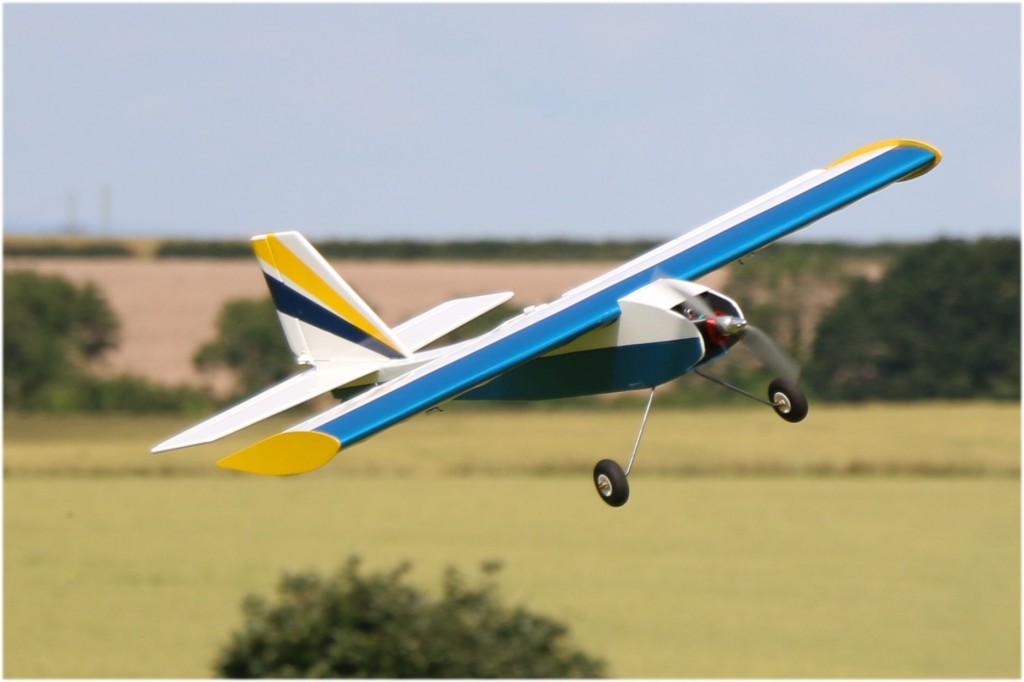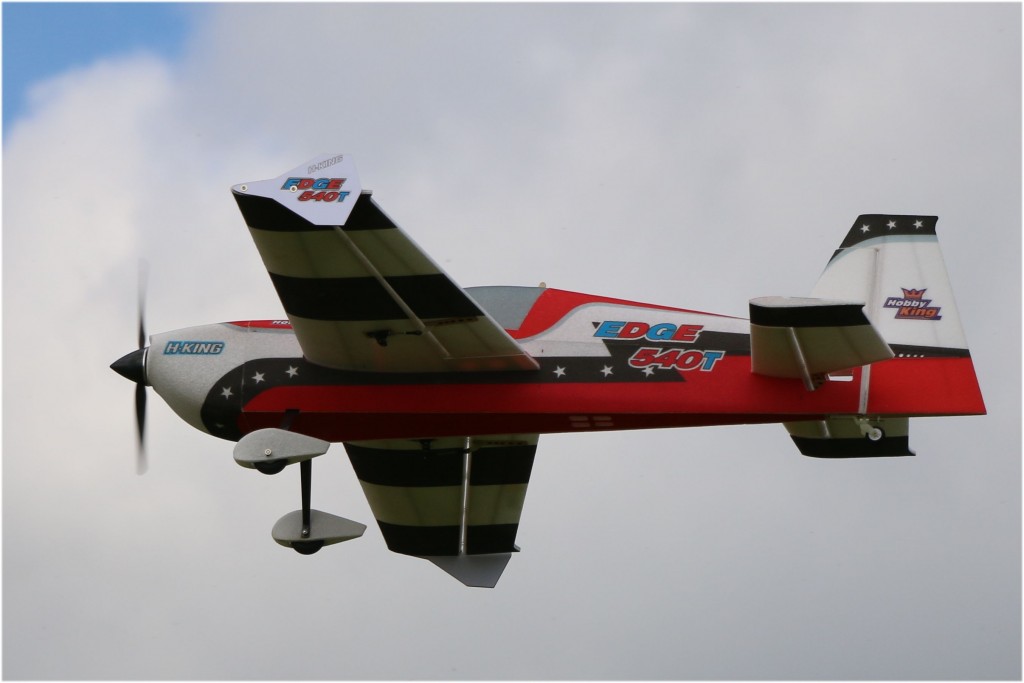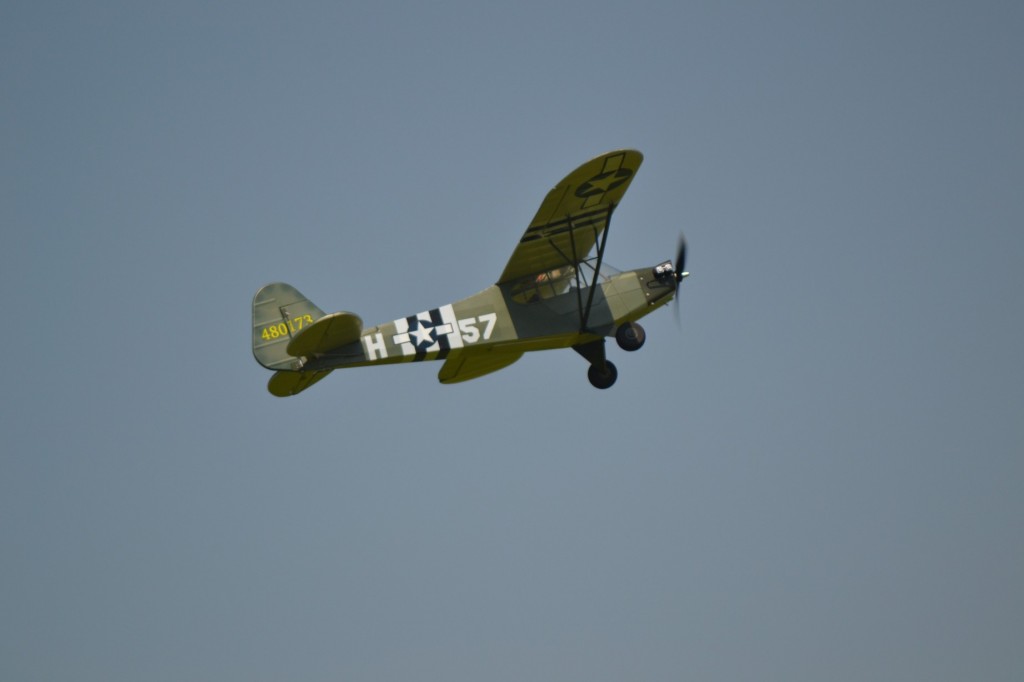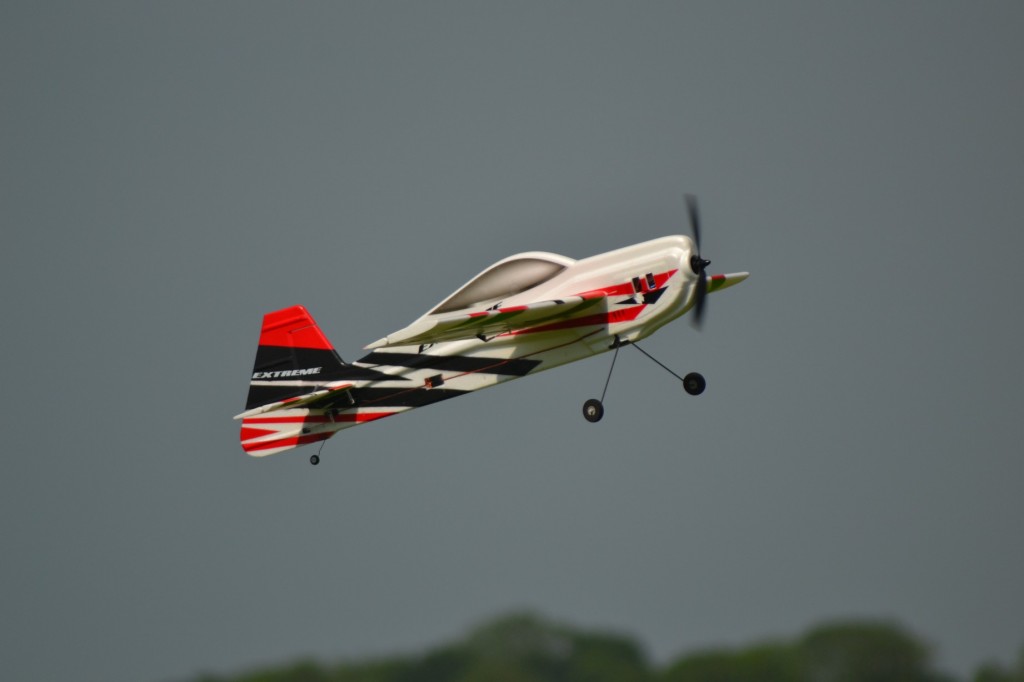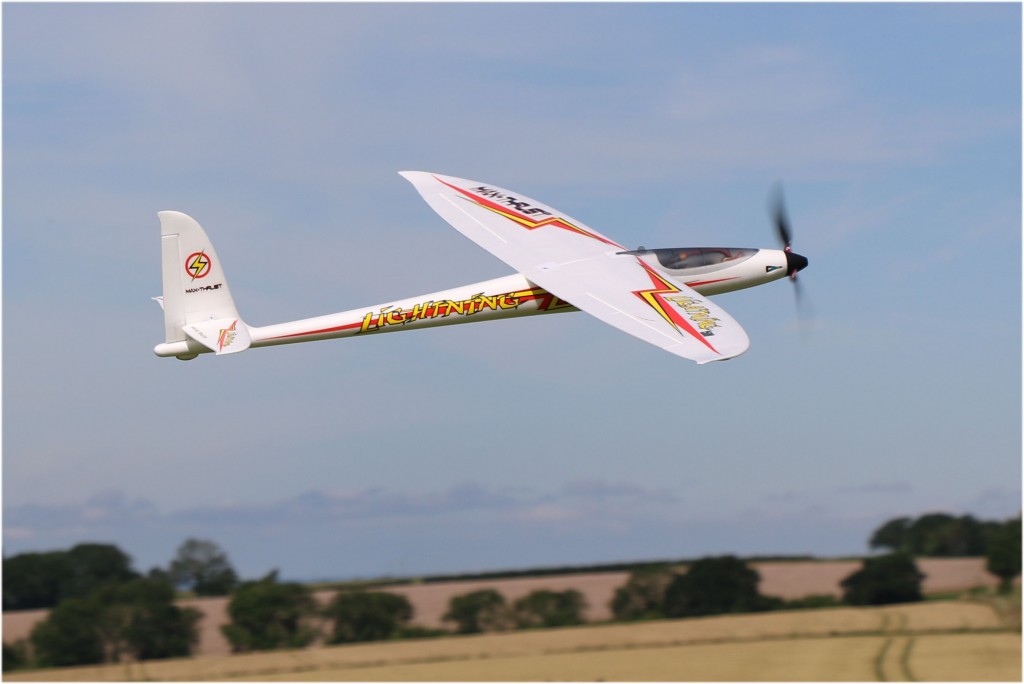Patch News – August 2016
Well the summer has continued to give us some excellent flying weather; in fact some members have been moaning it’s too hot at the field! As predicted last month we have been joined by the bullocks and as a special bonus the sheep are also in the field. The bullocks haven’t given us too much trouble so far and apparently they should be gone in a week or so, hopefully before the patch gets too badly damaged.
The first thing to happen in August was the club barbecue on 31st July… It was too late to report in the July Patch News so I’ve included a short report here now: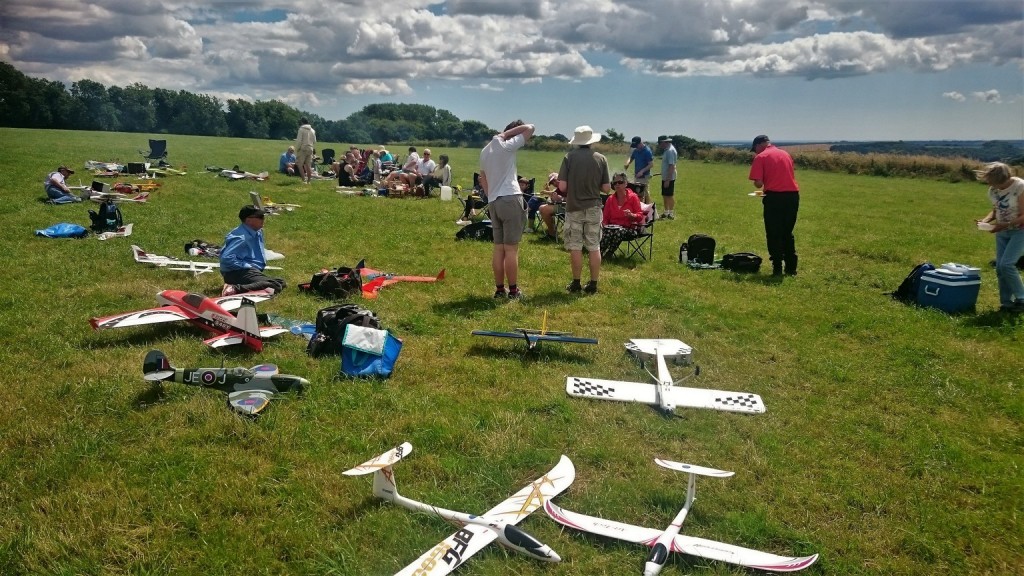 I think everyone enjoyed it, the weather was perfect with just a light westerly breeze, the field had been cut and cleared, and the animals hadn’t yet arrived. Farmer George was good enough to allow us to park in the field which made life much easier for everyone. 1066 brought along the new drum barbecue and loads of charcoal that he had purchased for the club and soon all the men were cooking away for their wives and families. This photo features Colin Cowplain, Mike Creamer, and Wonky Wiltshire cooking while 1066 struggles to unwrap a sandwich.
I think everyone enjoyed it, the weather was perfect with just a light westerly breeze, the field had been cut and cleared, and the animals hadn’t yet arrived. Farmer George was good enough to allow us to park in the field which made life much easier for everyone. 1066 brought along the new drum barbecue and loads of charcoal that he had purchased for the club and soon all the men were cooking away for their wives and families. This photo features Colin Cowplain, Mike Creamer, and Wonky Wiltshire cooking while 1066 struggles to unwrap a sandwich. Mike flew his drone behind the families and flight line and took a few photos and some video, a snippet of which can be seen in this month’s video at the end of this Patch News.
Mike flew his drone behind the families and flight line and took a few photos and some video, a snippet of which can be seen in this month’s video at the end of this Patch News.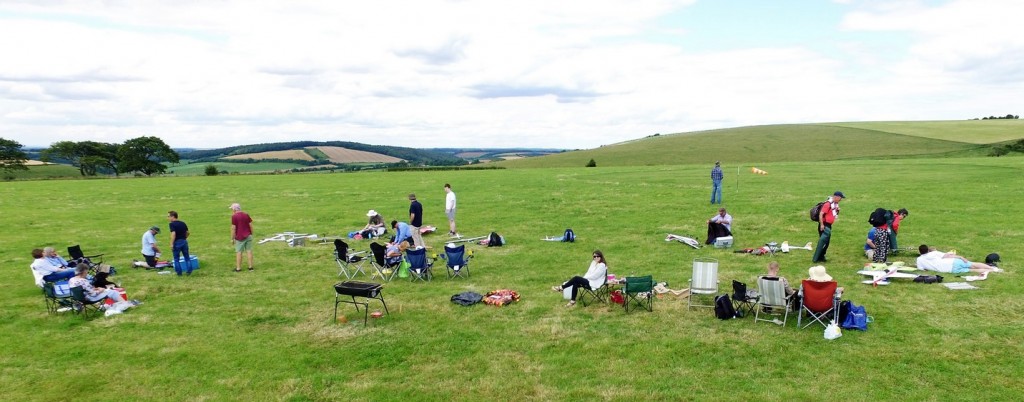 Modelling Clay and Wonky Wiltshire treated us all to a display of what they said was ‘formation flying’ with their EFX Racers and received the usual encouraging shouts of ‘lower, lower’. Always one to please, Modelling duly flew lower and lower until, eventually, the inevitable happened!
Modelling Clay and Wonky Wiltshire treated us all to a display of what they said was ‘formation flying’ with their EFX Racers and received the usual encouraging shouts of ‘lower, lower’. Always one to please, Modelling duly flew lower and lower until, eventually, the inevitable happened!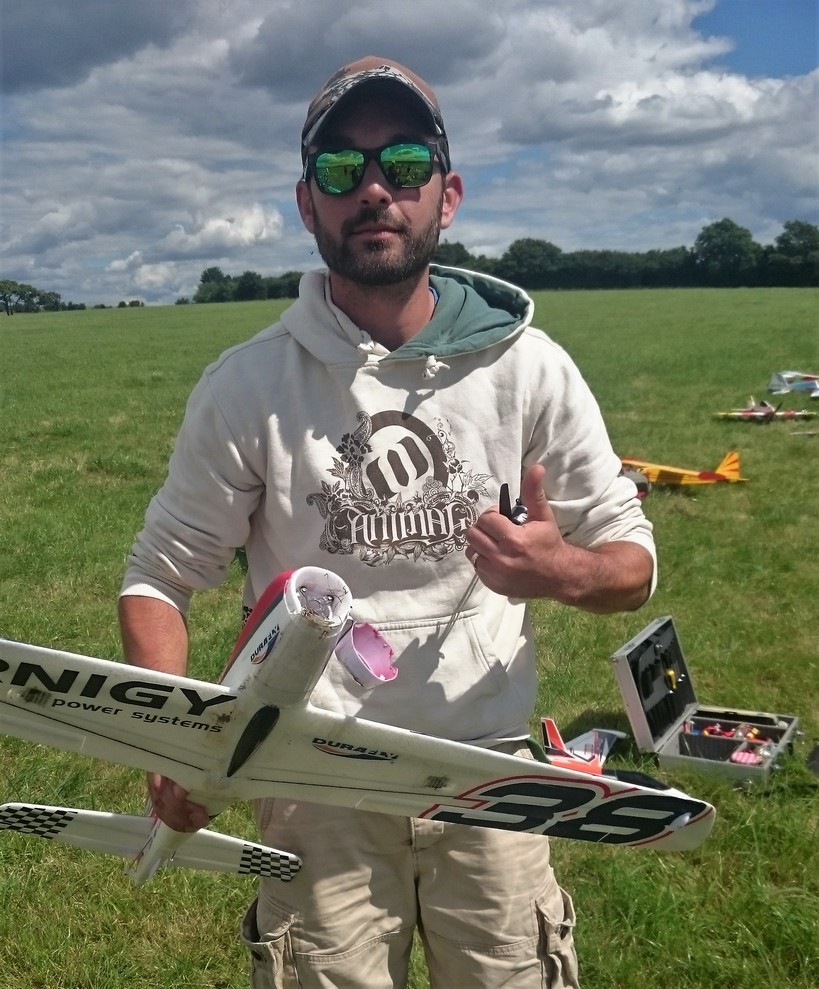 Fortunately the damage was minimal and easily repaired.
Fortunately the damage was minimal and easily repaired.
Another July event that seems to have gone unreported was the annual Chuck Glider competition which was held at Buriton before our mid-July meeting. The club Comp Sec Dwayne Pipe was master of ceremonies and made sure the competitors stuck to the correct flight order and he also timed each flight. There was a pretty good turnout, about ten competitors from memory. Catapult King had a novel biplane chuck glider, something I’ve never seen before. Sadly its performance explained why I’ve not seen one before.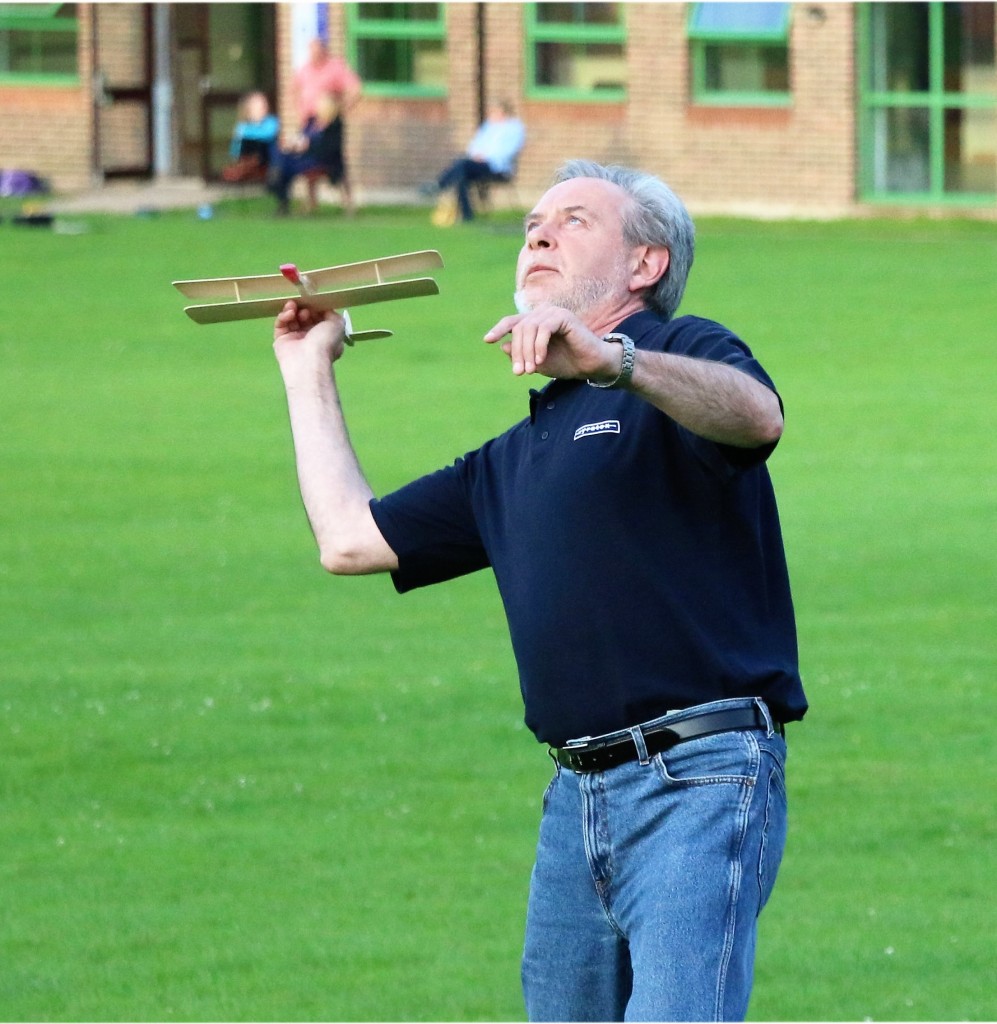 President Don’s ancient model looked like the one to beat, it really is a superb glider, but I think Don’s throwing arm isn’t what it used to be and he couldn’t manage any really long flights.
President Don’s ancient model looked like the one to beat, it really is a superb glider, but I think Don’s throwing arm isn’t what it used to be and he couldn’t manage any really long flights.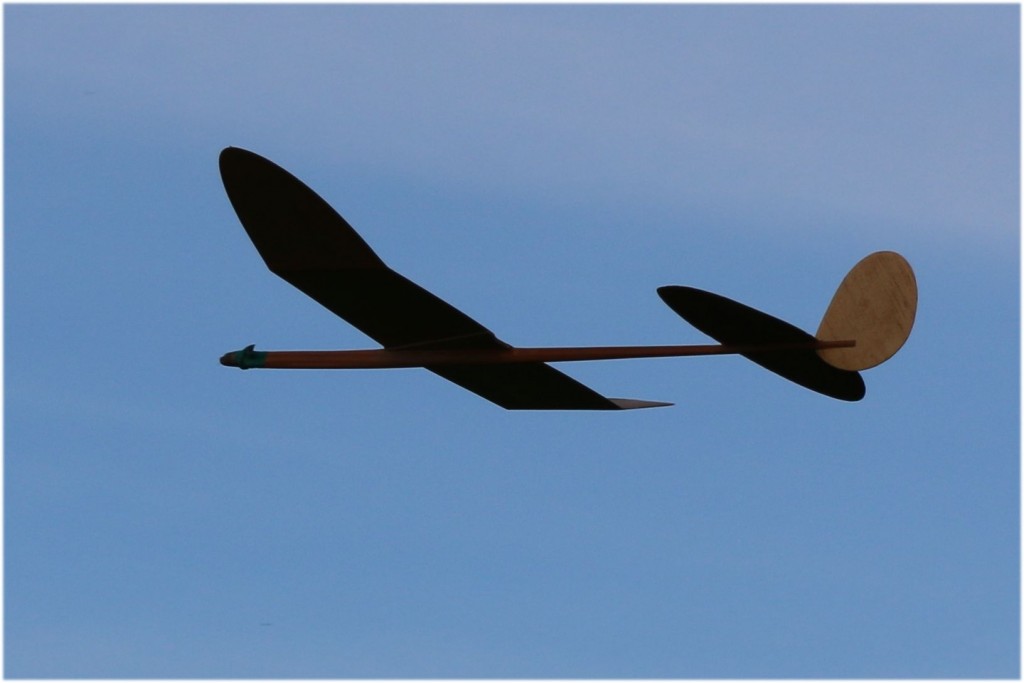 Many of the pilots launched facing downwind…why? I didn’t understand the logic but they continued to do it even after being advised that throwing into the wind had to be better.
Many of the pilots launched facing downwind…why? I didn’t understand the logic but they continued to do it even after being advised that throwing into the wind had to be better.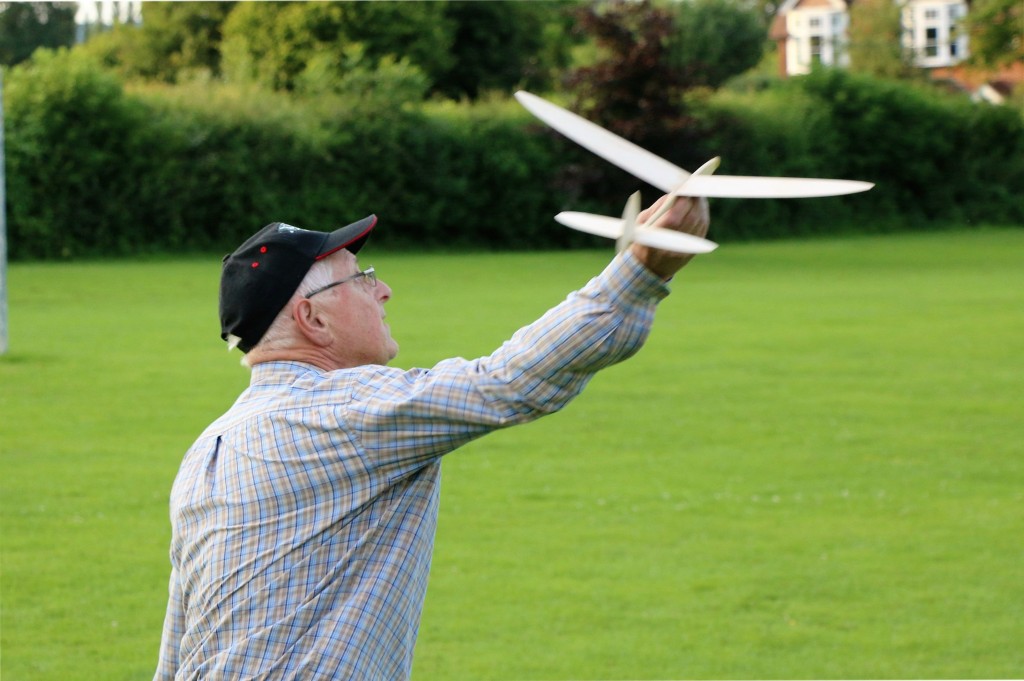

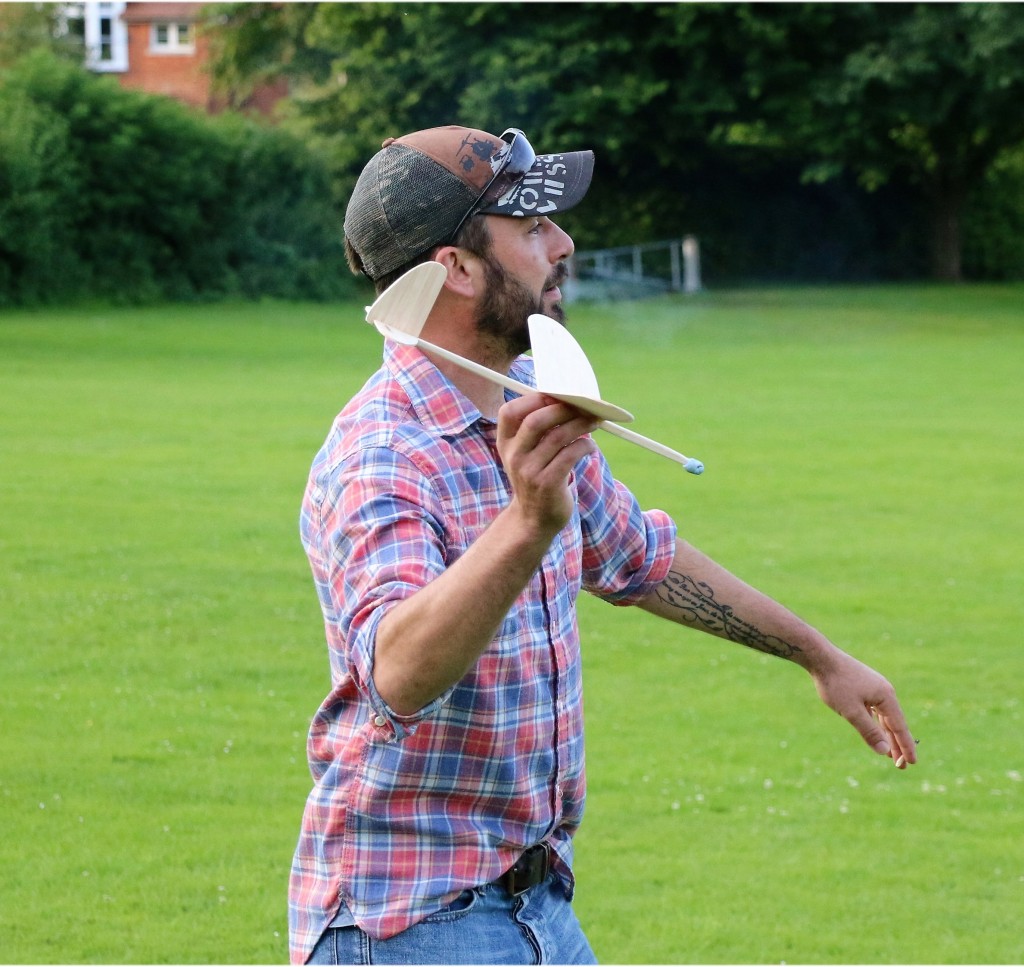
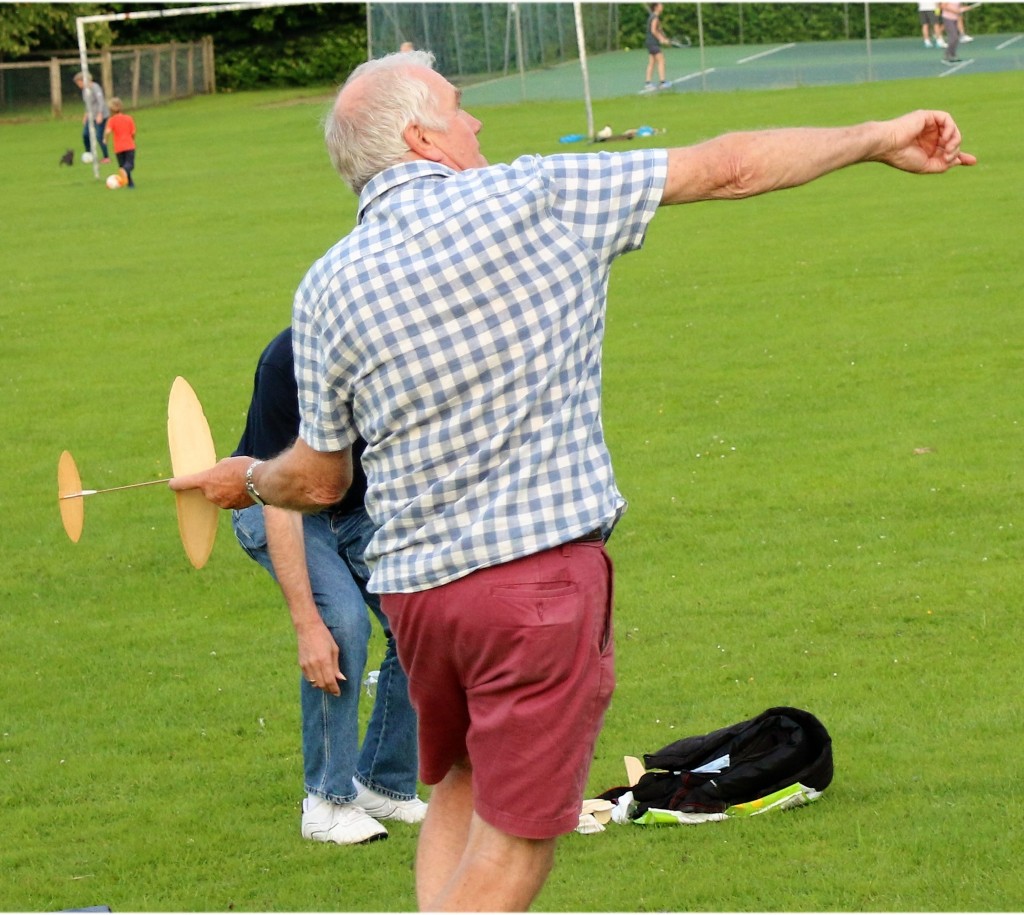 A good time was had by all so thanks go to Dwayne for organising it. Modesty prevents me from naming the eventual winner, I think Don was second, and I’ve no idea who came third. I was too busy throwing and retrieving my chuck glider to take any photos but somebody took some excellent ones, I wonder who! I think it was probably Rusty G (Graham Swan). Anyway thanks to all those who have contributed photos and video for this edition.
A good time was had by all so thanks go to Dwayne for organising it. Modesty prevents me from naming the eventual winner, I think Don was second, and I’ve no idea who came third. I was too busy throwing and retrieving my chuck glider to take any photos but somebody took some excellent ones, I wonder who! I think it was probably Rusty G (Graham Swan). Anyway thanks to all those who have contributed photos and video for this edition.
Woody has finished building his Splot at last and has been happily flying it throughout August. He’s made a great job of his first ever build off a plan, and his covering skills look good too.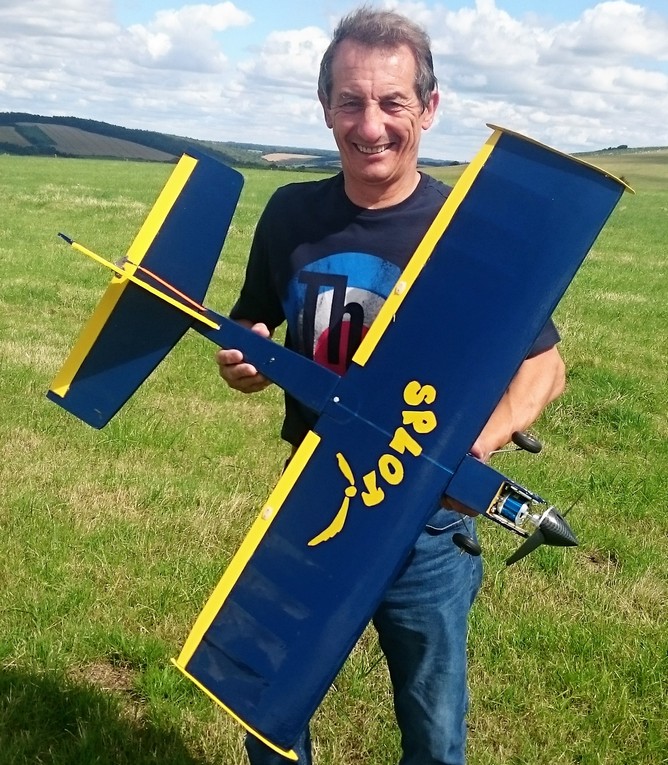
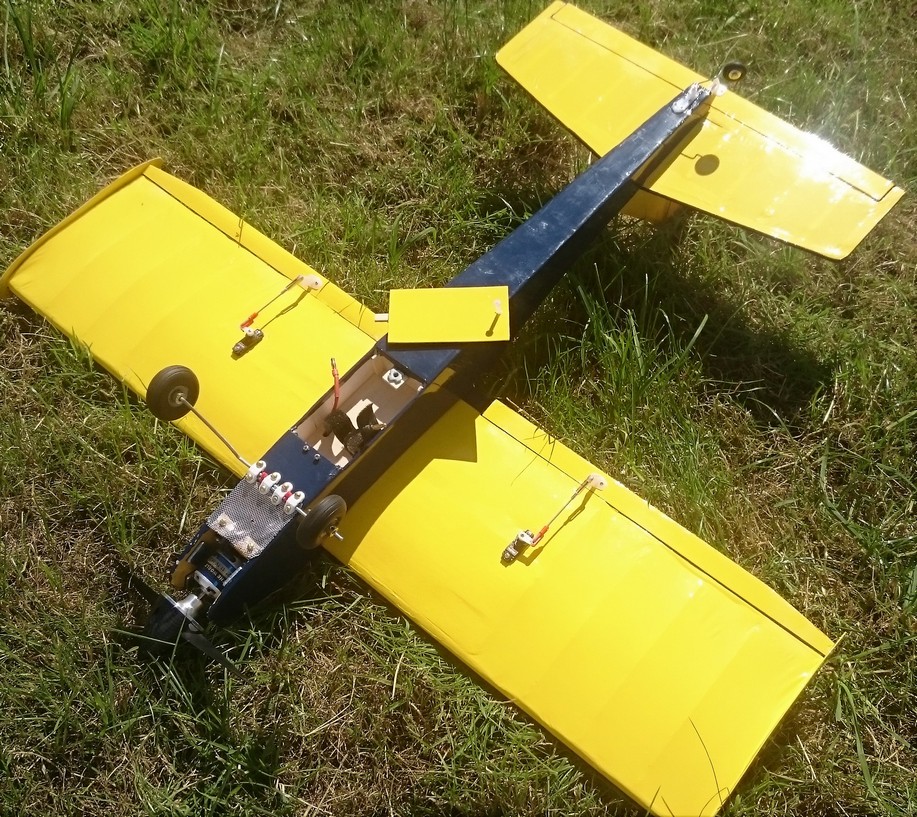 It flies like…well like all the other Splots really. Once he’d got the rates and expo sorted to his liking Woody got very brave and even did some low passes for me to film. A huge step for Captain Altitude!
It flies like…well like all the other Splots really. Once he’d got the rates and expo sorted to his liking Woody got very brave and even did some low passes for me to film. A huge step for Captain Altitude!
The lovely weather brought out lots of electric gliders and Stanley Knife maidened his new Phoenix 2000.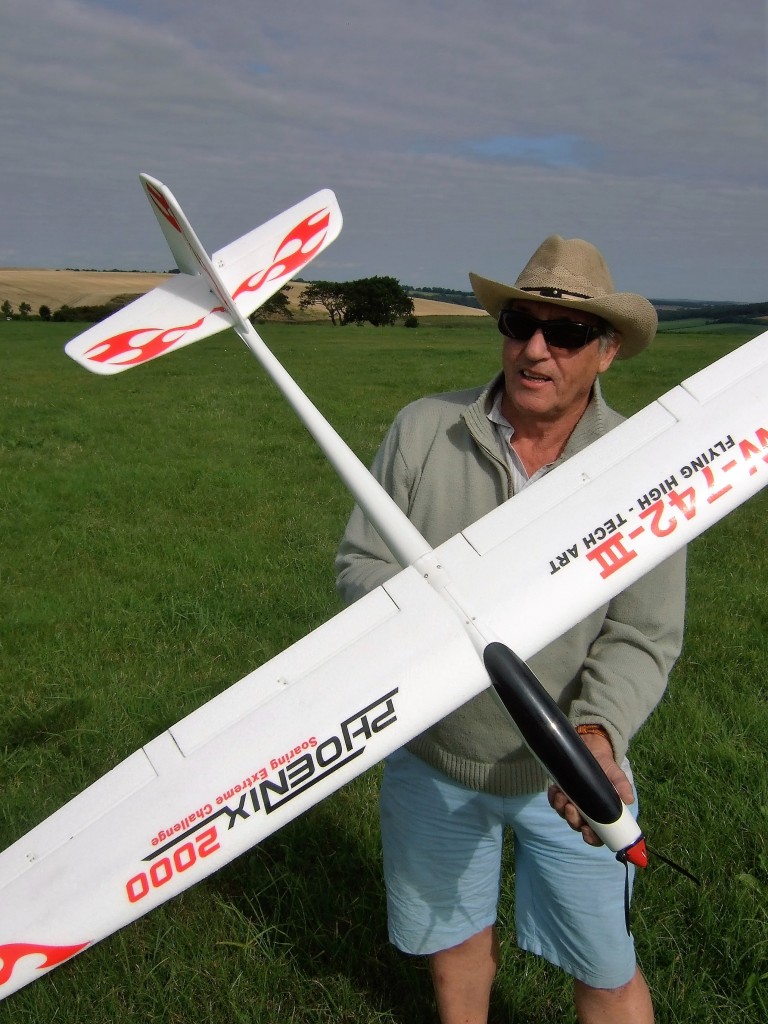 This 2M span Plug’n’Fly glider comes complete, already fitted with 4 x 9gm servos, a 30A speed controller, and a 4010 850kV motor. It flew very nicely with a 3 cell lipo as suggested but next time out Stanley found that the motor had died an early death. He couldn’t find an identical replacement on the HK website so he simply fitted a spare motor he had kicking around and found a suitable folding prop for it. Once again it flew perfectly, just the right amount of power so the replacement motor was obviously a good choice.
This 2M span Plug’n’Fly glider comes complete, already fitted with 4 x 9gm servos, a 30A speed controller, and a 4010 850kV motor. It flew very nicely with a 3 cell lipo as suggested but next time out Stanley found that the motor had died an early death. He couldn’t find an identical replacement on the HK website so he simply fitted a spare motor he had kicking around and found a suitable folding prop for it. Once again it flew perfectly, just the right amount of power so the replacement motor was obviously a good choice.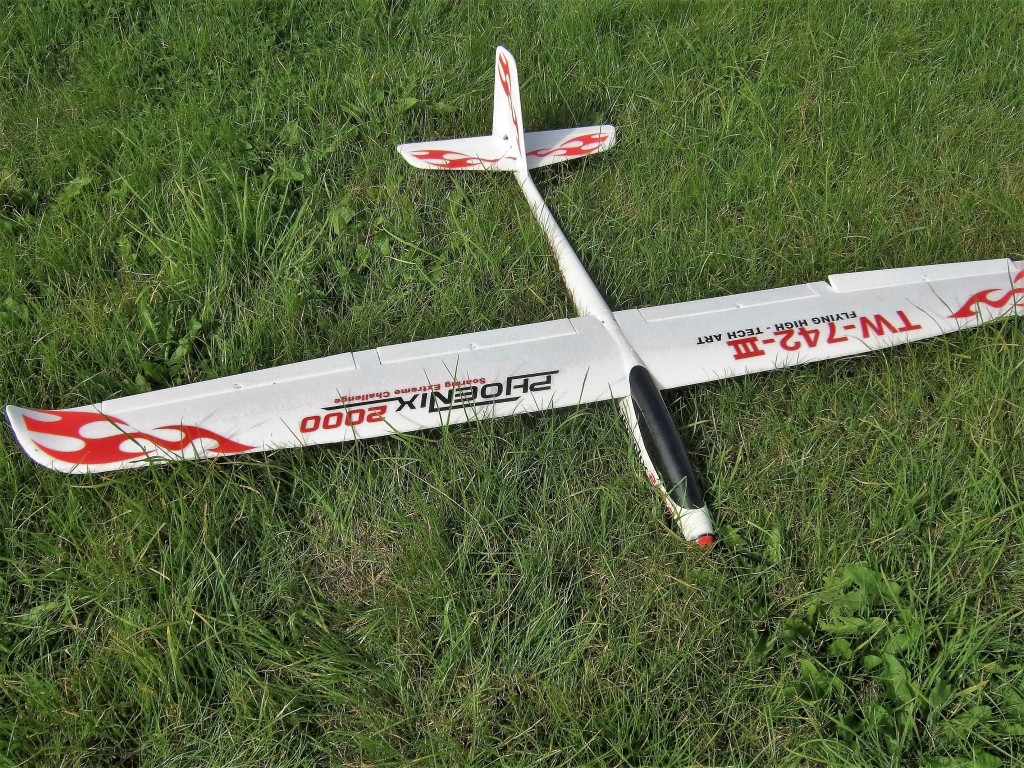 The Phoenix is fairly unusual in that it has a blown nylon fuselage fitted with plywood formers, although the wings and tail are made from the more common EPO foam. It doesn’t come with working flaps but they are moulded in so if you require them it’s just a case of fitting a couple of servos and suitable linkages.
The Phoenix is fairly unusual in that it has a blown nylon fuselage fitted with plywood formers, although the wings and tail are made from the more common EPO foam. It doesn’t come with working flaps but they are moulded in so if you require them it’s just a case of fitting a couple of servos and suitable linkages.
Jeremy Stuttard came along one midweek day to test fly his new E-Flite Radian XL.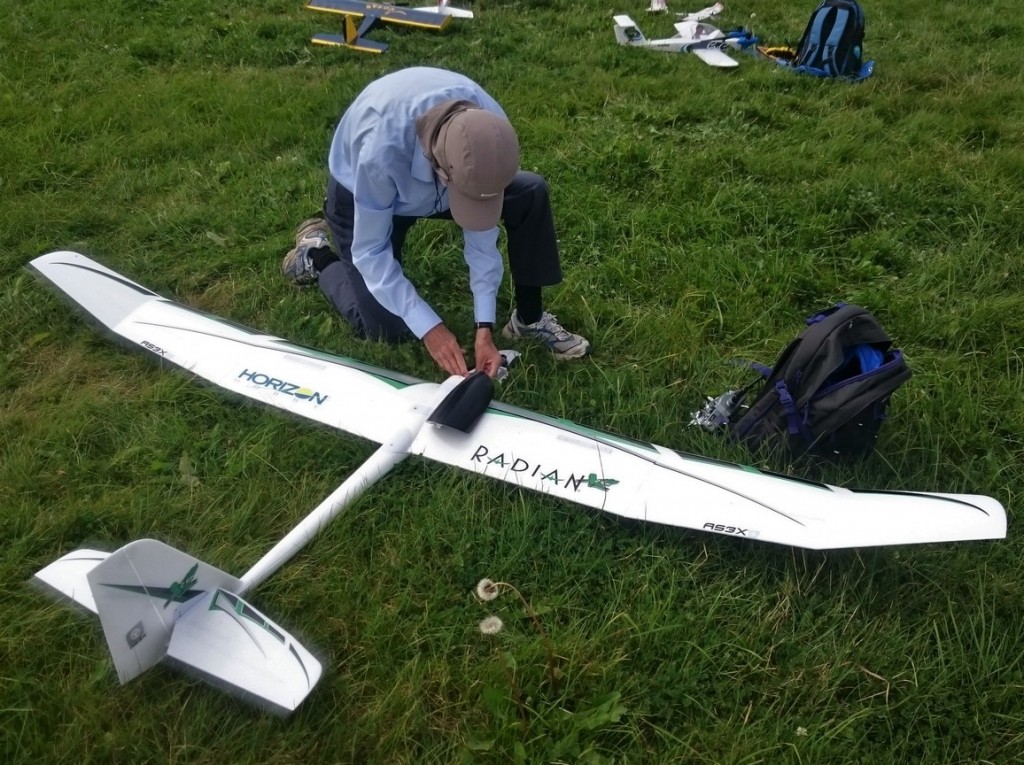 The Radian is available in a variety of sizes, the XL being 2.6M span. That’s 102”, so fairly large. It comes as a Bind’n’Fly model, being already fitted with a Spektrum AS3X receiver. That means it has a built in gyro for super stable flight. The model is rudder/elevator, no ailerons, but it does have pre-fitted spoilers so getting it down shouldn’t be a problem. I launched it for Jeremy’s first flight and it felt heavy but it flew away beautifully and looked mightily impressive stooging around in the light wind we had that day.
The Radian is available in a variety of sizes, the XL being 2.6M span. That’s 102”, so fairly large. It comes as a Bind’n’Fly model, being already fitted with a Spektrum AS3X receiver. That means it has a built in gyro for super stable flight. The model is rudder/elevator, no ailerons, but it does have pre-fitted spoilers so getting it down shouldn’t be a problem. I launched it for Jeremy’s first flight and it felt heavy but it flew away beautifully and looked mightily impressive stooging around in the light wind we had that day.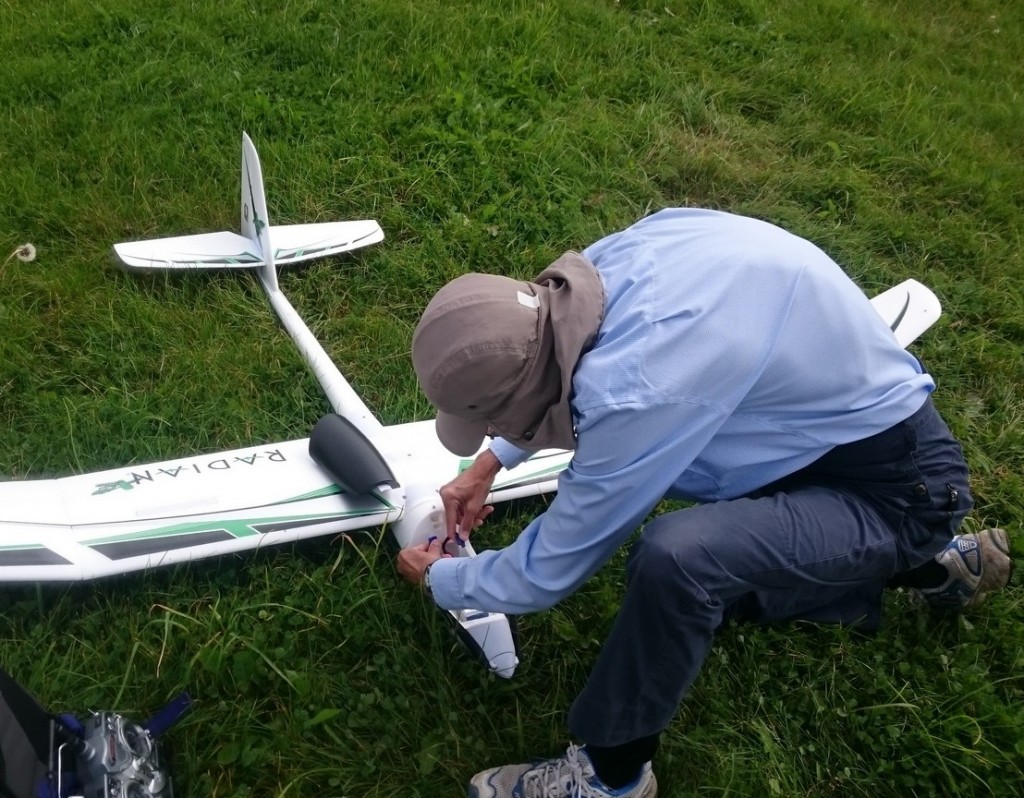 I recorded some video which you can see in this month’s video, including a brilliant low pass, but Jeremy was still enjoying that long first flight when I had to leave to I didn’t get to see the landing.
I recorded some video which you can see in this month’s video, including a brilliant low pass, but Jeremy was still enjoying that long first flight when I had to leave to I didn’t get to see the landing.
New member Terry Paget has been flying with PAM for a few months now and has been working towards his ‘A’ certificate so that he’s able to fly without a suitably qualified pilot stood next to him. I’m pleased to report that Examiner Dougal Entendre took and passed Terry during August and he received his new certificate at the last club meeting. Congratulations Terry.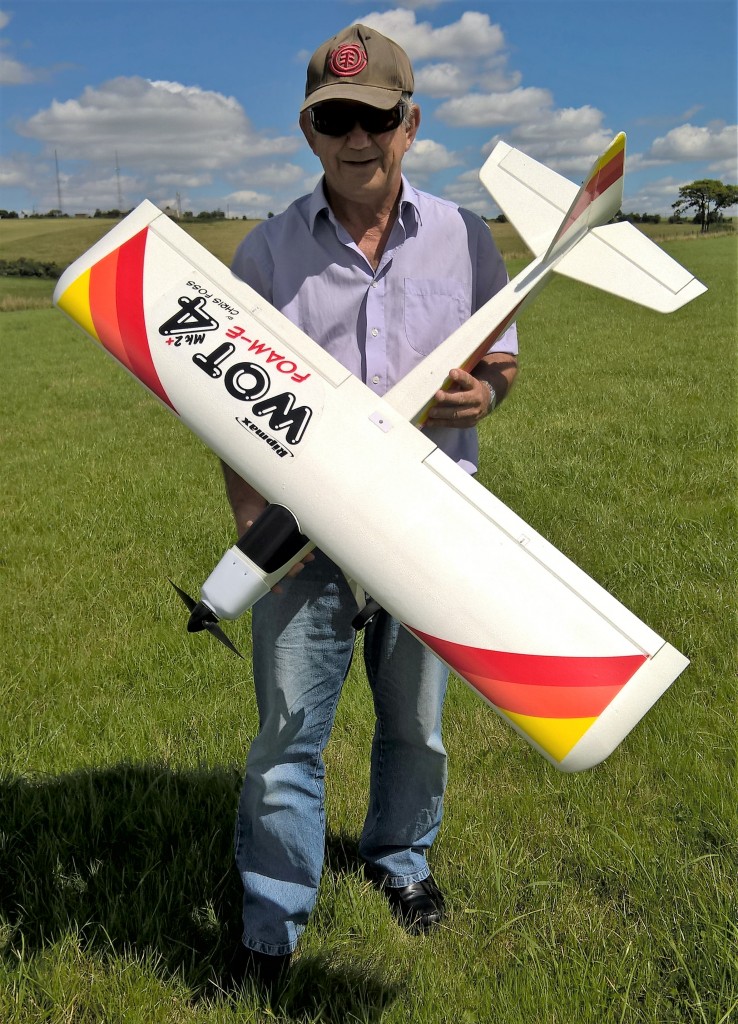 The subject of nicknames arose recently and, as Terry isn’t exactly known for ever being short of something to say, some unkind person suggested Terribull. Sounds absolutely perfect on so many fronts to me!
The subject of nicknames arose recently and, as Terry isn’t exactly known for ever being short of something to say, some unkind person suggested Terribull. Sounds absolutely perfect on so many fronts to me!
Terribull passed the test flying his WOT4 Foam-E but manged to bury it shortly afterwards when flying with the Firebirds club, so more recently he’s been flying his Weekender, a 31” span model designed by Dave Hughes back in 1966, the days of single channel radio and Cox 049 glow-plug motors.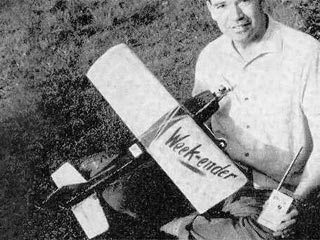
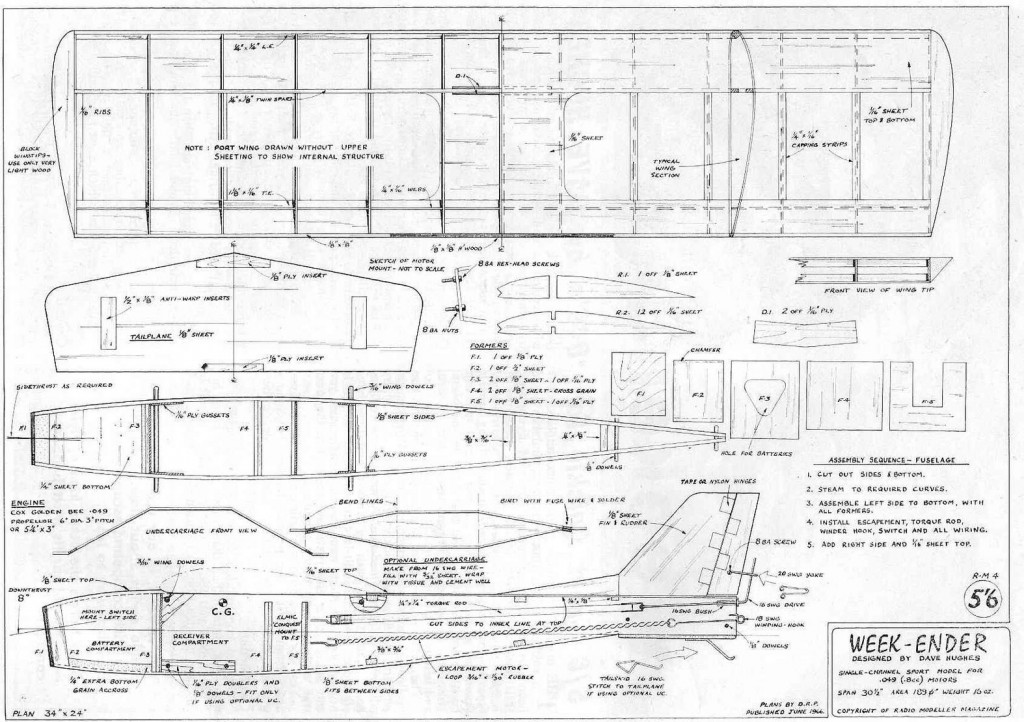
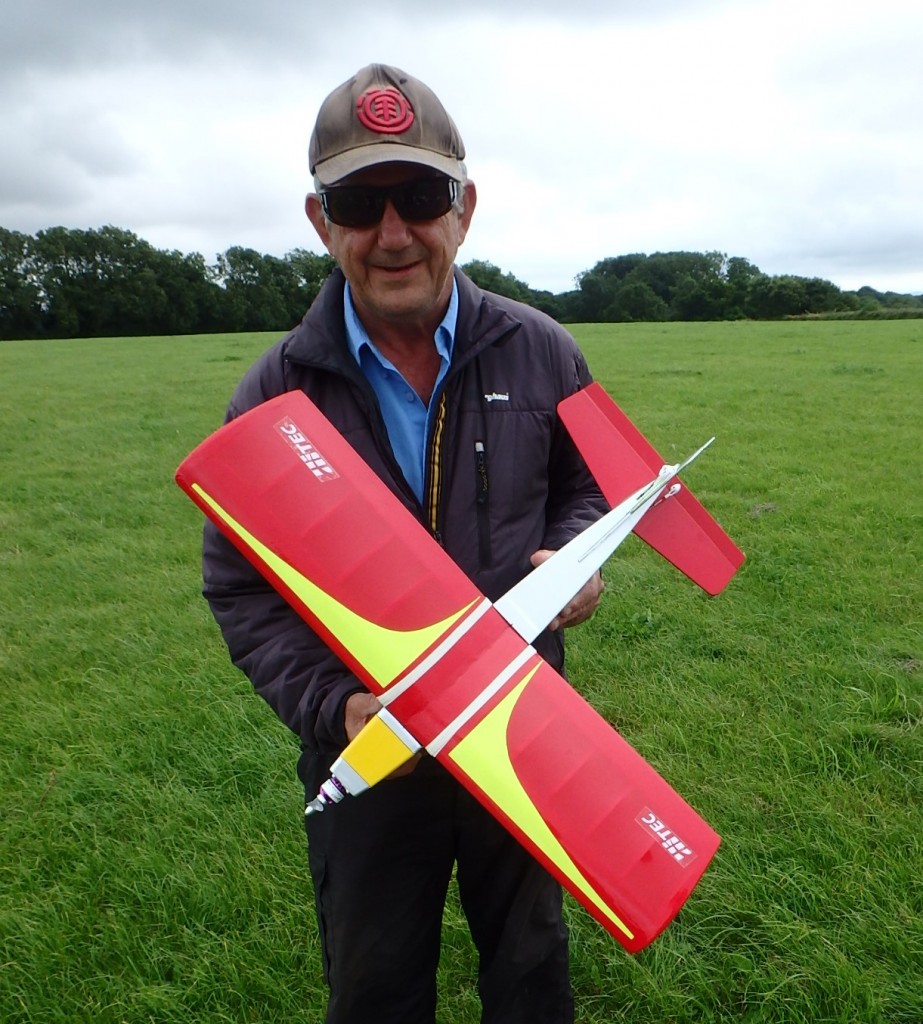 Terribull has adapted it for rudder/elevator control and fitted a Purple Power 2827 1350kV motor from 4-Max, coupled to a 20A Overlander speed controller. He uses a 1300mAh 3 cell lipo pack which gives good long flight times. There’s more than enough room inside for the radio gear.
Terribull has adapted it for rudder/elevator control and fitted a Purple Power 2827 1350kV motor from 4-Max, coupled to a 20A Overlander speed controller. He uses a 1300mAh 3 cell lipo pack which gives good long flight times. There’s more than enough room inside for the radio gear.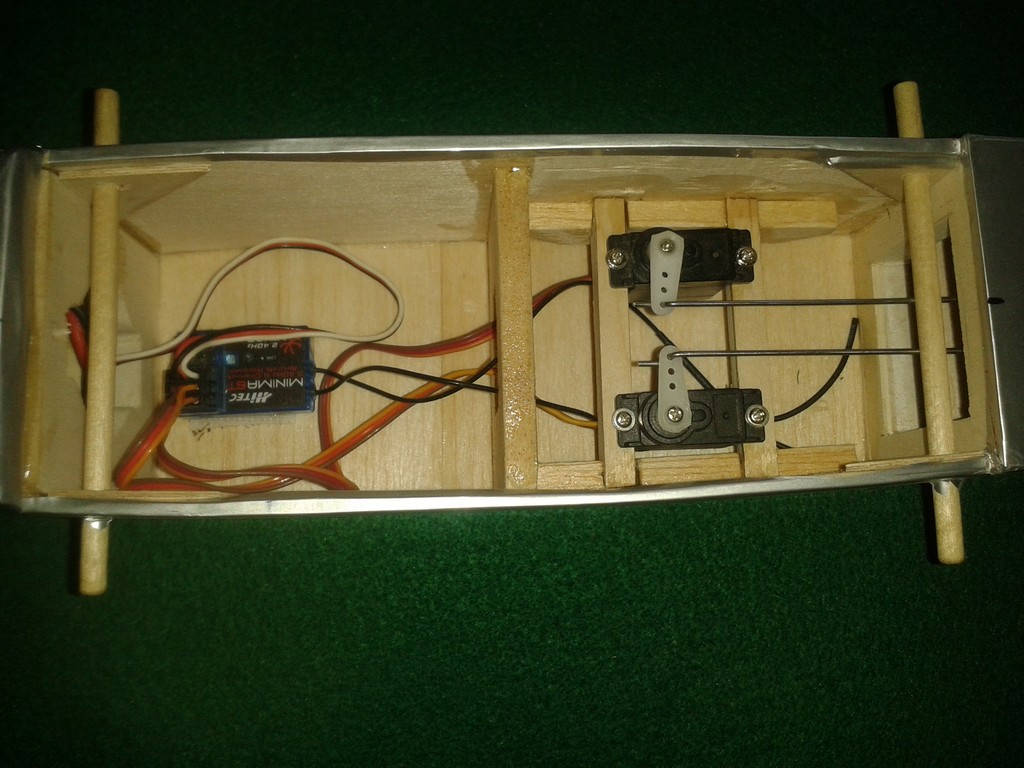 I’ve had a flight with the Weekender and it’s as aerobatic as can be expected of a 3 channel model and very well behaved. Terribull is now building a larger version with ailerons and no dihedral. I wonder if the larger one will be called Long Weekend…
I’ve had a flight with the Weekender and it’s as aerobatic as can be expected of a 3 channel model and very well behaved. Terribull is now building a larger version with ailerons and no dihedral. I wonder if the larger one will be called Long Weekend…
Dougal send me through a photo of 1066 prop hanging his Hummer. Note the body language, the tightly clenched buttocks, leaning the way he wants the model to go, the tightly clenched buttocks, you can almost feel him squeezing the transmitter as he angles it round to the right, the tightly clenched buttocks…!
Norwegian Nick brought along his beautifully finished ME163 Komet for another try after it had previously failed to get away from a hand-launch despite a really strong heave.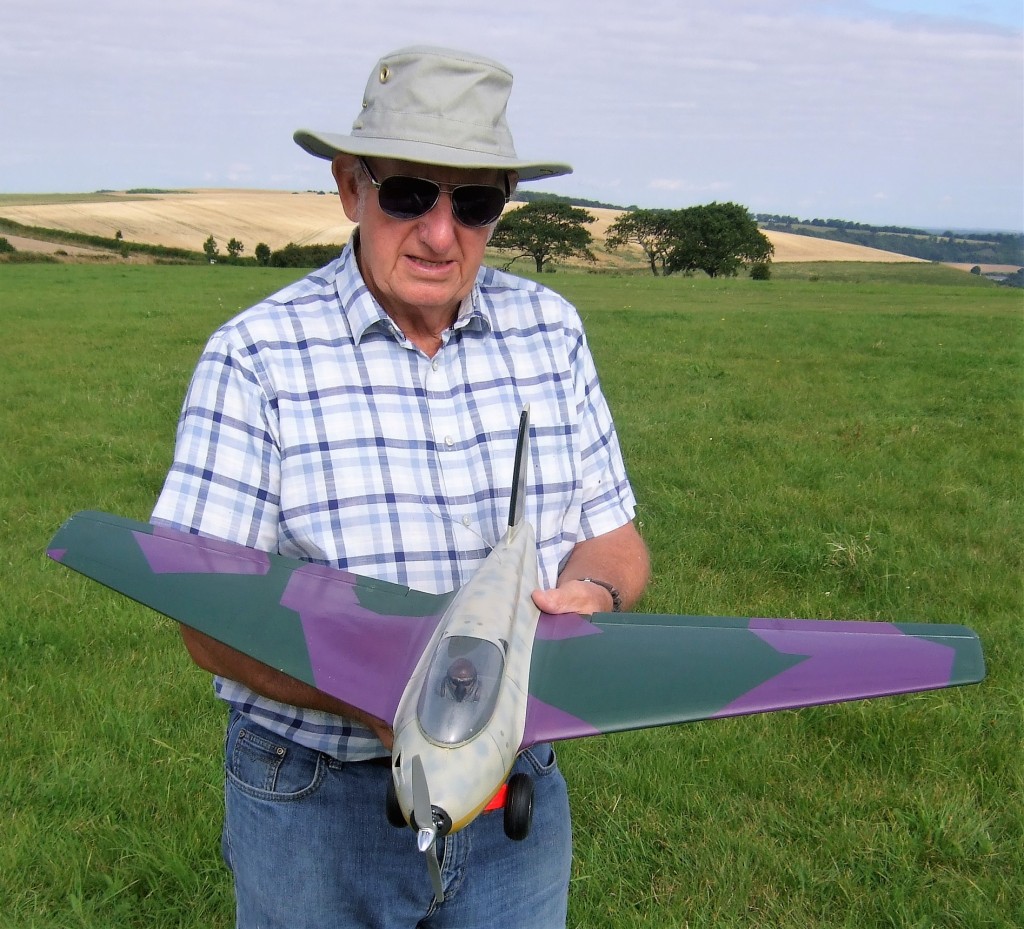 This time Nick had added a detachable dolly in the hope that it would be able to get off the patch. The model was built from the Cloud Models kit and features a fibreglass fuselage which makes for a lovely model but unfortunately it also makes it rather heavy.
This time Nick had added a detachable dolly in the hope that it would be able to get off the patch. The model was built from the Cloud Models kit and features a fibreglass fuselage which makes for a lovely model but unfortunately it also makes it rather heavy.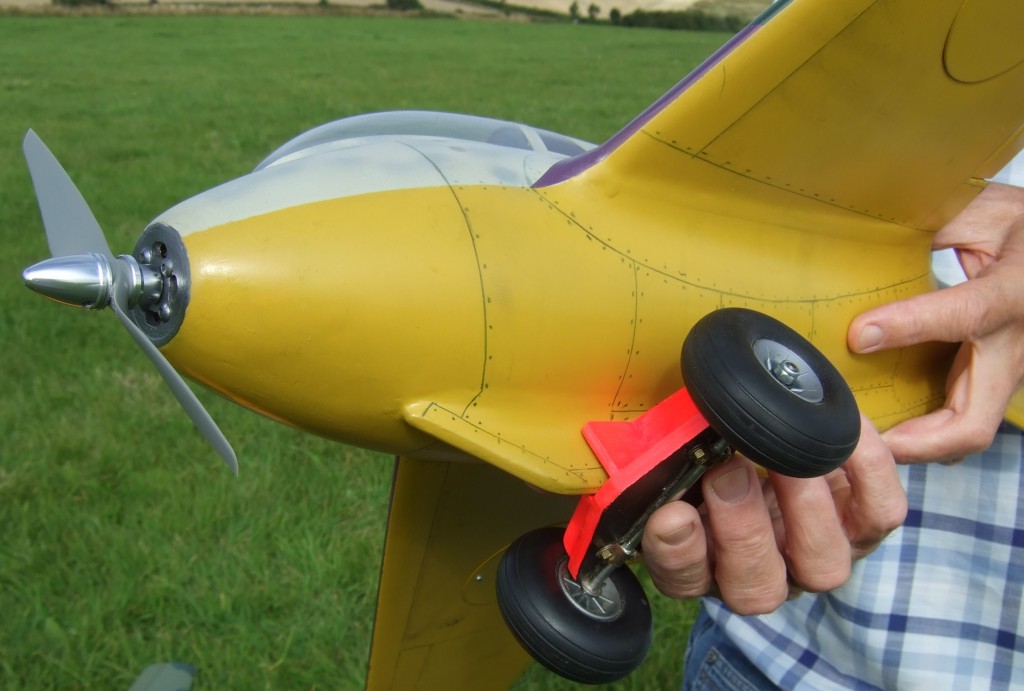 Despite various attempts to reach reasonable speed across the patch the Komet failed to get airborne so Nick has gone away to think of something else to try. I reckon it would go fine from a tarmac runway, and maybe from a longer grass one than we have at our field.
Despite various attempts to reach reasonable speed across the patch the Komet failed to get airborne so Nick has gone away to think of something else to try. I reckon it would go fine from a tarmac runway, and maybe from a longer grass one than we have at our field.
Chris Hard flew on several occasions this month and flew a couple of models we haven’t seen for a while.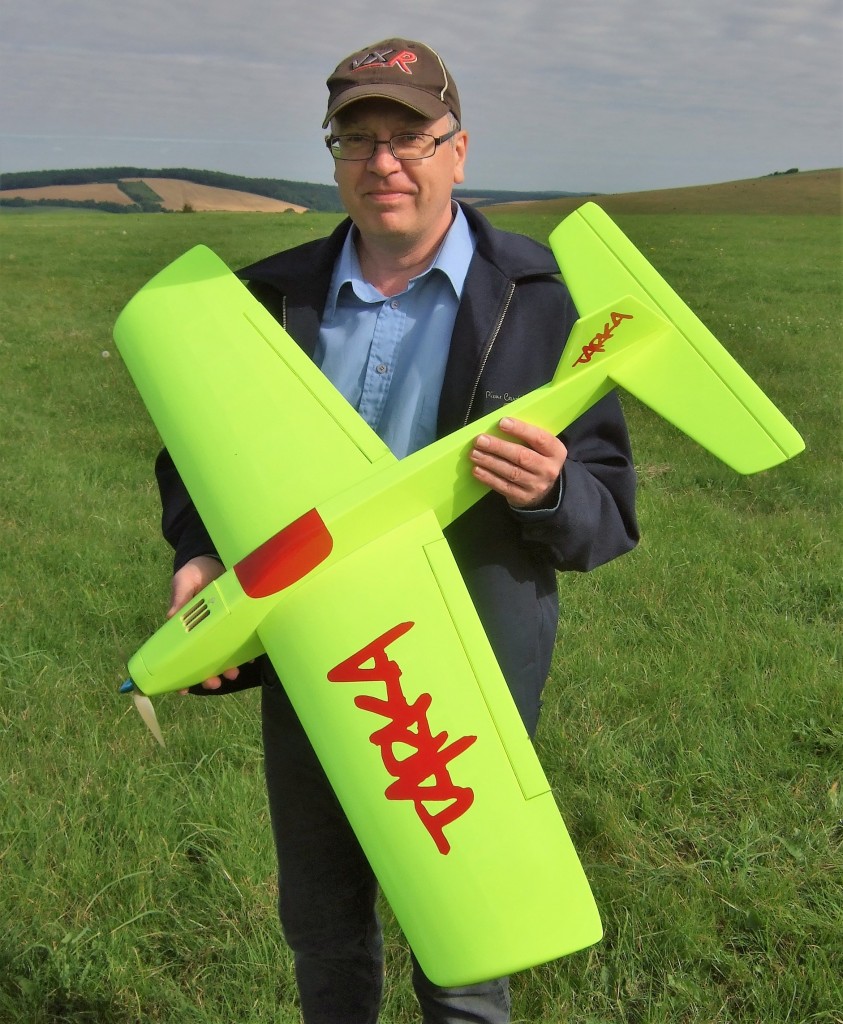 The first one was his Tarka, a model originally designed by Dave Boddington for Club 20 racing, so named because the models all had to use 0.20 cu inch sized I/C engines (just over 3cc). Chris’s Tarka uses electric power of course but I’m afraid I didn’t record which motor etc. Chris used.
The first one was his Tarka, a model originally designed by Dave Boddington for Club 20 racing, so named because the models all had to use 0.20 cu inch sized I/C engines (just over 3cc). Chris’s Tarka uses electric power of course but I’m afraid I didn’t record which motor etc. Chris used.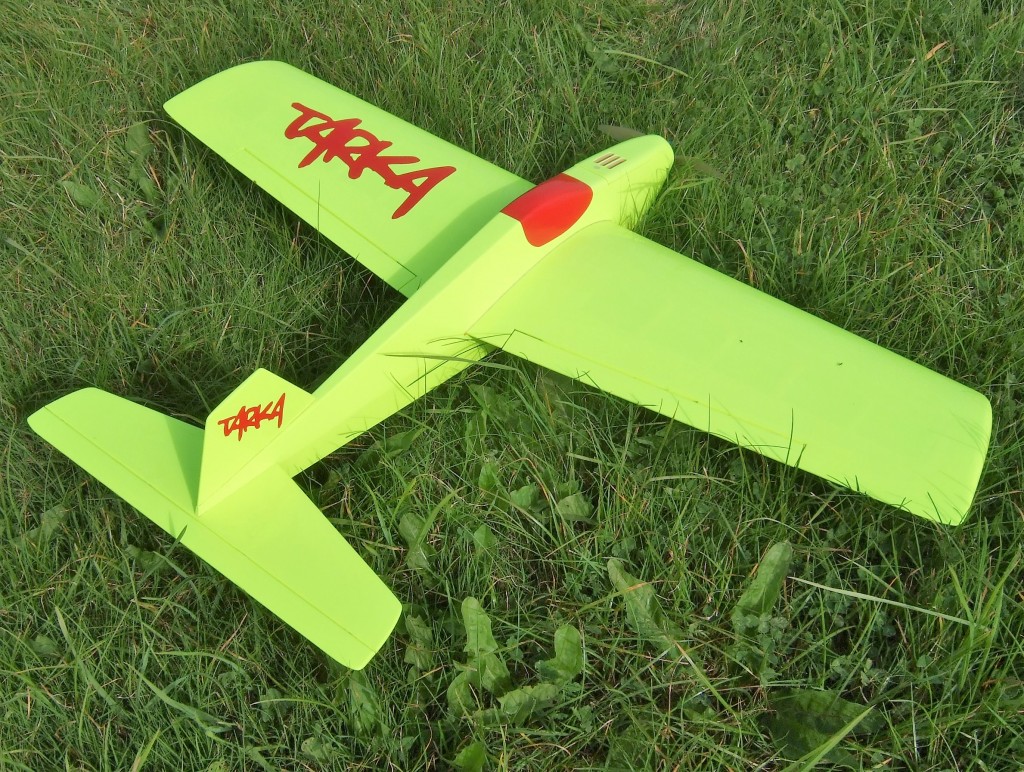 The Tarka flies well, fast but not ridiculously so, and is fully aerobatic. The second model Chris flew was his Radjet 400 which I’ve featured previously. Chris owns both this 400 version and the larger 800 version. They both fly well, but the small one is quite a hairy little bugger and it’s not something for the faint-hearted or the short-sighted, it disappears very rapidly if you’re not very careful!
The Tarka flies well, fast but not ridiculously so, and is fully aerobatic. The second model Chris flew was his Radjet 400 which I’ve featured previously. Chris owns both this 400 version and the larger 800 version. They both fly well, but the small one is quite a hairy little bugger and it’s not something for the faint-hearted or the short-sighted, it disappears very rapidly if you’re not very careful!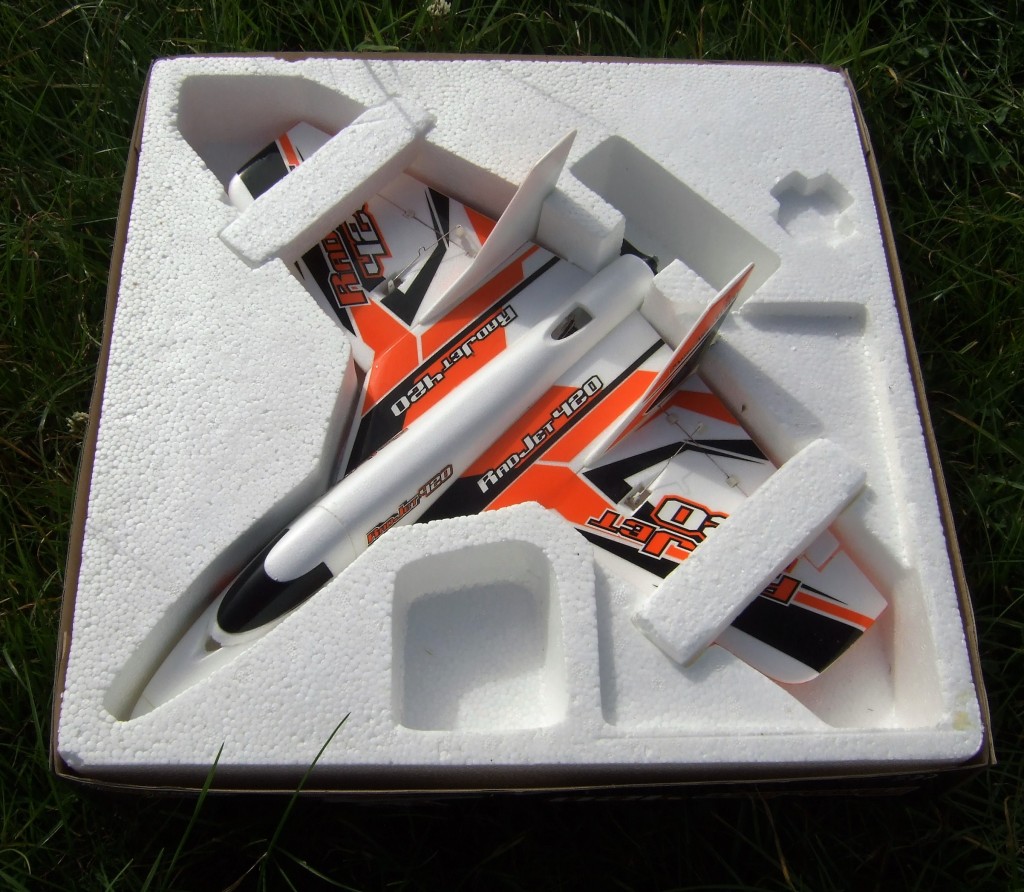 Every time Chris brings it along it makes me laugh, it just looks as if he’s bringing a pizza for his lunch!
Every time Chris brings it along it makes me laugh, it just looks as if he’s bringing a pizza for his lunch!
Back now to Modelling Clay; one Sunday he made the fatal mistake of saying he’d have ‘one last flight’ and promptly had an aileron servo fail in his WOT4 Foam-E. The damage looks pretty terminal to me and I doubt it will be repaired. A sad end but it had served him well.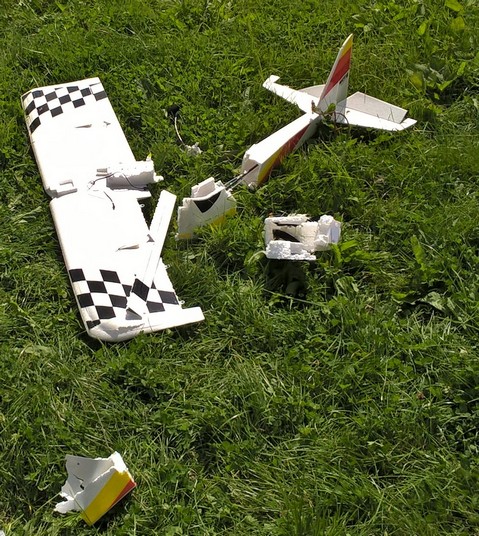
Many of you will have seen Modelling’s new Acro Wot when he gave a presentation at a recent club meeting. The presentation covered the trials and tribulations of his first covering and spray job. The model is built from a Chris Foss wood kit, rather than one of the foam ones, and Modelling chose to do the electric version.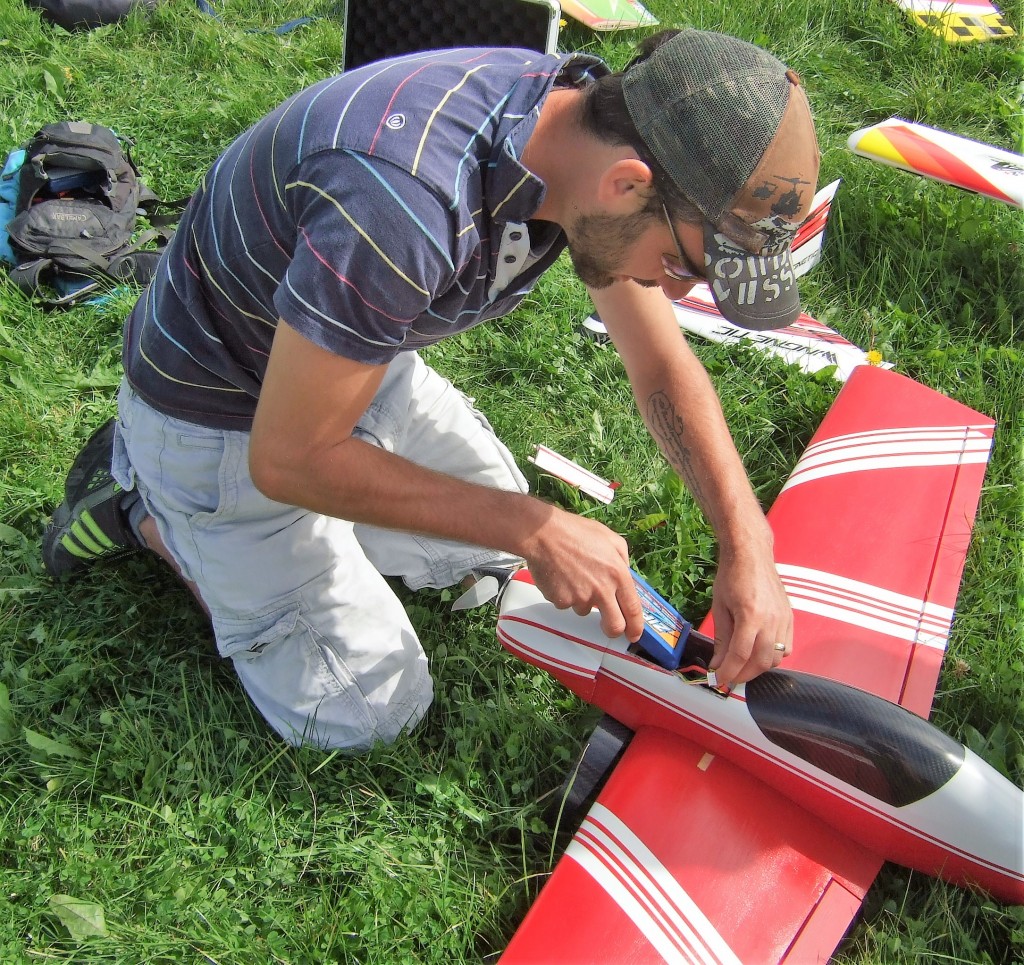 As far as I could see the only difference between the old original I/C version and this one is that it has a battery hatch at the front.
As far as I could see the only difference between the old original I/C version and this one is that it has a battery hatch at the front.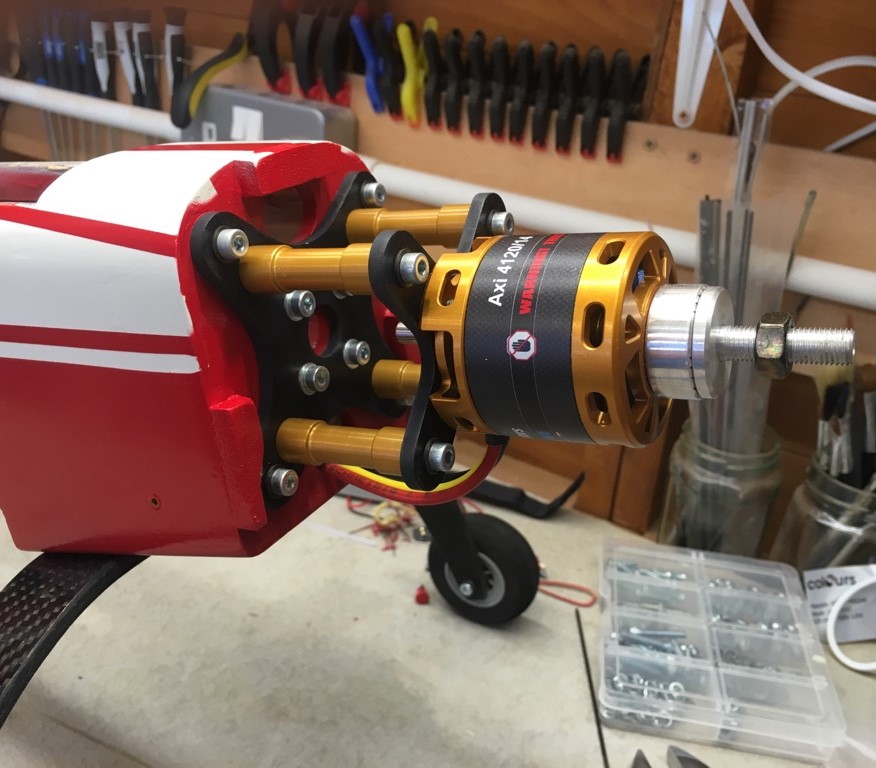 He has fitted an AXI 4120/14 V2 motor fitted with a 13 x 8 prop and coupled to a Jeti 70A speed controller with a switching BEC. He uses a 4 cell 4000mAh lipo rated at 25C. The servos are Hitec HS82MG and he splashed out on a Carbon Copy canopy and undercarriage. Modelling has made a lovely job of the glass-cloth covering and spray job.
He has fitted an AXI 4120/14 V2 motor fitted with a 13 x 8 prop and coupled to a Jeti 70A speed controller with a switching BEC. He uses a 4 cell 4000mAh lipo rated at 25C. The servos are Hitec HS82MG and he splashed out on a Carbon Copy canopy and undercarriage. Modelling has made a lovely job of the glass-cloth covering and spray job.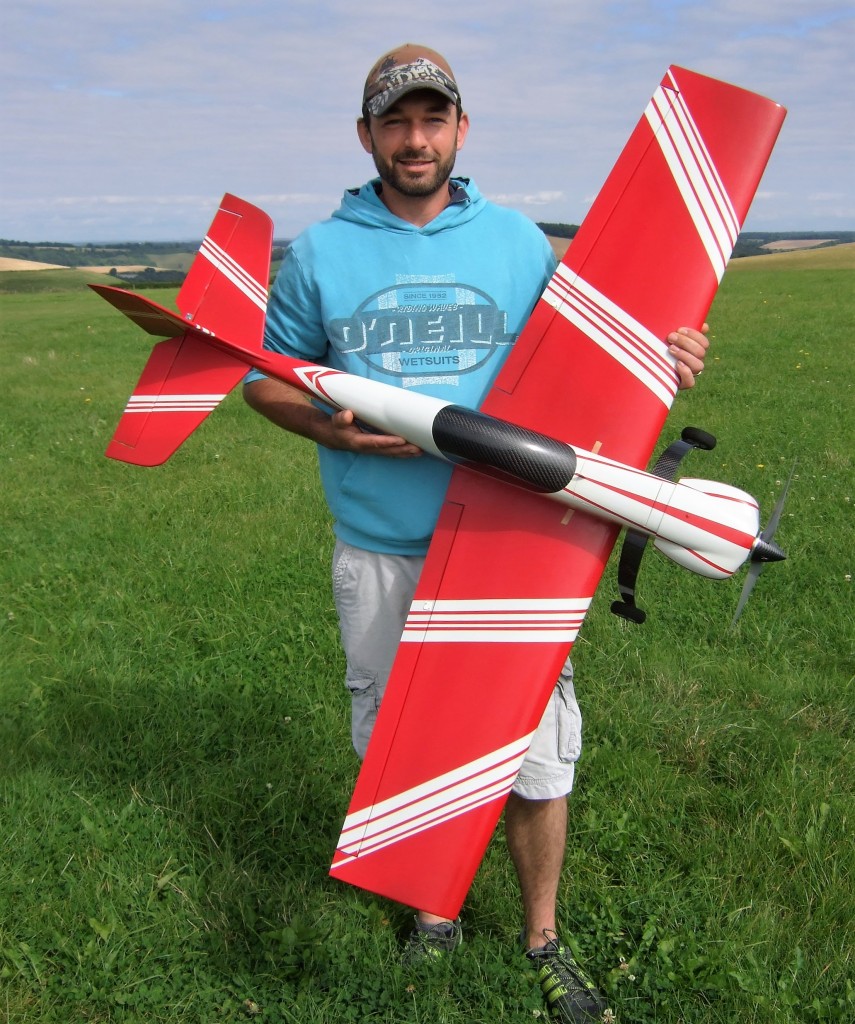
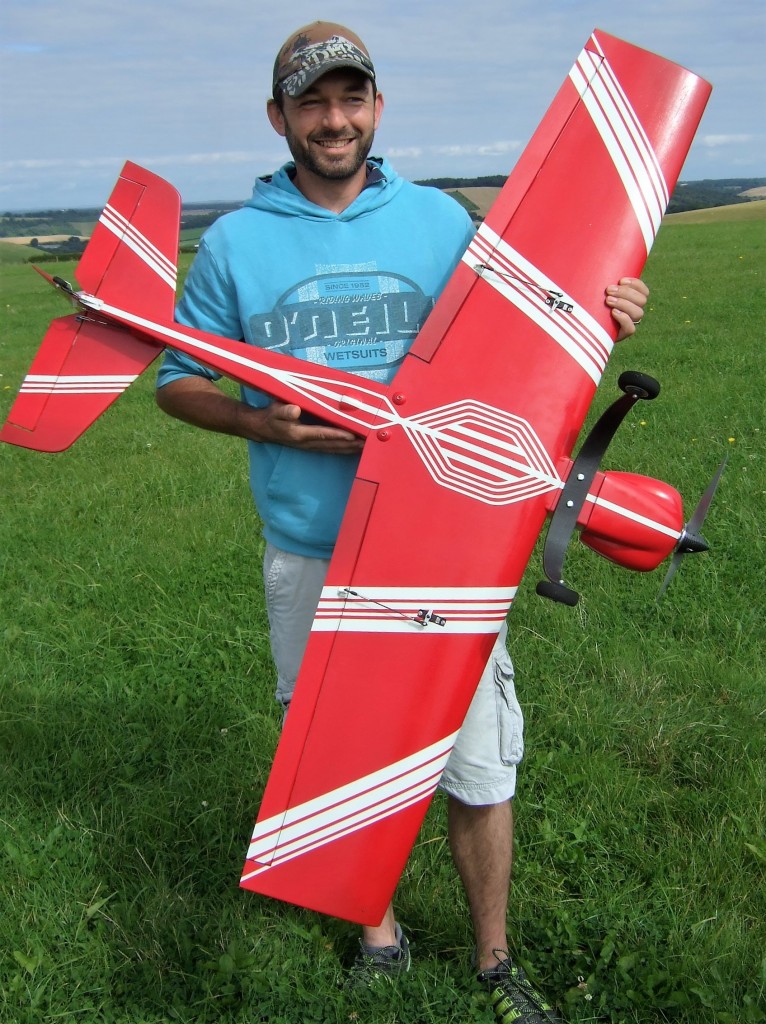 He didn’t make it easy for himself as he designed a scheme that included lots of pin stripes, particularly on the underside of the wing centre. 1066 talked Modelling into doing the first flight himself (I think 1066 was too scared to do it!) and the plane flew perfectly, as if it was on rails. Acro Wots are known for being a bit tricky to get down on our patch as they tend to float on and on but Modelling even did a lovely landing. Well done Tim, we all hate you!
He didn’t make it easy for himself as he designed a scheme that included lots of pin stripes, particularly on the underside of the wing centre. 1066 talked Modelling into doing the first flight himself (I think 1066 was too scared to do it!) and the plane flew perfectly, as if it was on rails. Acro Wots are known for being a bit tricky to get down on our patch as they tend to float on and on but Modelling even did a lovely landing. Well done Tim, we all hate you!
I managed to lose some of the video I shot this month, including the Acro Wot’s first flight but I’ve just found it all again! As I have already completed this month’s video I will include the ‘lost’ footage next month, try not to get over excited in anticipation…
The last new model to feature this month is Dougal Entendre’s Vignette. He’s built a fuselage and V-tail and fitted the wing from his deceased Spirit. I think it looks really good and it reminds me of my first ever electric model, a Proof, designed by Dave Wilshire, that I first flew on 24th August 1991. Twenty five years of electric flying, wow!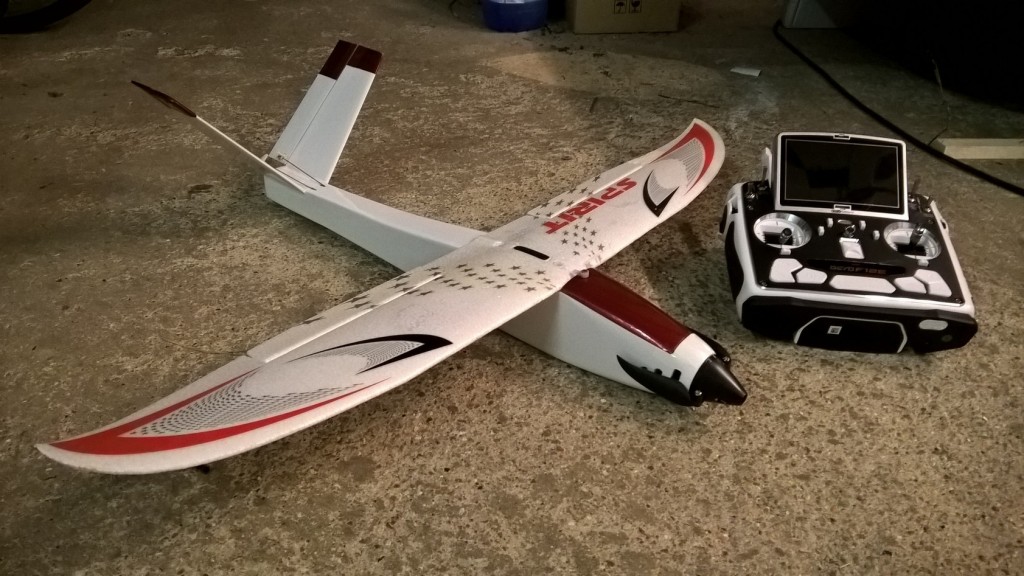
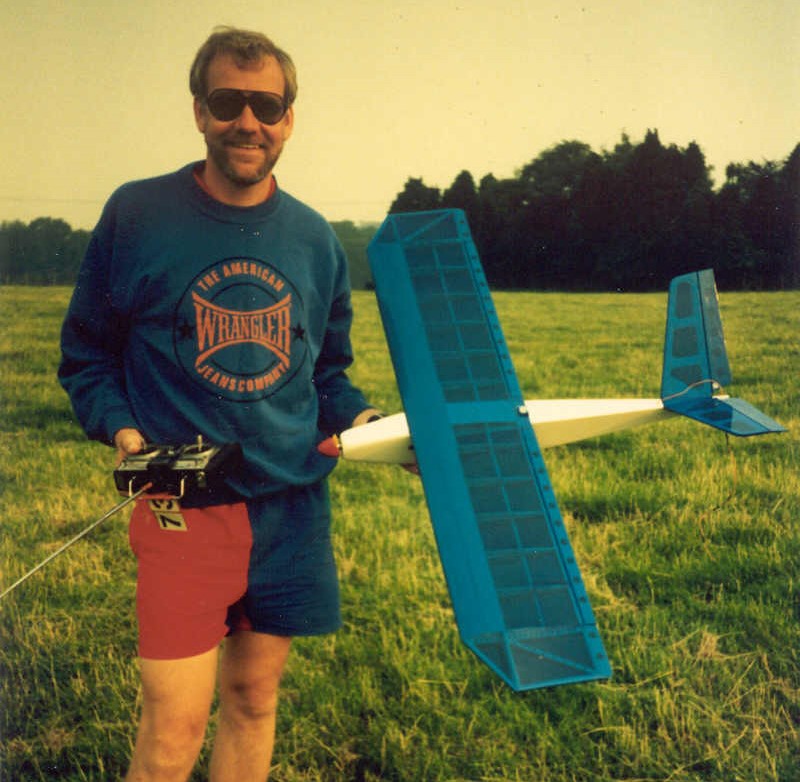 And I’ve hardly changed at all… The Vignette motor is from the Spirit’s evil twin, a Wingnetic, the same as I have fitted in my own Spirit. The V-tail controls elevator and rudder so with the aileron wing Dougal has all four functions.
And I’ve hardly changed at all… The Vignette motor is from the Spirit’s evil twin, a Wingnetic, the same as I have fitted in my own Spirit. The V-tail controls elevator and rudder so with the aileron wing Dougal has all four functions.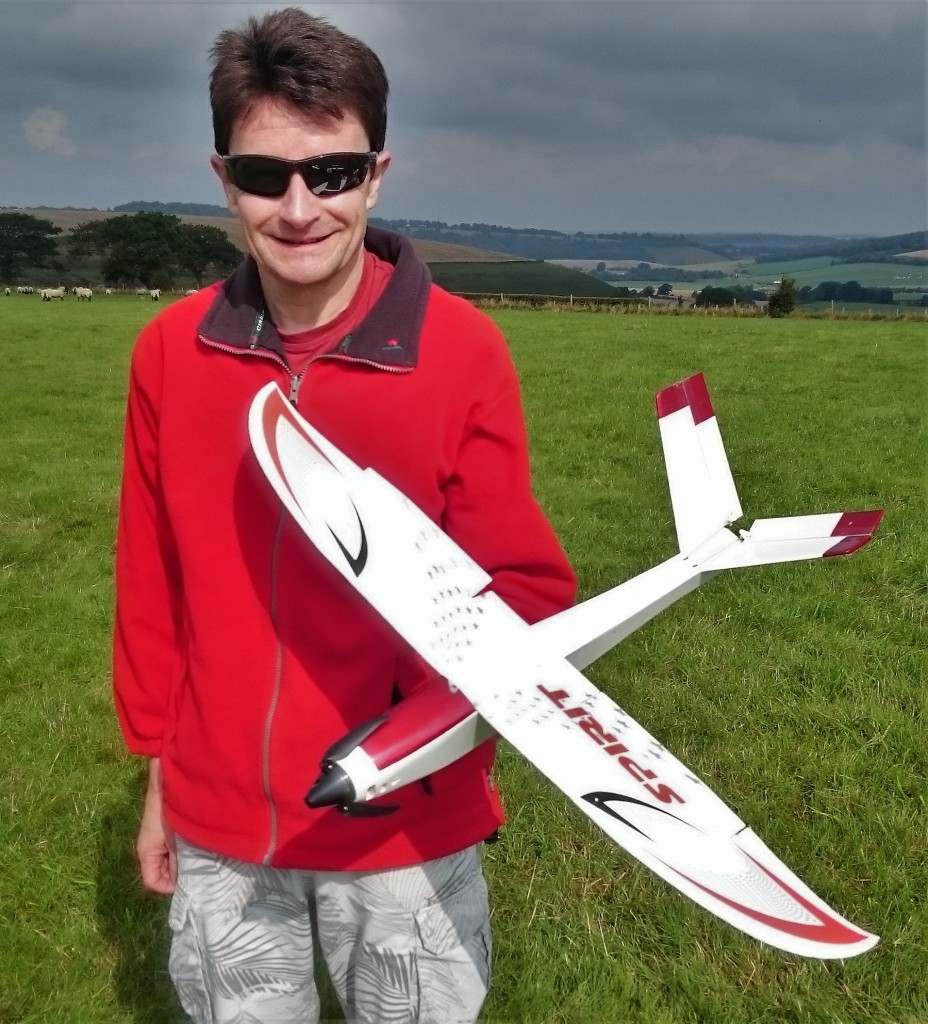 I suspect that if it had failed to fly nicely the name would have changed to Vinegarette but it didn’t, it flew brilliantly. You can see some of the first flight in this month’s video, although it’s so fast and agile it’s not easy to film. It’s very annoying, it seemed to be faster than my Spirit, and flew even better.
I suspect that if it had failed to fly nicely the name would have changed to Vinegarette but it didn’t, it flew brilliantly. You can see some of the first flight in this month’s video, although it’s so fast and agile it’s not easy to film. It’s very annoying, it seemed to be faster than my Spirit, and flew even better.
Finally, a couple of superb quality photos from Rusty G. These both feature Dougal’s Spitfire, I think you’ll have to agree they are absolutely stunning.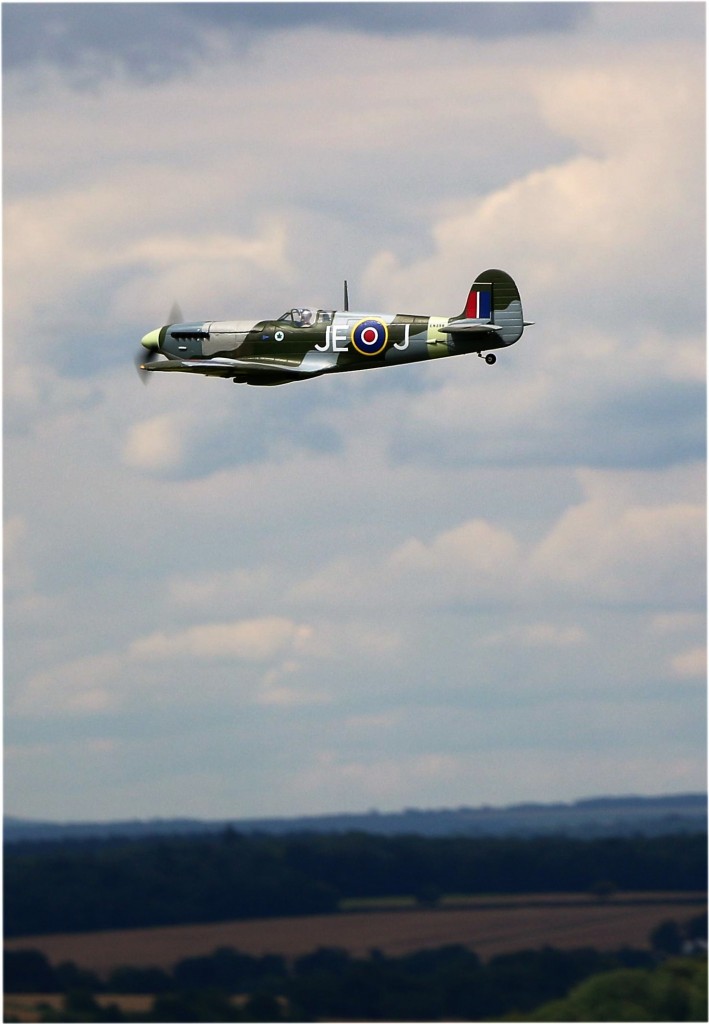
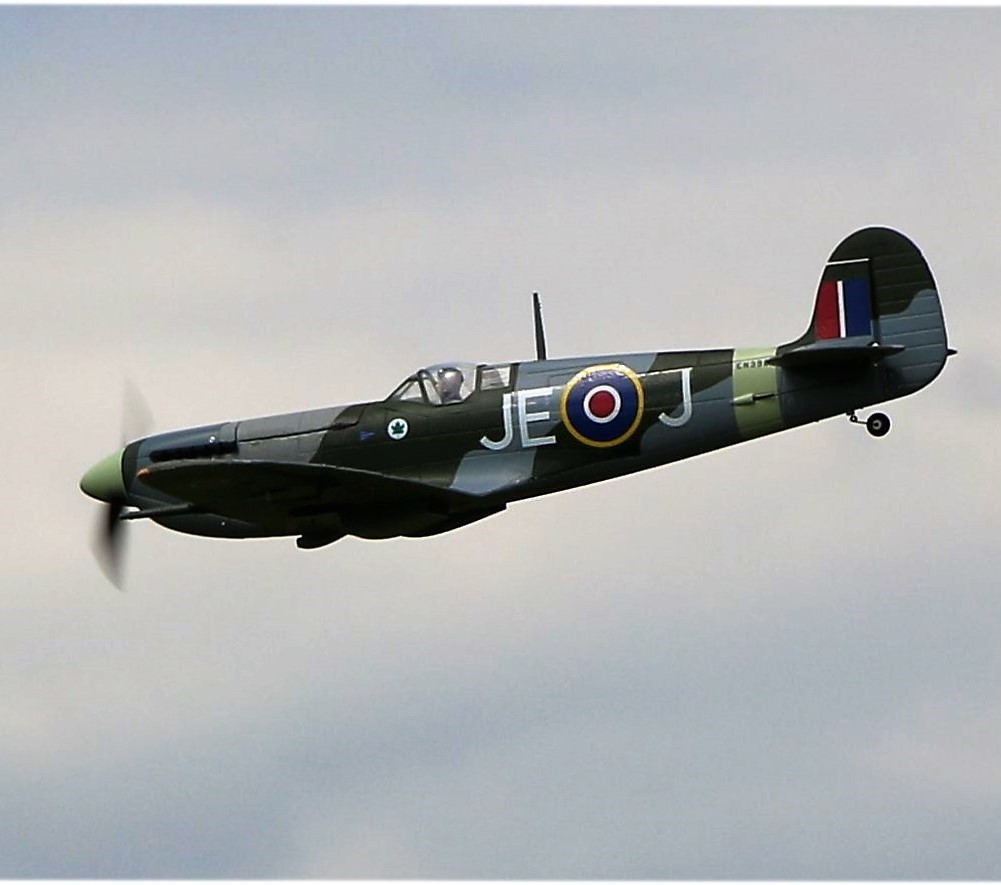
Next month’s Patch News may well be rather late making an appearance as I will be in Mexico at the end of September and beginning of October. Before that I’ll be in France for a few days, and I’ve got to find time to organise the skittles on 17th September and finish my club model (with the Fine Klogleman wing) before the meeting on 22nd September so that doesn’t leave me very much time for writing. All contributions of anything I miss while away will be gratefully received, photos, videos, and write-ups.
Please watch the video full screen, it’s so much better with small models flying around. If the video above won’t play for you CLICK HERE
A Boeing 747 was having engine trouble, and the pilot instructed the cabin crew to have the passengers take their seats and get prepared for an emergency landing.
A couple minutes later, the pilot asked the flight attendants if everyone was ready. Back came the reply:
“All set back here, Captain, except the lawyers are still going around passing out business cards.”
Colin Cowplain
Patch News – July 2016
Hooray, summer seems to have arrived at last! After a pretty lousy June July has been mostly good for us with plenty of sunshine and reasonably light winds for much of the month. Farmer George had been letting the field grow for hay and it had become very long, but it’s now been cut, dried, baled, and removed.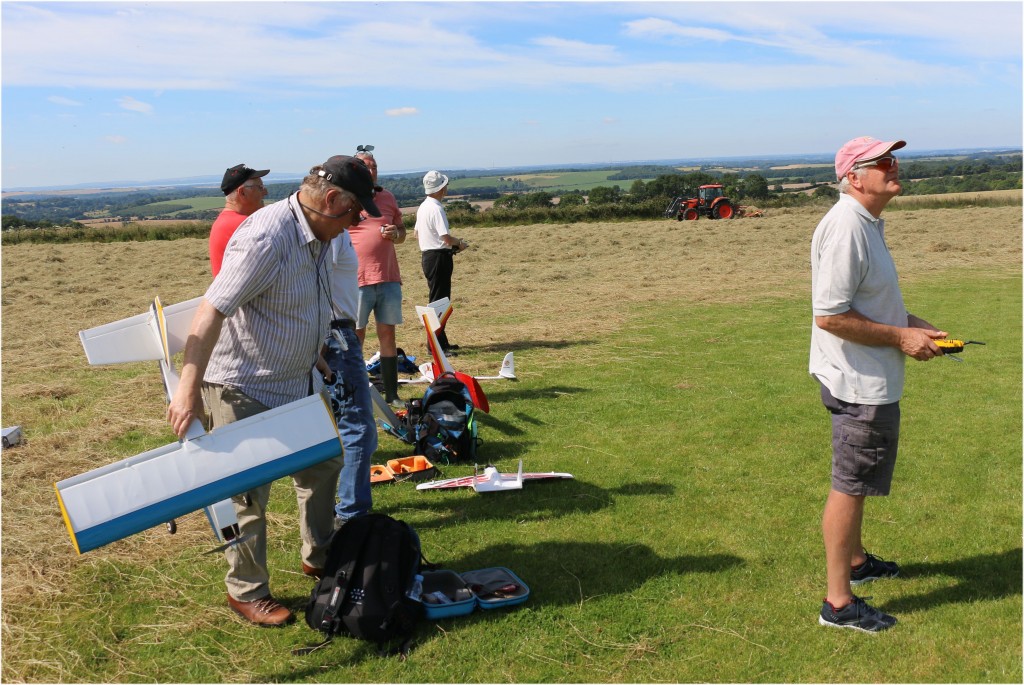 We had to have the pits on the edge of the patch while the farmer was working on the hay, a small price to pay.
We had to have the pits on the edge of the patch while the farmer was working on the hay, a small price to pay.
The new mower is working well and the patch is in excellent condition once again. Of course the only downside of the field being cut is that before too long we’ll be joined by the friendly bullocks again. Captain Slow snapped this photo of Dougal Entendre and 1066, the happy mowers, a couple of Sundays ago. You’ll find it cuts much better if you put it down chaps…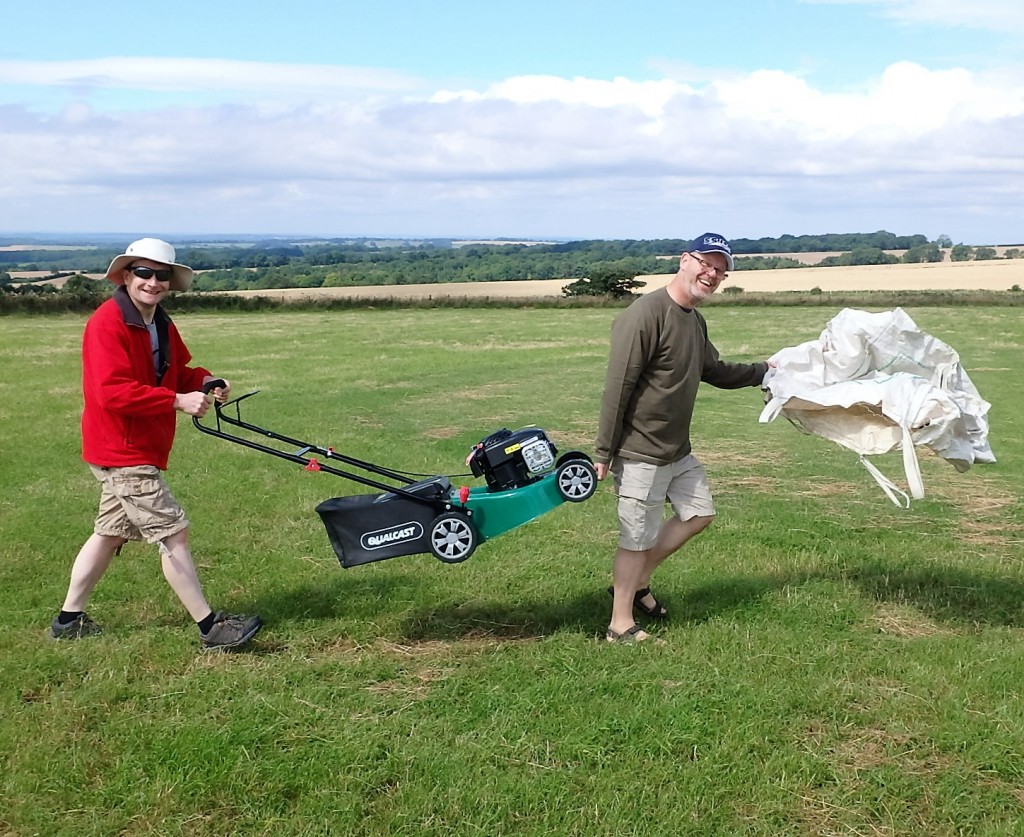 Of course there is always a downside to sunny days, look at the state of those legs…they should be banned!
Of course there is always a downside to sunny days, look at the state of those legs…they should be banned!
I’ll start this month with a couple of slight disasters, the first being one of my own. With the patch cut short and in good condition I decided to dig out my Ugly Stik and practice some touch & goes, with the hope of getting a decent score for the ongoing competition. The Stik is the foam HobbyKing one that has a plastic dummy I/C engine (aren’t all I/C’s dummies?) with a proper electric motor behind it that drives the prop via an extension shaft.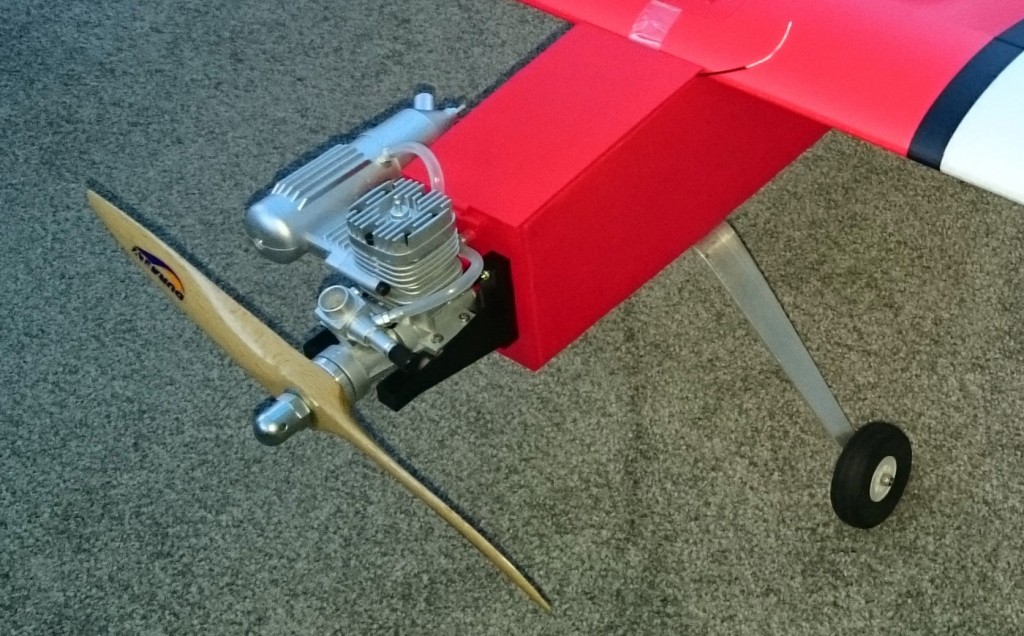 Having previously had the undercarriage fall off on a feather-like landing I had already strengthened the undercarriage mount. This had then shifted the stresses to the next weak point and on my next ‘feather-like’ landing the whole nose broke off at the front of the wing.
Having previously had the undercarriage fall off on a feather-like landing I had already strengthened the undercarriage mount. This had then shifted the stresses to the next weak point and on my next ‘feather-like’ landing the whole nose broke off at the front of the wing.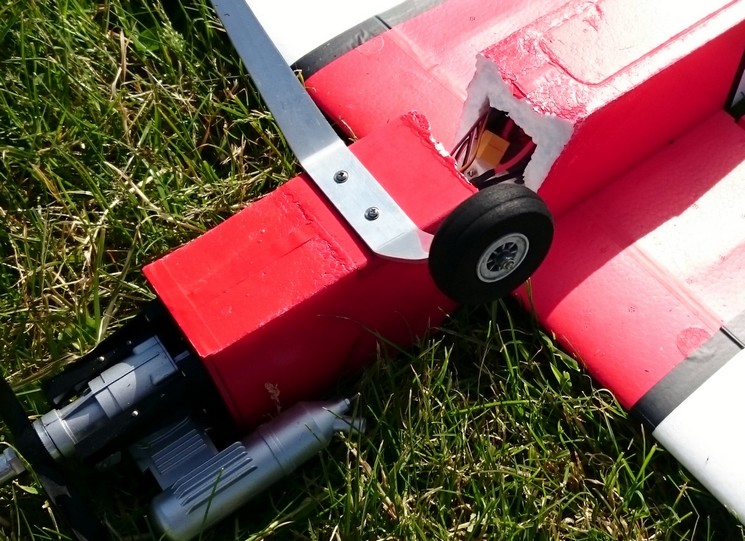 So then I’d set a couple of spruce reinforcement strips into the fuselage sides and all was well again, the whole set-up was now good and strong, what could possibly go wrong? This could:
So then I’d set a couple of spruce reinforcement strips into the fuselage sides and all was well again, the whole set-up was now good and strong, what could possibly go wrong? This could: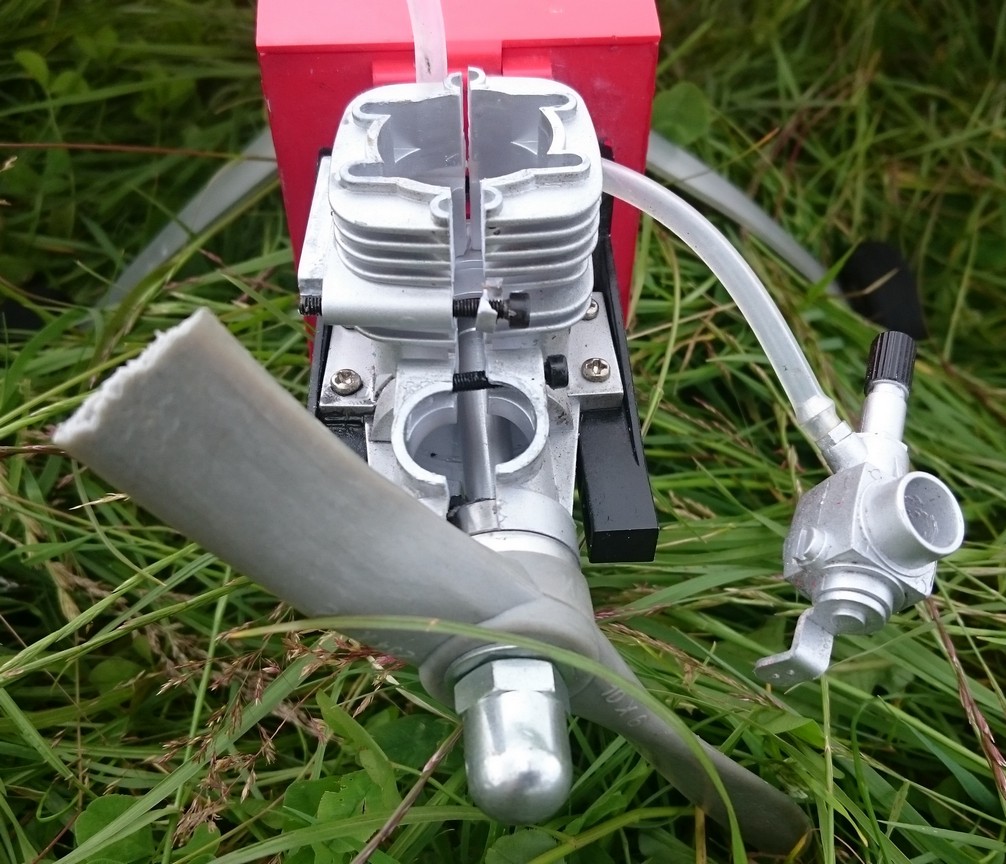 The first few touch and goes were fine and with my confidence growing I was getting the time between touches shorter and shorter, until eventually I touched a little too hard and upon opening the throttle there was an almighty din and bits flew off! It seems that my slightly less than feather-like landing had broken the prop and the then unbalanced remains had proved too much of a strain for the extension shaft which ripped the dummy motor apart. See, I always knew I/C motors were nothing but trouble!
The first few touch and goes were fine and with my confidence growing I was getting the time between touches shorter and shorter, until eventually I touched a little too hard and upon opening the throttle there was an almighty din and bits flew off! It seems that my slightly less than feather-like landing had broken the prop and the then unbalanced remains had proved too much of a strain for the extension shaft which ripped the dummy motor apart. See, I always knew I/C motors were nothing but trouble!
The second disaster of the month came from Norwegian Nick. He had built a lovely little Bede BD-5 from Depron, some of you will have seen it when he brought it along to one of our club nights.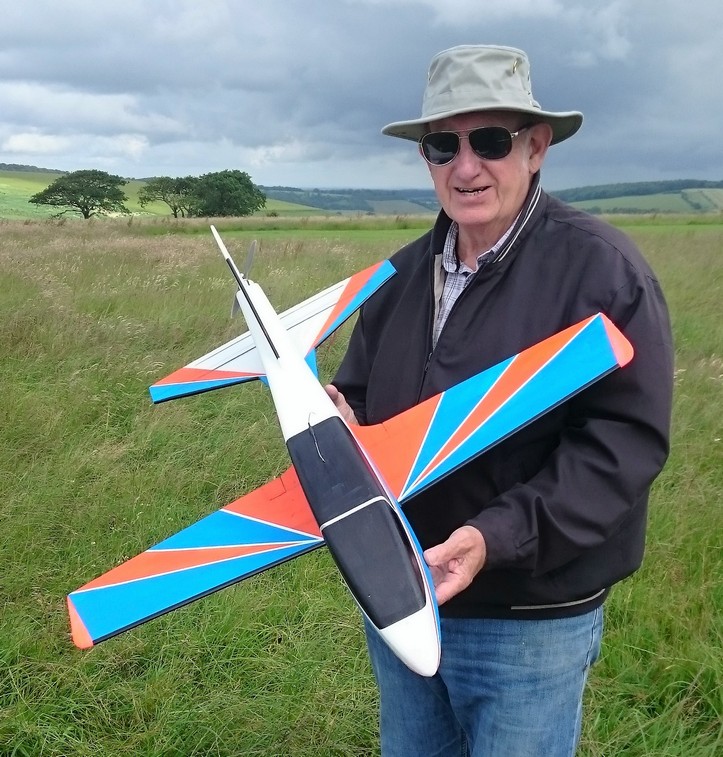 The BD-5 is one of many aircraft designed by American pilot Jim Bede; you probably recognize it from its appearance in the James Bond film License to Kill, when a jet version flew through an aircraft hangar. The same stunt pilot, Corkey Fornof, had previously flown the same aircraft in Octopussy when he landed on a highway and rolled into a gas station. Amazingly this stunt was recreating an event that had actually happened to Corkey when he had an engine failure and was forced to land on Interstate 95 and rolled into a Sunoco gas station.
The BD-5 is one of many aircraft designed by American pilot Jim Bede; you probably recognize it from its appearance in the James Bond film License to Kill, when a jet version flew through an aircraft hangar. The same stunt pilot, Corkey Fornof, had previously flown the same aircraft in Octopussy when he landed on a highway and rolled into a gas station. Amazingly this stunt was recreating an event that had actually happened to Corkey when he had an engine failure and was forced to land on Interstate 95 and rolled into a Sunoco gas station.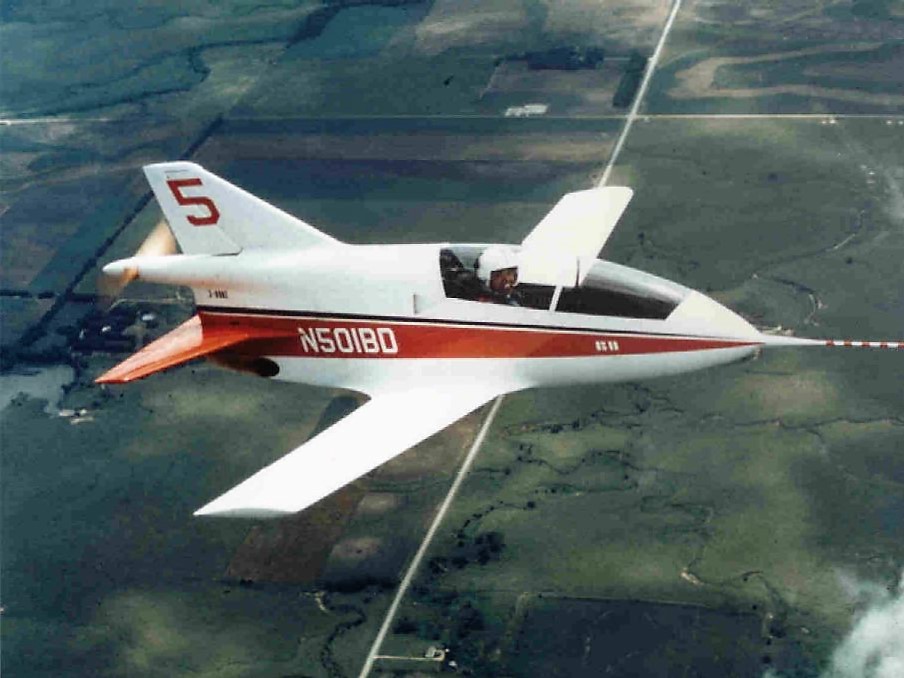 This is from Wikipedia: The BD-5 Micro is a series of small, single-seat homebuilt aircraft created in the late 1960s by US aircraft designer Jim Bede and introduced to the market primarily in kit form by the now-defunct Bede Aircraft Corporation in the early 1970s.
This is from Wikipedia: The BD-5 Micro is a series of small, single-seat homebuilt aircraft created in the late 1960s by US aircraft designer Jim Bede and introduced to the market primarily in kit form by the now-defunct Bede Aircraft Corporation in the early 1970s.
The BD-5 has a small, streamlined fuselage holding its semi-reclined pilot under a large canopy, with the engine installed in a compartment in the middle of the fuselage, and a propeller-driving engine (or jet engine in the BD-5J variant) mounted immediately to the rear of the cockpit. The combination of fighter-like looks and relatively low cost led to the BD-5 selling over 5,000 kits or plans, with approximately 12,000 orders being taken for a proposed factory-built, FAA-certified version.
However, few of the kit versions were actually completed due to the company’s bankruptcy in the mid-1970s, and none of the factory built “D” models were produced, as a result of the failure to find a reliable engine for the design.
In total, only a few hundred BD-5 kits were completed, although many of these are still being flown today. The BD-5J version holds the record for the world’s lightest single-engine jet aircraft, weighing only 358.8lb (162.7 kg).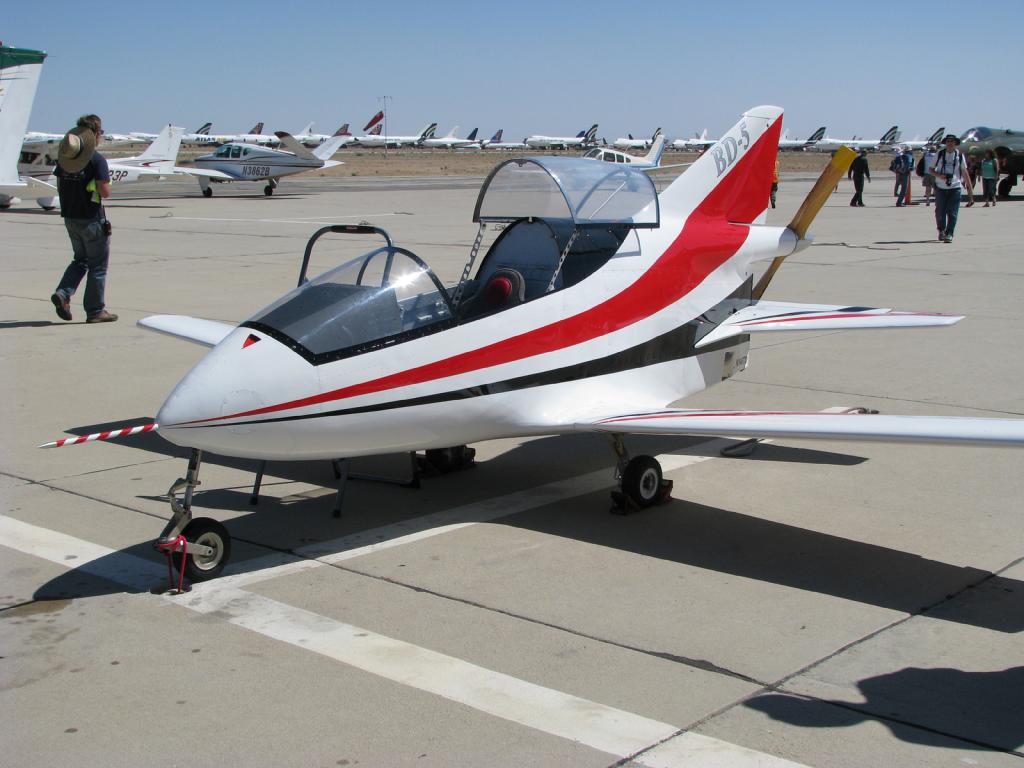 I found a flight test in Pilot magazine by Bob Grimstead which included this: “Its one significant failing is that it pitches up after engine failure. If you don’t catch the pitch-up within two seconds (the FAA’s assumed fit, professional pilot’s reaction time) you can’t prevent it stalling. Depending on span and aerofoil, stall recovery takes around 500 feet. After that it’s fine, if you’re still above ground.” That last sentence made me laugh!
I found a flight test in Pilot magazine by Bob Grimstead which included this: “Its one significant failing is that it pitches up after engine failure. If you don’t catch the pitch-up within two seconds (the FAA’s assumed fit, professional pilot’s reaction time) you can’t prevent it stalling. Depending on span and aerofoil, stall recovery takes around 500 feet. After that it’s fine, if you’re still above ground.” That last sentence made me laugh!
I think Nick built his model from the free plan on the RC-Plans.com website. It’s 35” span, weighs around 570g, and uses a 3 cell lipo of around 2200mAh (it needs the weight to get the CG in the correct place). The full-size had retracts but the model has no undercarriage at all, it simply slides along on its underside to take-off from grass.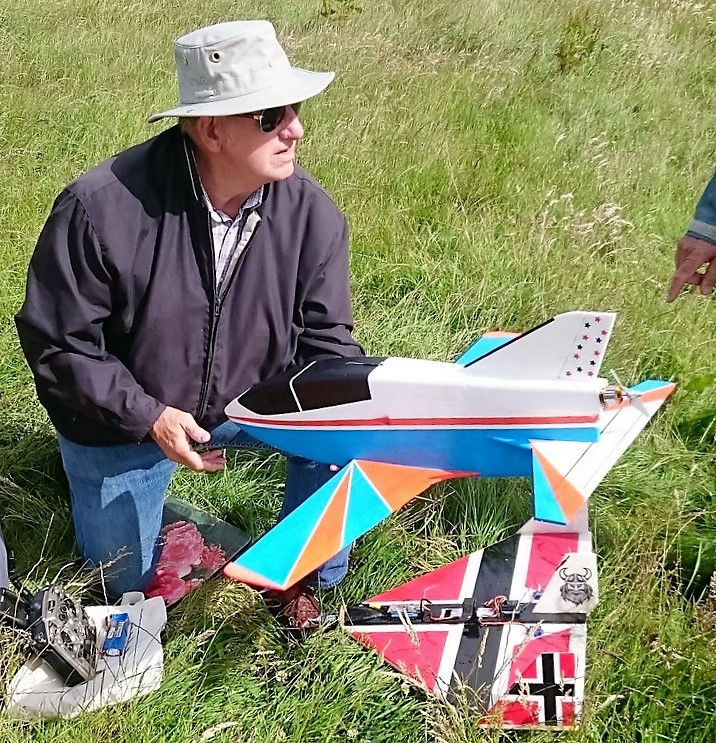 I wasn’t sure how well it would slide but in fact, after a ground loop on the first attempt, the second try went perfectly and it took off beautifully. Unfortunately the disaster happened almost immediately, the right hand wing folded and of course the model spun in with fatal damage. I really liked the model and it was a great shame it only lasted such a short time, although apparently it was true to scale, the full-size ones have a terrible safety record!
I wasn’t sure how well it would slide but in fact, after a ground loop on the first attempt, the second try went perfectly and it took off beautifully. Unfortunately the disaster happened almost immediately, the right hand wing folded and of course the model spun in with fatal damage. I really liked the model and it was a great shame it only lasted such a short time, although apparently it was true to scale, the full-size ones have a terrible safety record!
The only good thing about the incident was that I was videoing at the time so you can see the whole thing in this month’s video at the end of this edition.
The first new model to feature this month is Dan Handley’s Edge 540T 3D. It’s a HobbyKing model with EPP skin over a lite-ply frame method of construction, but with a wingspan of 1430mm the Edge is larger than most. It’s the same at the one Dougal Entendre has been flying with great success for the last few months and is a superb flier.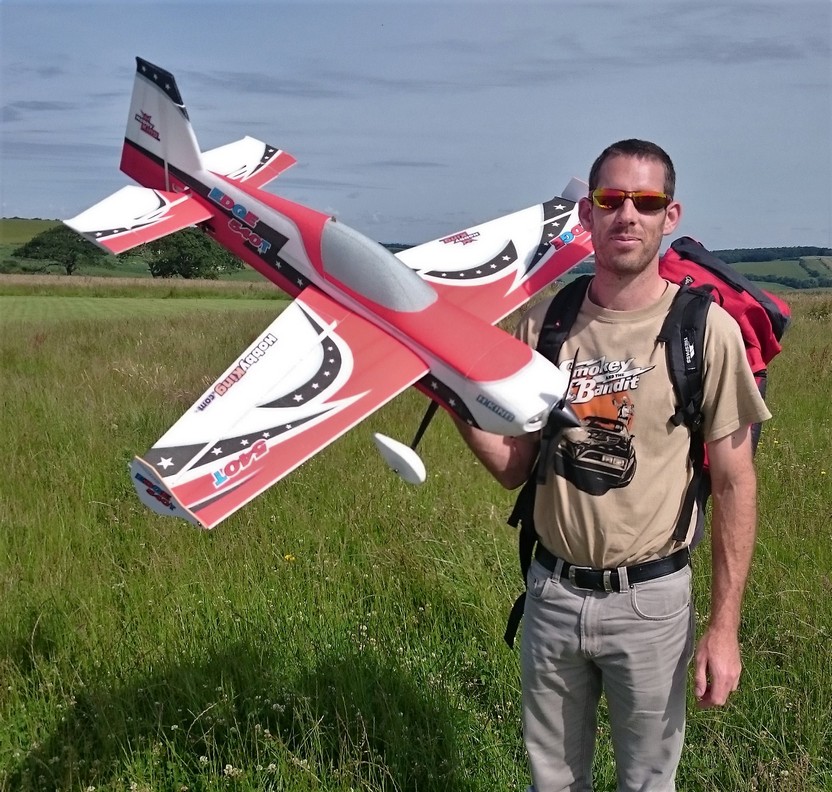 The model comes without any electronics so Dan has fitted an Emax 2820/07 850KV motor (case size is a 3542), a Plush 60A speed controller, and uses 4 cell Nanotech 2650 lipos. With a Dynam 12 x 6 prop the watt meter shows 630W at 41A and that seems to be ample power for the lightly constructed model. A 3D machine like this needs to have decent servos and Dan has fitted four metal geared Hitech HS65MGs that cost £20 each, ouch.
The model comes without any electronics so Dan has fitted an Emax 2820/07 850KV motor (case size is a 3542), a Plush 60A speed controller, and uses 4 cell Nanotech 2650 lipos. With a Dynam 12 x 6 prop the watt meter shows 630W at 41A and that seems to be ample power for the lightly constructed model. A 3D machine like this needs to have decent servos and Dan has fitted four metal geared Hitech HS65MGs that cost £20 each, ouch.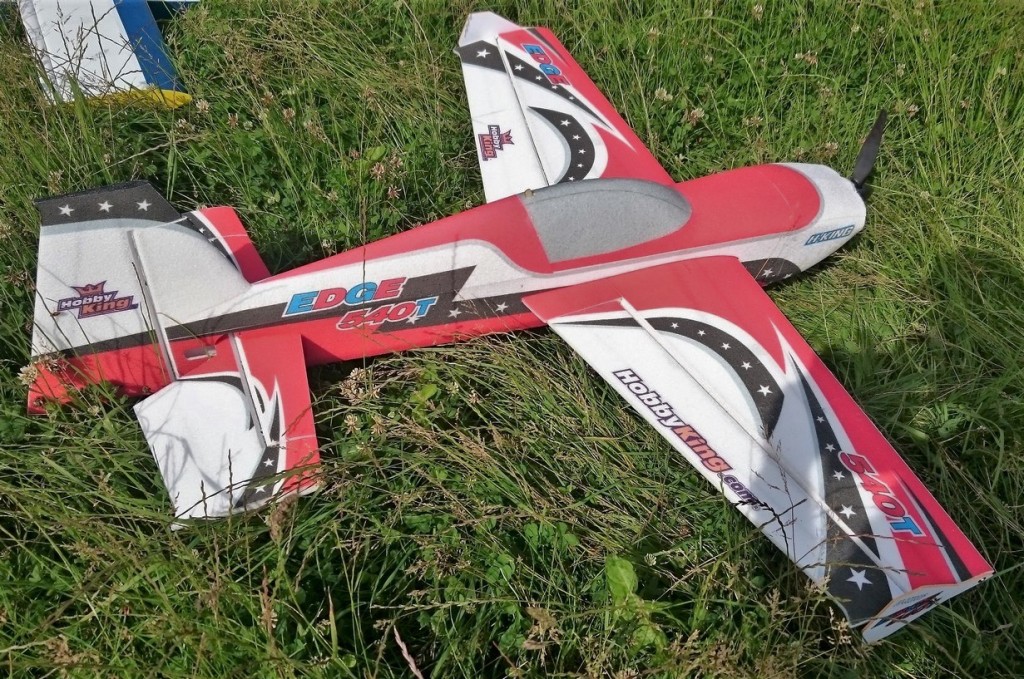 Dan is a relative newcomer to RC flying and struggled to get the landings correct with the model at first, so he’ll be really pleased to hear that I managed to record a couple of them for this month’s video!
Dan is a relative newcomer to RC flying and struggled to get the landings correct with the model at first, so he’ll be really pleased to hear that I managed to record a couple of them for this month’s video!
Captain Slow was good enough to send me some news of what happened to Dan one Sunday when I wasn’t at the patch. Apparently Dan’s Wot-4 spiralled in from a great height, resulting in lots of damage. The problem turned out to be a duff aileron pot on the transmitter. John thinks the receiver may have been damaged in the crash as it wouldn’t bind to John’s transmitter after the crash. Guess what make of radio it is…I’m not saying but appropriately it rhymes with rectum! The transmitter problem prevented Dan from test flying his latest acquisition, another Edge 540, this time from FMS. More details, and hopefully a flying report, in next month’s Patch News.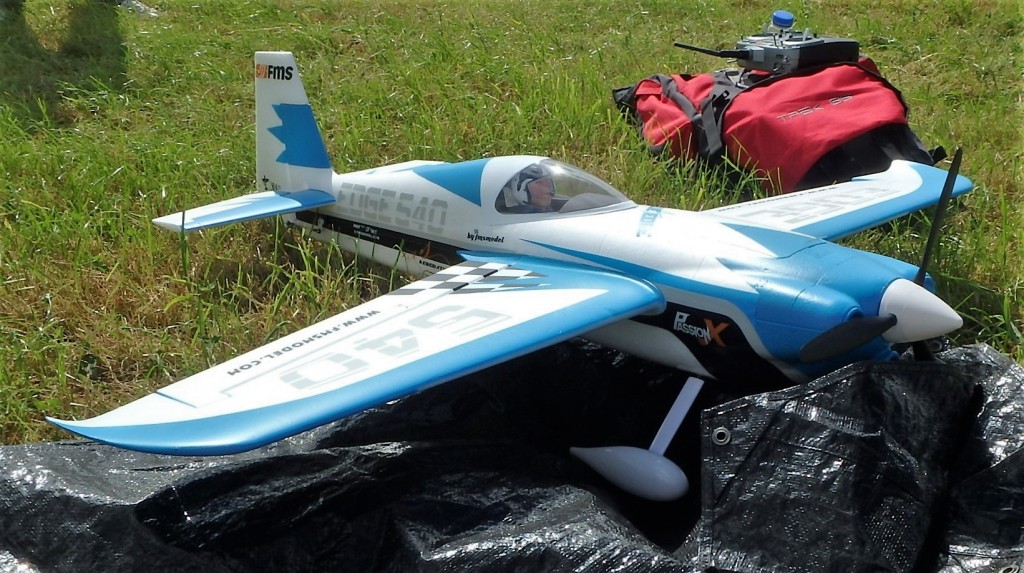 So far Dan hasn’t got a nickname, but Handley-Page was a great name in the world of aviation so maybe he should simply be Page. Or Page Boy? Yes, I like Page Boy. Any thoughts?
So far Dan hasn’t got a nickname, but Handley-Page was a great name in the world of aviation so maybe he should simply be Page. Or Page Boy? Yes, I like Page Boy. Any thoughts?
Stanley Knife surprised us all one day when he turned up with a small model. Stanley has always liked his models big, usually scale, and mostly of the gentle aerobatic kind, so it was quite a shock to see him with this: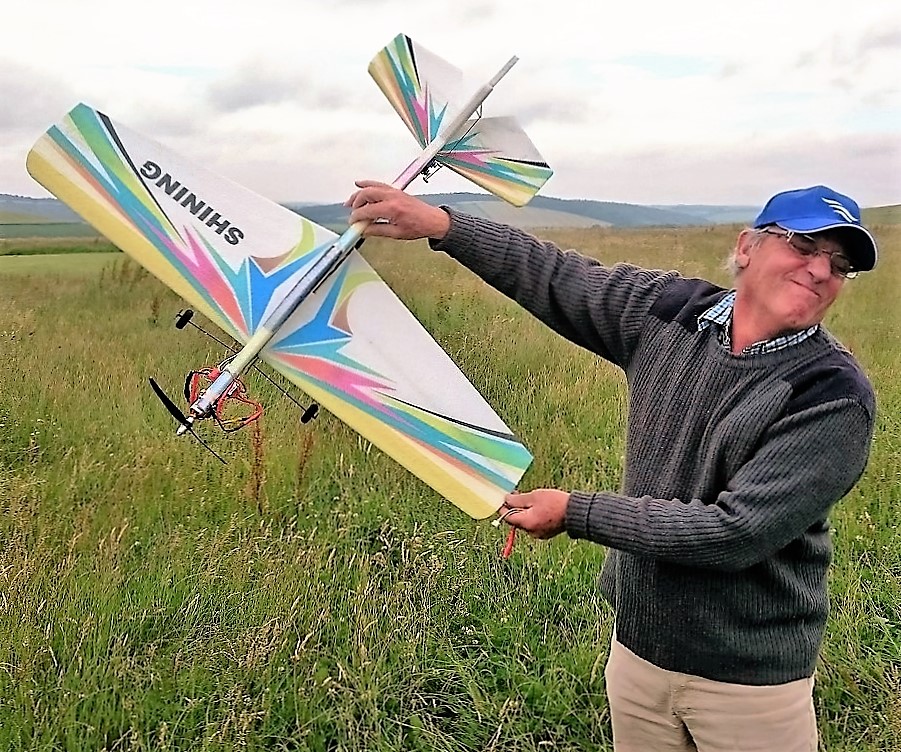 You can see his dislike for it in the photo, as he tried to pretend it had nothing to do with him! It’s a HobbyKing Shining, a 3D model made from solid EPP and according to HK it’s suitable for both indoor and outdoor flying.
You can see his dislike for it in the photo, as he tried to pretend it had nothing to do with him! It’s a HobbyKing Shining, a 3D model made from solid EPP and according to HK it’s suitable for both indoor and outdoor flying.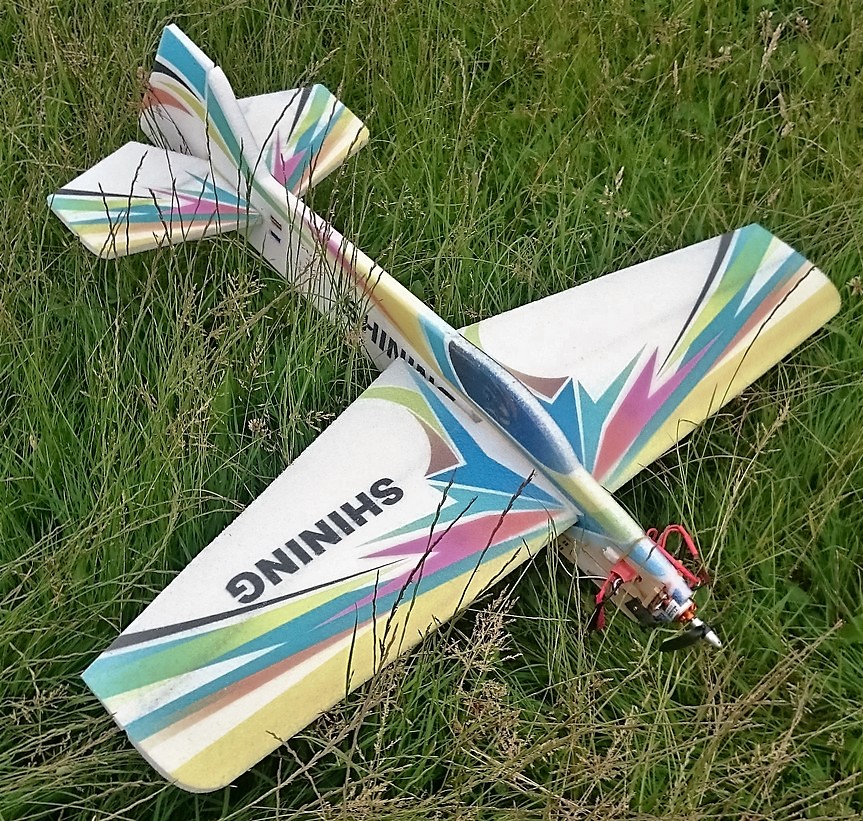 It’s quite similar to the Hummers that several of us are flying but is slightly smaller at 900mm span than the Hummers 1000mm span. Oddly the webpage recommends a larger motor than for the Hummer but with a smaller prop even though the KV is almost identical. I’m not sure what motor etc. Stanley has fitted but it seemed to fly pretty well. I think Stanley feels the same about it as I do my Hummer, it’s ok but not really my kind of thing.
It’s quite similar to the Hummers that several of us are flying but is slightly smaller at 900mm span than the Hummers 1000mm span. Oddly the webpage recommends a larger motor than for the Hummer but with a smaller prop even though the KV is almost identical. I’m not sure what motor etc. Stanley has fitted but it seemed to fly pretty well. I think Stanley feels the same about it as I do my Hummer, it’s ok but not really my kind of thing.
Norwegian Nick was pretty active during July and on one of his patch visits he brought along an Alfa Models FW190. Nick was given the model by his son Shaun who had never got round to finishing it but Nick soon had it ready to go.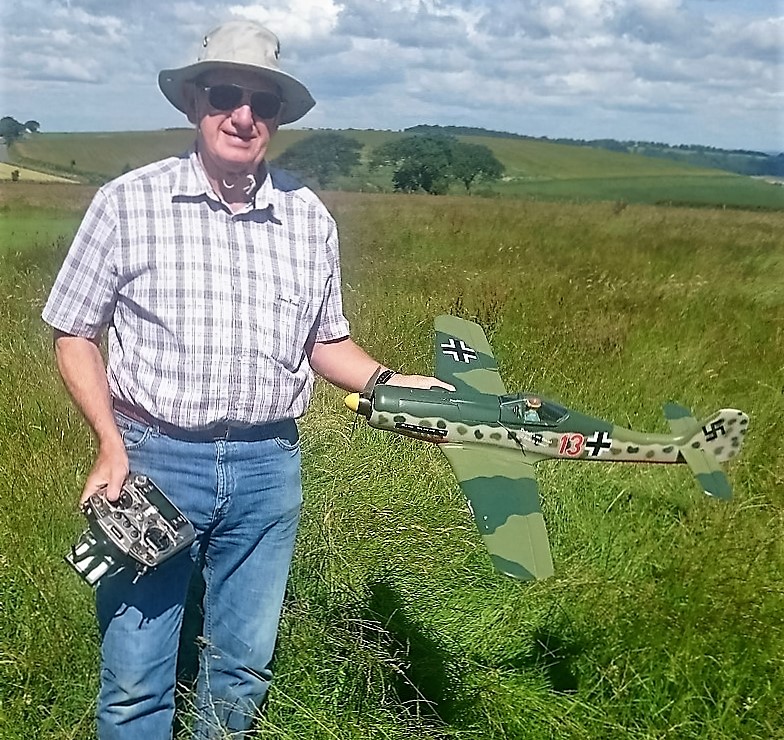 It’s 33 ½” span (850mm) and, being quite an old design, is moulded from expanded polystyrene with a hard skin. Originally it was designed to take a brushed motor fitted with a gearbox and a 7 cell nicad battery but Nick’s is fitted out with an up-to-date brushless outrunner and a 3 cell lipo, much better technology these days.
It’s 33 ½” span (850mm) and, being quite an old design, is moulded from expanded polystyrene with a hard skin. Originally it was designed to take a brushed motor fitted with a gearbox and a 7 cell nicad battery but Nick’s is fitted out with an up-to-date brushless outrunner and a 3 cell lipo, much better technology these days.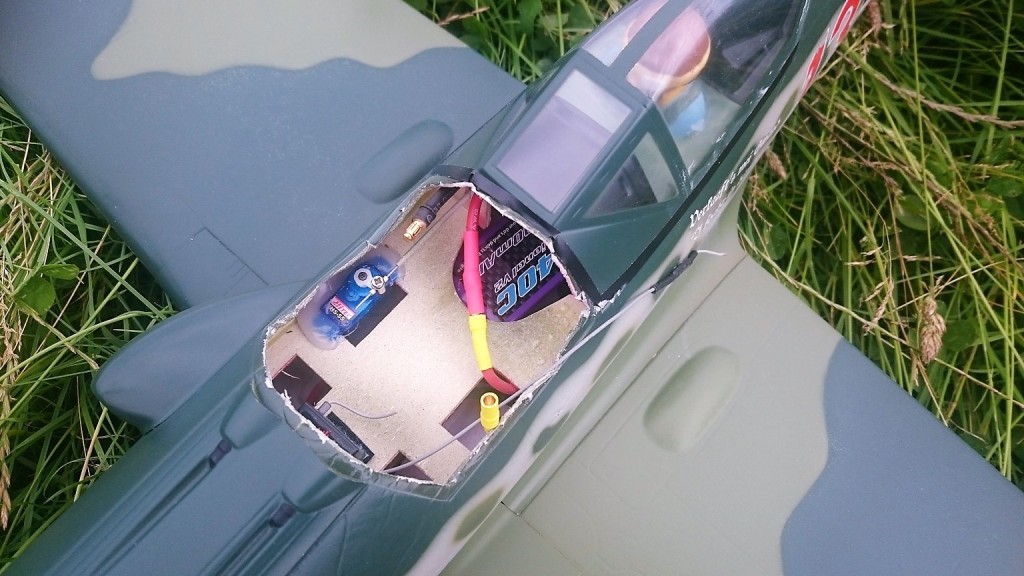
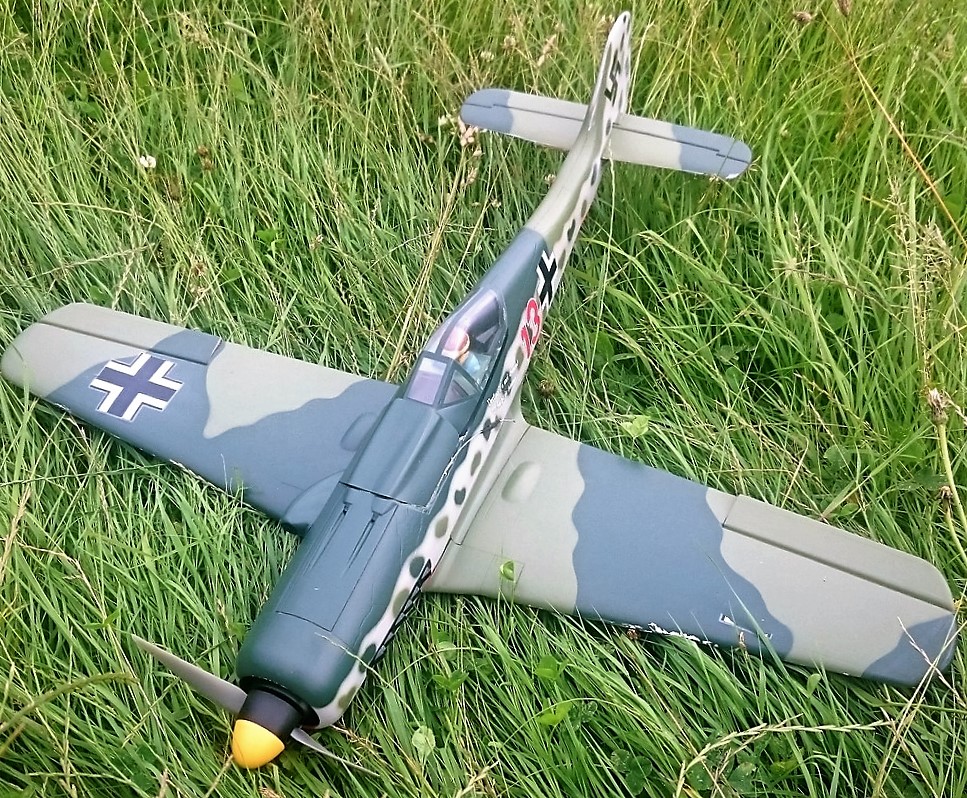 As most of you will know Nick is really a balsa basher and has a general dislike for foamies but recently he’s been flying a foam Tiger Moth that he won in a club raffle and is beginning to see the light. He was muttering a lot about disliking the foam FW190 before flying it but when it climbed away from its first launch and flew beautifully I think it grew on him a lot! It really does fly well and doesn’t seem to have any vices at all; I reckon this one will be flown a lot. It can be seen flying in this month’s video, although it’s a bit too small and nippy for me to capture much decent footage so blink and you’ll miss it.
As most of you will know Nick is really a balsa basher and has a general dislike for foamies but recently he’s been flying a foam Tiger Moth that he won in a club raffle and is beginning to see the light. He was muttering a lot about disliking the foam FW190 before flying it but when it climbed away from its first launch and flew beautifully I think it grew on him a lot! It really does fly well and doesn’t seem to have any vices at all; I reckon this one will be flown a lot. It can be seen flying in this month’s video, although it’s a bit too small and nippy for me to capture much decent footage so blink and you’ll miss it.
Last month I pictured Dougal Entendre’s latest transmitter that features just about everything including a screen capable of being used for FPV flying (First Person View). He assured me he wasn’t interested in trying FPV, the transmitter just happened to have it…so here is his first attempt at an FPV model!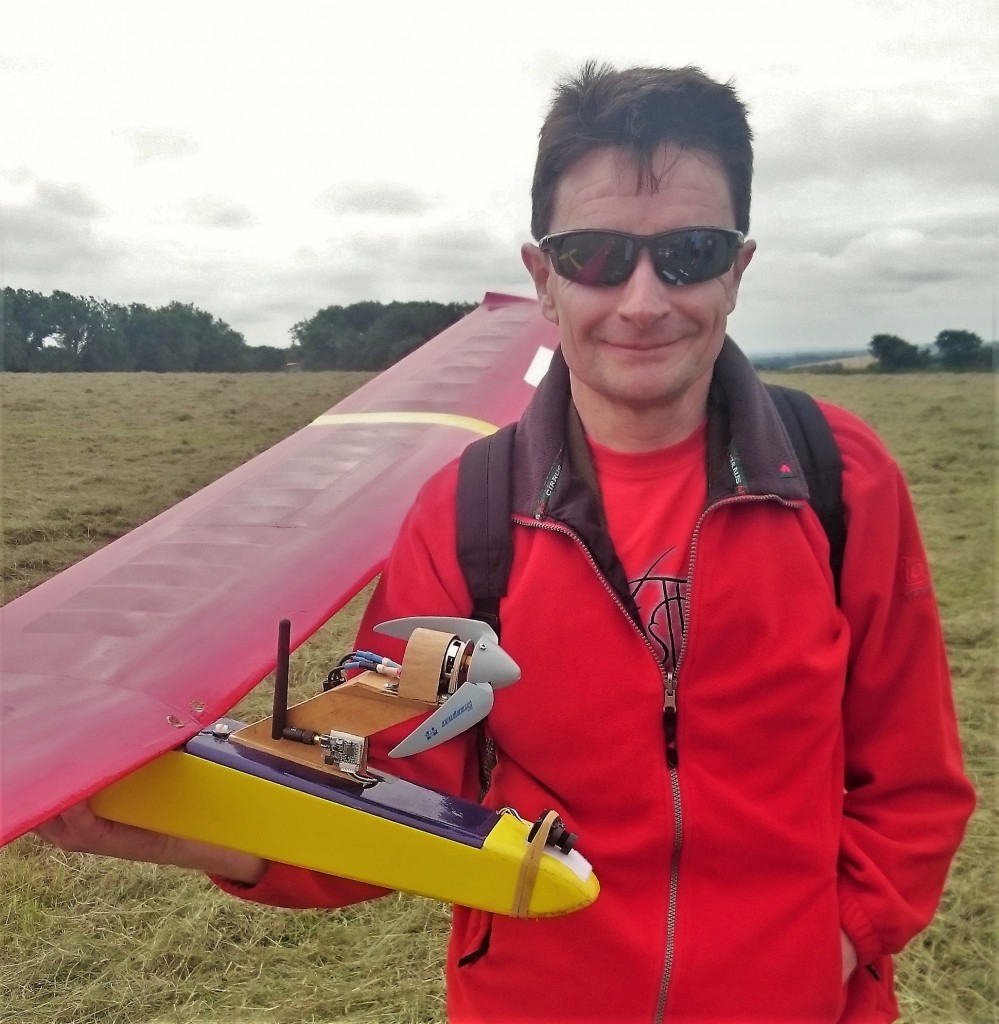 Actually the model is an old Olympic 100” span glider that he had previously fitted with a power pod, so all he had to do was add a camera and 5.8GHz transmitter. The transmitter screen has a shroud around it to shield it from the sun but Dougal still found it difficult to see the screen, particularly in the bright sunlight (it shouldn’t be a problem for most of the year then Dougal!).
Actually the model is an old Olympic 100” span glider that he had previously fitted with a power pod, so all he had to do was add a camera and 5.8GHz transmitter. The transmitter screen has a shroud around it to shield it from the sun but Dougal still found it difficult to see the screen, particularly in the bright sunlight (it shouldn’t be a problem for most of the year then Dougal!).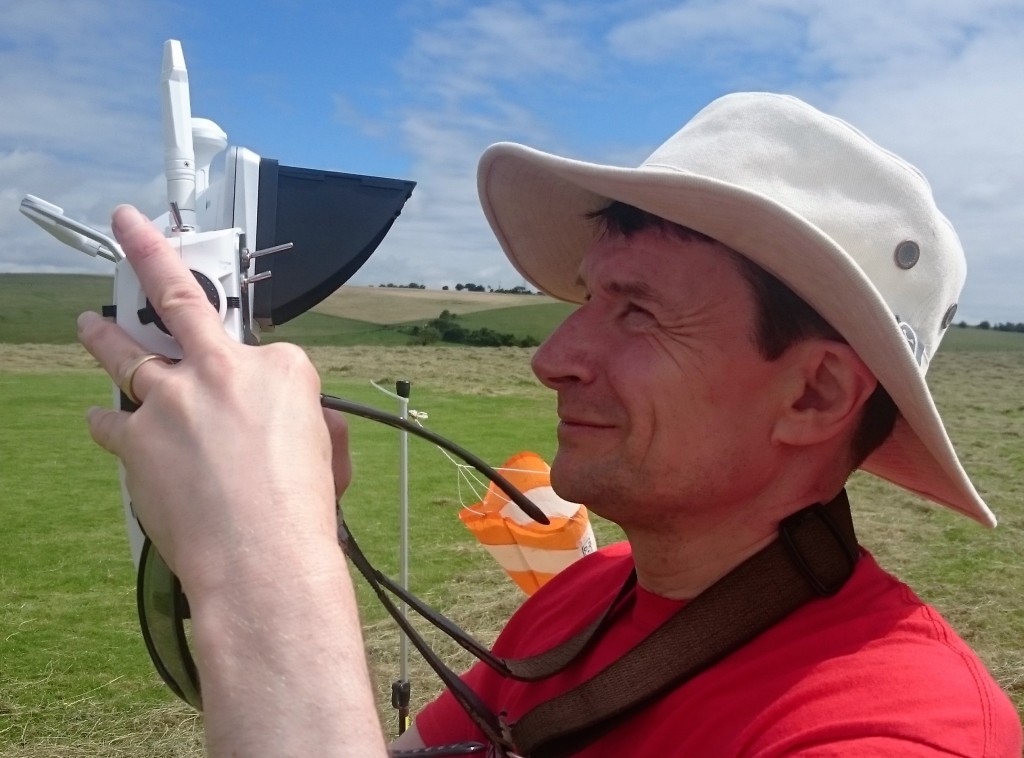 The true answer to the problem is FPV goggles of course but they don’t come cheap and introduce other difficulties anyway. The other problem he found was that the range of the FPV signal really wasn’t enough when flying a sizeable thermal soarer, he kept getting video break-up, although he thinks it would be fine for a drone that would be easier to keep close to the pilot.
The true answer to the problem is FPV goggles of course but they don’t come cheap and introduce other difficulties anyway. The other problem he found was that the range of the FPV signal really wasn’t enough when flying a sizeable thermal soarer, he kept getting video break-up, although he thinks it would be fine for a drone that would be easier to keep close to the pilot.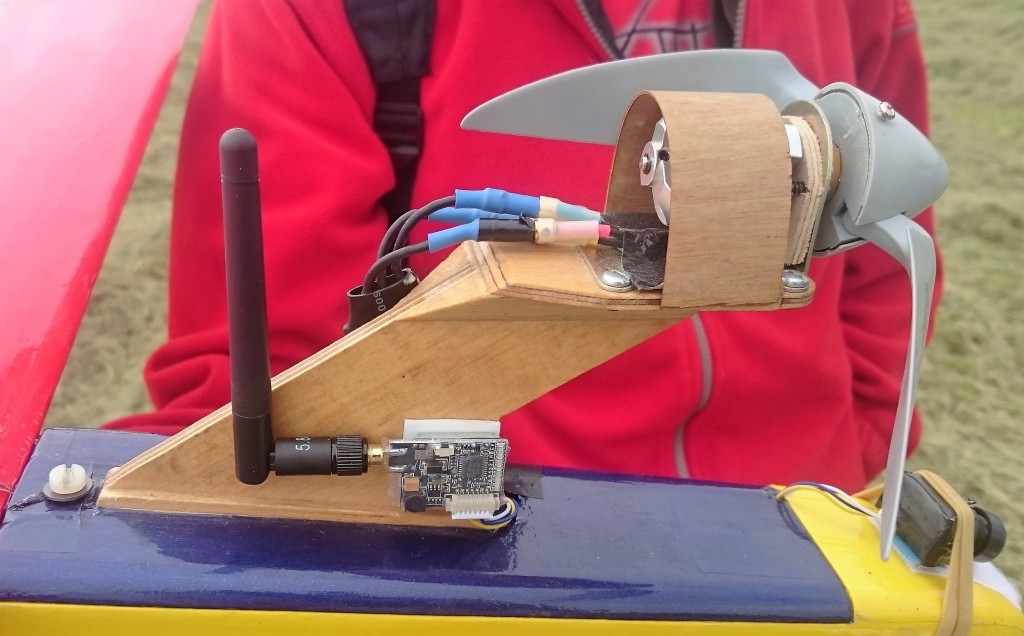 The FPV transmitter is 25mW, the maximum legal output in the UK for 5.8GHz, although there are better aerials available that may improve the range somewhat. But Dougal says that although it was an interesting diversion he intends to stick to ‘normal’ flying for now.
The FPV transmitter is 25mW, the maximum legal output in the UK for 5.8GHz, although there are better aerials available that may improve the range somewhat. But Dougal says that although it was an interesting diversion he intends to stick to ‘normal’ flying for now.
Chris P Bacon has splashed out on an electric glider, a Max Thrust Lightning. He assures me he didn’t really want a new model but he just happened to be driving near Worthing and an inexplicable force sucked him into Sussex Model Centre. What’s a chap to do, it would be rude not to buy something wouldn’t it?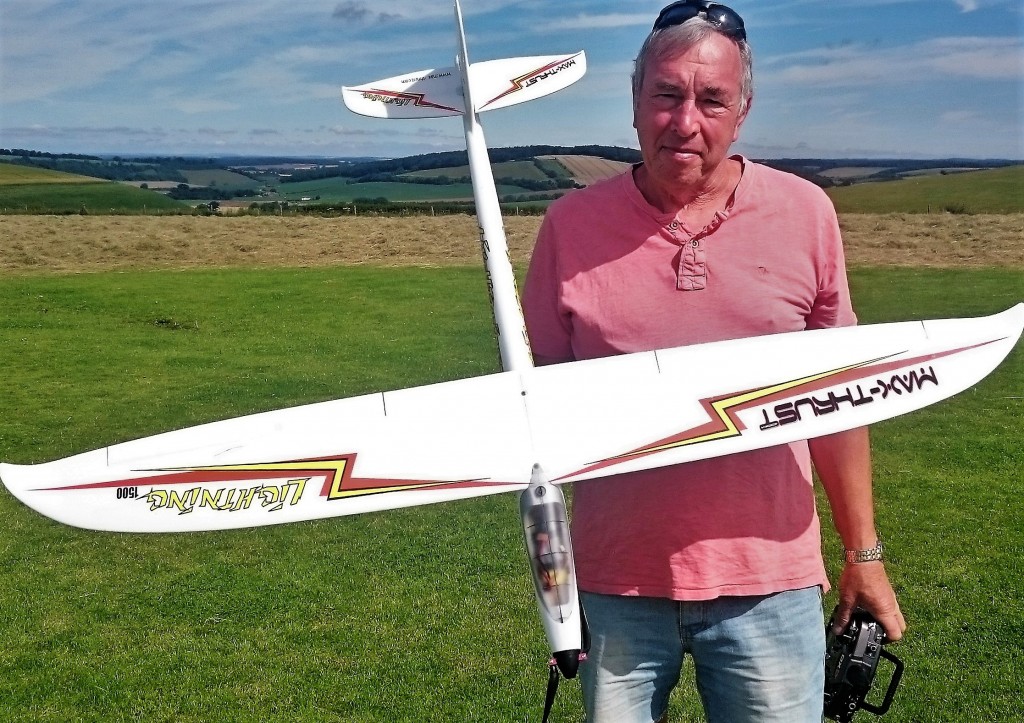 The Lightning is 59” span (1500mm) and is available in kit form or Plug’n’Fly which has the motor, esc, and servos already fitted. Chris P opted for the Plug’n’Fly version so just had to add a receiver and a 2200mAh 3 cell lipo pack.
The Lightning is 59” span (1500mm) and is available in kit form or Plug’n’Fly which has the motor, esc, and servos already fitted. Chris P opted for the Plug’n’Fly version so just had to add a receiver and a 2200mAh 3 cell lipo pack.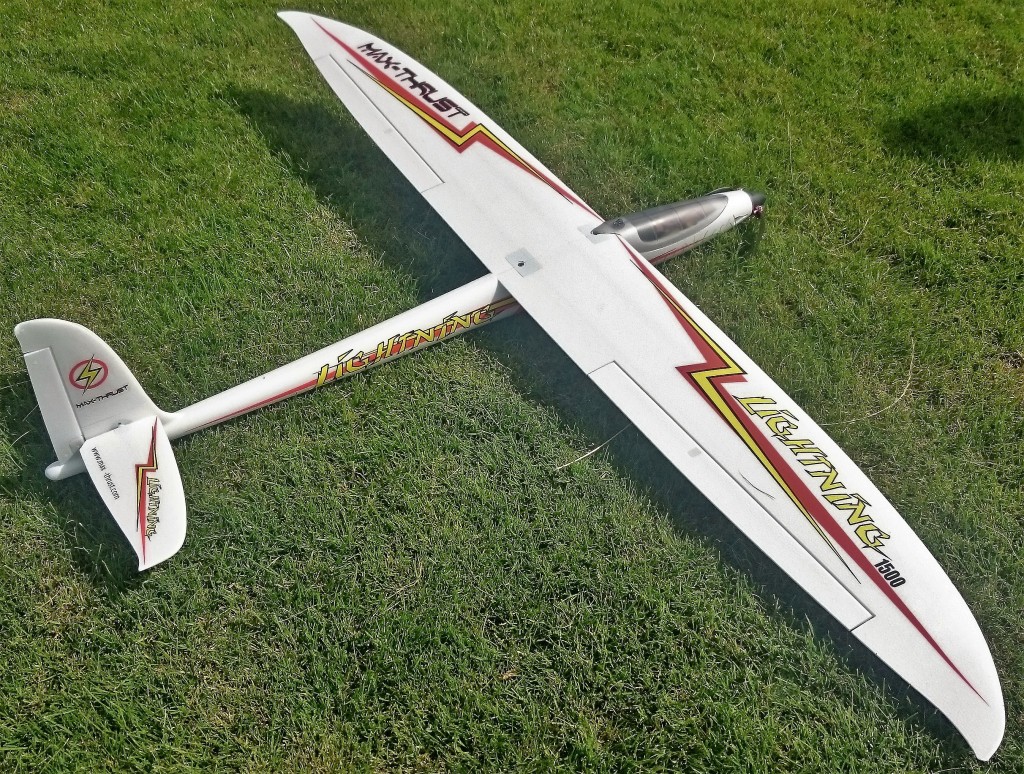 The model is of moulded EPO foam construction with carbon wing spars and carbon reinforcing as required, and is basically a ‘warm-liner’, capable of fairly fast flight performing precision aerobatics or simply stooging around looking for thermals. It flies very nicely and should be a good model for our often windy field.
The model is of moulded EPO foam construction with carbon wing spars and carbon reinforcing as required, and is basically a ‘warm-liner’, capable of fairly fast flight performing precision aerobatics or simply stooging around looking for thermals. It flies very nicely and should be a good model for our often windy field.
Finally this month, we had a surprise visit by Burly Turley. These days he usually flies at Thorney with the Chichester club and I thought he’d forgotten where our field was but he managed to track us down. Luckily his visit was just after the field had been cut, otherwise he could have been lost for months. He brought along his SebArt Shark to fly and I must say I was very impressed by it.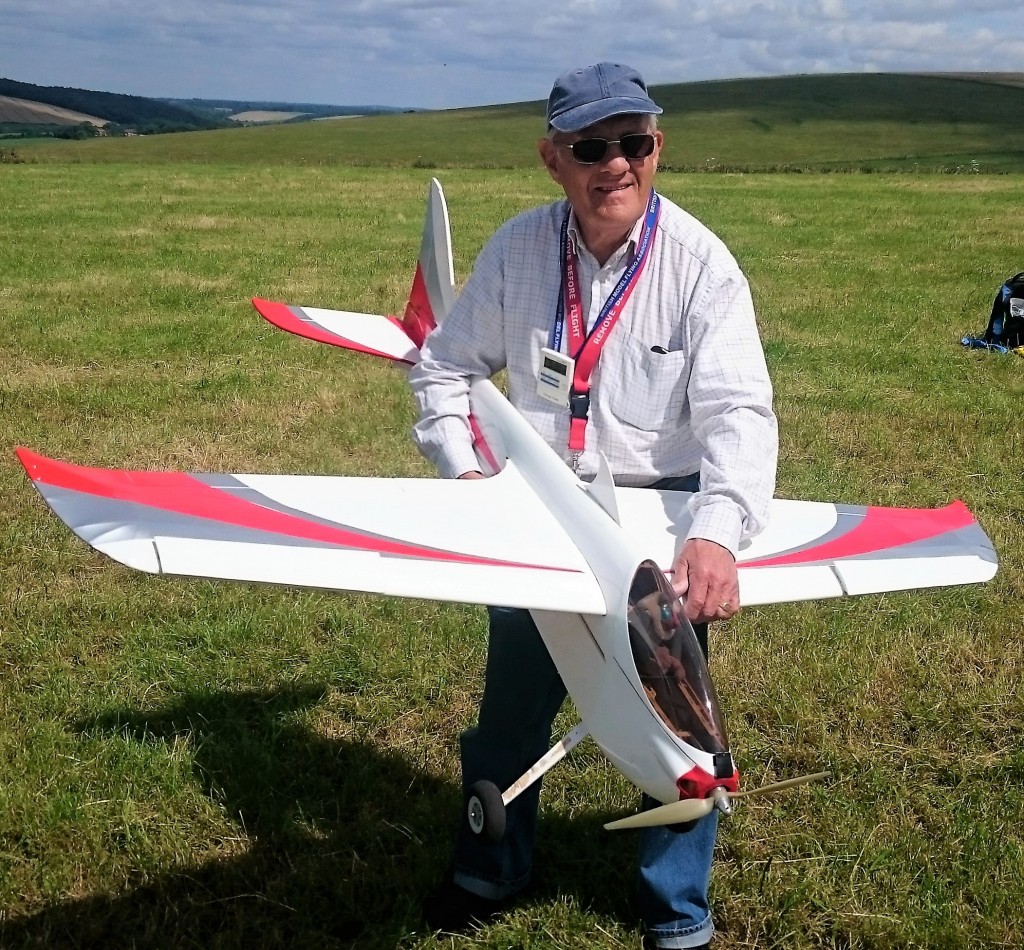 The Shark was designed by the Italian champion Sebastiano Silvestri and is sold as a trainer but given the right pilot and power set-up it’s capable of knife edge flight, prop hanging, harriers, and so on. The model comes as airframe only so Burly had fit his own motor, esc, and servos.
The Shark was designed by the Italian champion Sebastiano Silvestri and is sold as a trainer but given the right pilot and power set-up it’s capable of knife edge flight, prop hanging, harriers, and so on. The model comes as airframe only so Burly had fit his own motor, esc, and servos.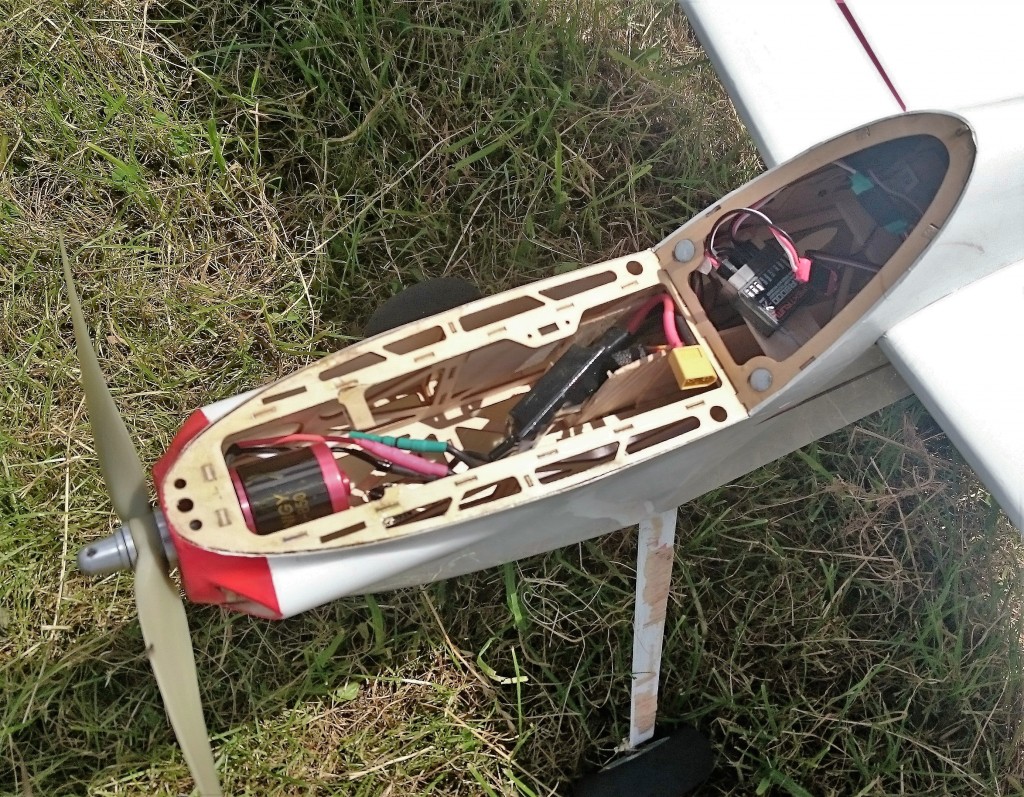 He ordered a Turnigy motor from HobbyKing’s international warehouse and was complaining bitterly that they’d ripped him when he got clobbered for import duty and its collection charges. Not quite sure how import duty was HobbyKing’s fault… Mind you he was also complaining that some of his lipo packs aren’t performing as well as they used to, but then he explained that they are nine years old… NINE YEARS! Anyway, Burly flew the Shark around in a very slow and gentle manner and then did an absolutely perfect landing (no really!) before letting me have a flight with it. It’s very nice to fly, a very good all-rounder in the air and, to me, a pretty model as well. You can see Burly flying his Shark in this month’s video.
He ordered a Turnigy motor from HobbyKing’s international warehouse and was complaining bitterly that they’d ripped him when he got clobbered for import duty and its collection charges. Not quite sure how import duty was HobbyKing’s fault… Mind you he was also complaining that some of his lipo packs aren’t performing as well as they used to, but then he explained that they are nine years old… NINE YEARS! Anyway, Burly flew the Shark around in a very slow and gentle manner and then did an absolutely perfect landing (no really!) before letting me have a flight with it. It’s very nice to fly, a very good all-rounder in the air and, to me, a pretty model as well. You can see Burly flying his Shark in this month’s video.
Most of you will be aware that the photos and video I use in Patch News are just taken with my mobile phone but various people have been good enough to send me some high quality photos that they’ve taken with proper cameras. I forgot to include some from June in last month’s Patch News so here is a selection from June and July, which have been taken by The Squire and newbie Graham Swan. Apparently Graham’s nickname at the golf club is Rusty, because he hates the rain, so that’s good enough for PAM as well, thanks for the photos Rusty Swan.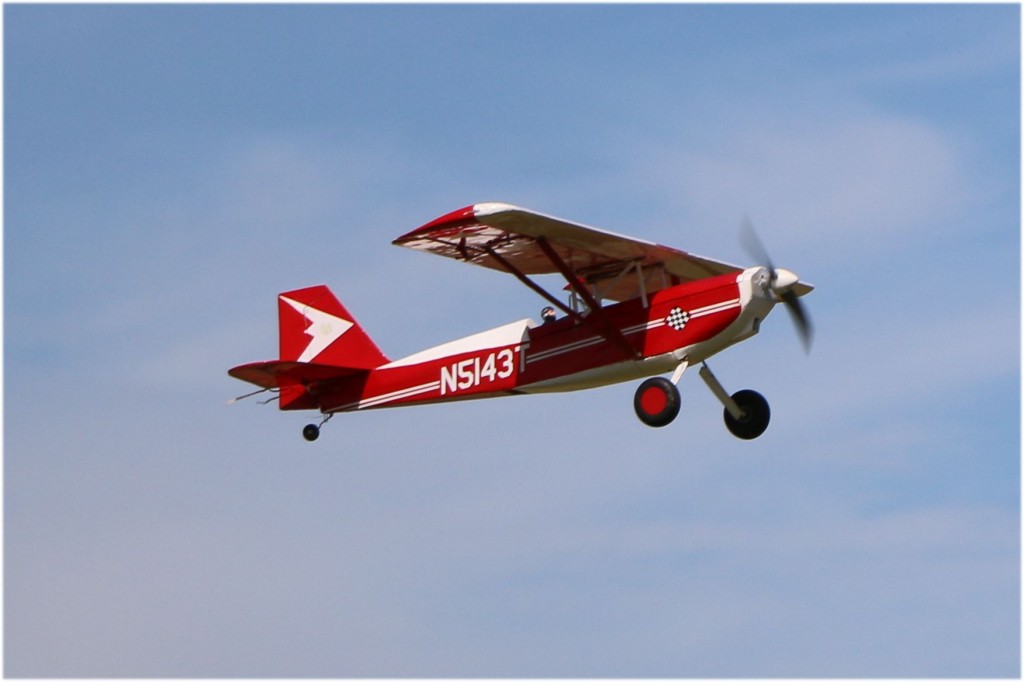 Dwayne Pipe’s Citabria Pro
Dwayne Pipe’s Citabria Pro
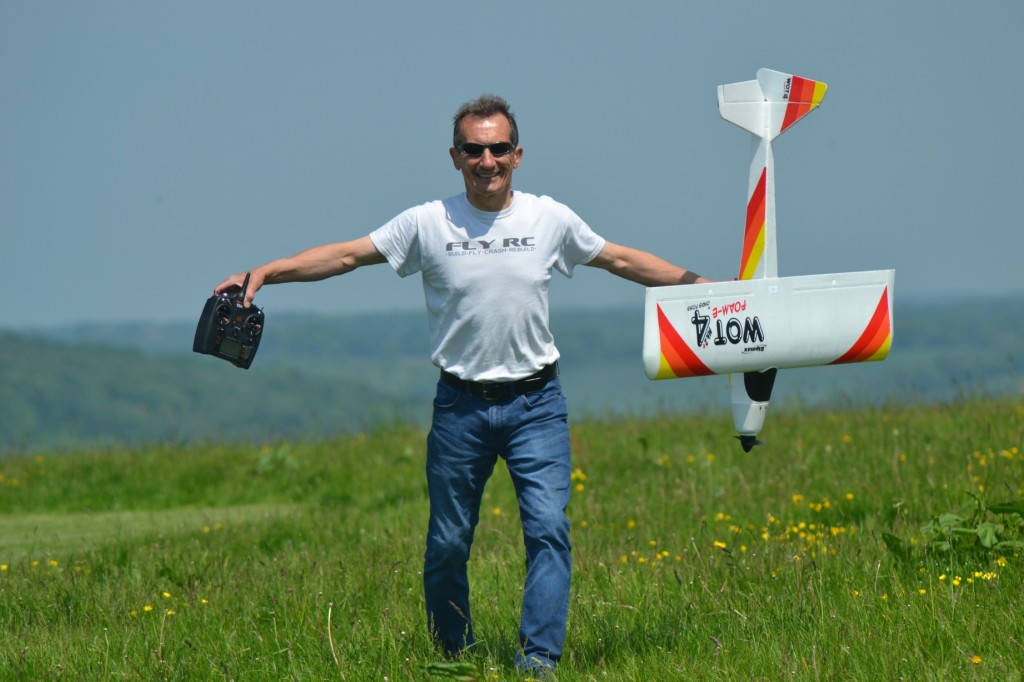 Woody, apparently happy with his landing!
Woody, apparently happy with his landing!
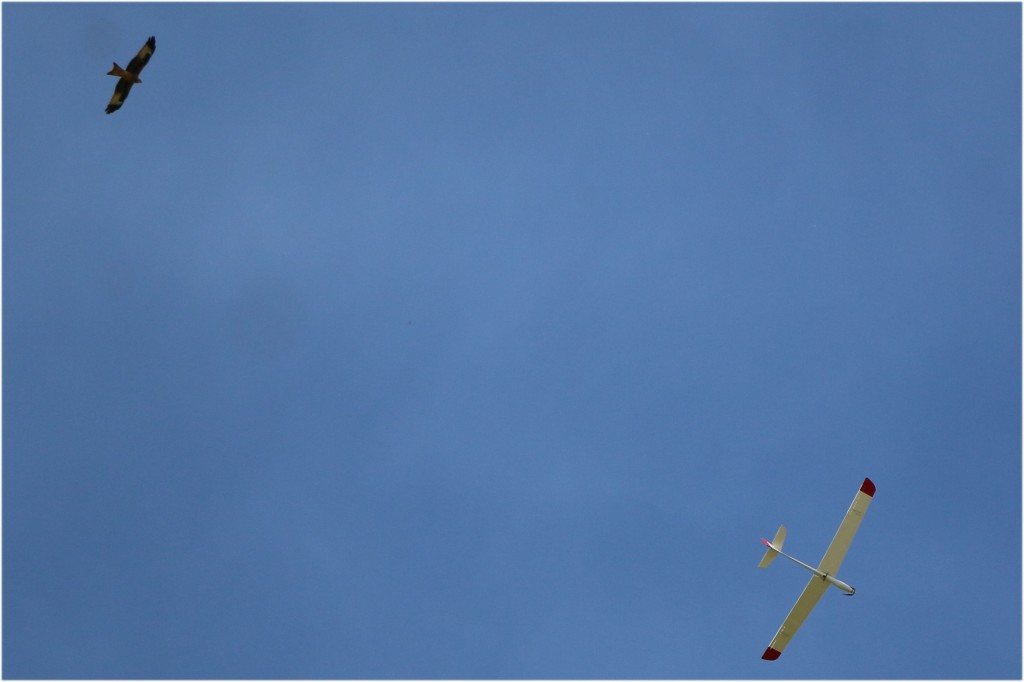 Dwayne Pipe’s Vega being shadowed by a Kite
Dwayne Pipe’s Vega being shadowed by a Kite
Please watch the video full screen, it’s so much better with small models flying around. If the video above won’t play for you CLICK HERE
On a flight with EasyJet back in 1997 the pilot made what can only be described as an extremely heavy landing at Luton. It was very early in the morning and a number of passengers looked quite alarmed as, apart from the noise, a number of overhead lockers dropped open and several items of carry-on luggage were launched down the aisle.
After slowing up, the aircraft turned off the runway towards the stand and over the PA came “Good morning ladies and gentlemen, this is Captain Smith, welcome to Luton. If any of you were asleep…I bet you’re not now!”
Colin Cowplain
Patch News – June 2016
Well so much for ‘flaming June’, it seemed more like April showers to me. Never mind, summer will be along in July…I hope. We had a bit of a problem with the mower a couple of Sundays ago and with the patch already in need of a cut and growing very quickly I thought we were going to be in trouble for a while. But I’m pleased to say our Chairman Percy Vears took immediate action to get it sorted and the patch is now in excellent condition again. Farmer George is letting the rest of the field grow for hay so it’s now pretty long all around the patch, but I don’t imagine it will be long before he cuts it. Take note of the grass length around the patch in this month’s video, it’s amazing how much the field grew in just 3 weeks. Still, we mustn’t complain, later in the year this might be happening for a while:
If the video above won’t play for you CLICK HERE
I’m sure you’ll want to join me in congratulating Tim ‘Modelling’ Clay and Lucy who got married on Saturday 25th June; we wish them all the best for a long and happy marriage. So what’s it got to do with Patch News? Well before the wedding Tim said he was sorry he hadn’t been flying much lately, he’d been really busy with all the wedding arrangements, but once the wedding is out of the way he’ll be at the field every week. Yeah yeah, dream on Modelling, see you around Christmas!
So what’s it got to do with Patch News? Well before the wedding Tim said he was sorry he hadn’t been flying much lately, he’d been really busy with all the wedding arrangements, but once the wedding is out of the way he’ll be at the field every week. Yeah yeah, dream on Modelling, see you around Christmas!
Early in the month Stanley Knife brought along his new Black Horse Models Wilga.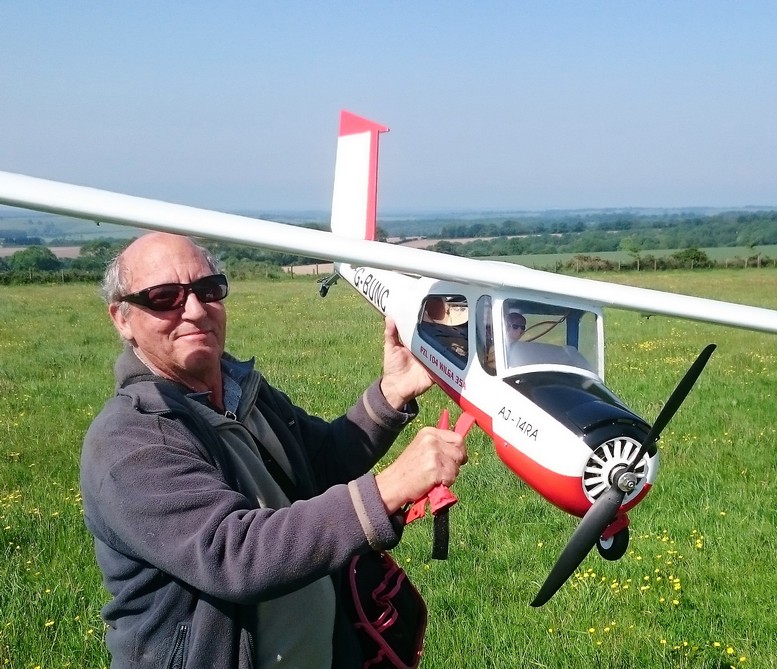 The full-size Wilga was produced by Polish company PZL from 1962 until 2006 with over 1000 being built in many different versions. The one Black Horse have modelled is a 35A (no, that’s not how much current it pulls!) which was a mass-produced basic variant for sports aviation. It was fitted with glider towing hook, and was produced from 1968. It was fitted with a radial engine and the wingspan was just over 11M (36½ feet).
The full-size Wilga was produced by Polish company PZL from 1962 until 2006 with over 1000 being built in many different versions. The one Black Horse have modelled is a 35A (no, that’s not how much current it pulls!) which was a mass-produced basic variant for sports aviation. It was fitted with glider towing hook, and was produced from 1968. It was fitted with a radial engine and the wingspan was just over 11M (36½ feet).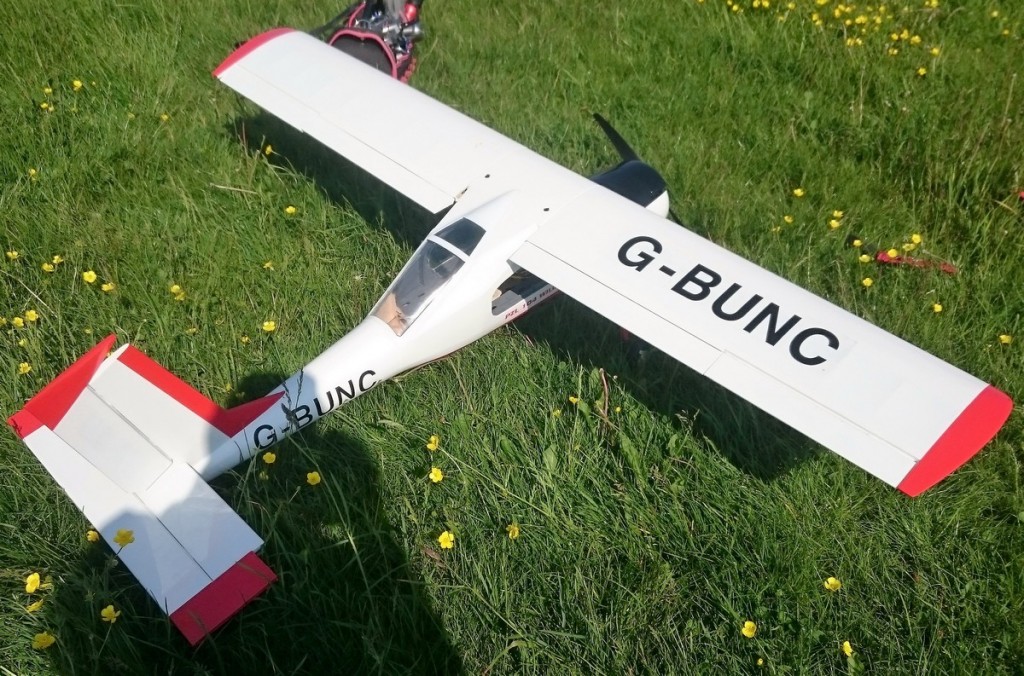 The Black Horse model spans 1,720mm (67.72 in) and weighs just under 4kg (around 8½ lbs). Stanley has fitted a Turnigy Aerodrive SK3 motor from HobbyKing and says it produces almost 1300W on 5 cells swinging a 16×10 prop. I think it must be the 5045 500kv motor that is rated for 5 to 7 cells.
The Black Horse model spans 1,720mm (67.72 in) and weighs just under 4kg (around 8½ lbs). Stanley has fitted a Turnigy Aerodrive SK3 motor from HobbyKing and says it produces almost 1300W on 5 cells swinging a 16×10 prop. I think it must be the 5045 500kv motor that is rated for 5 to 7 cells.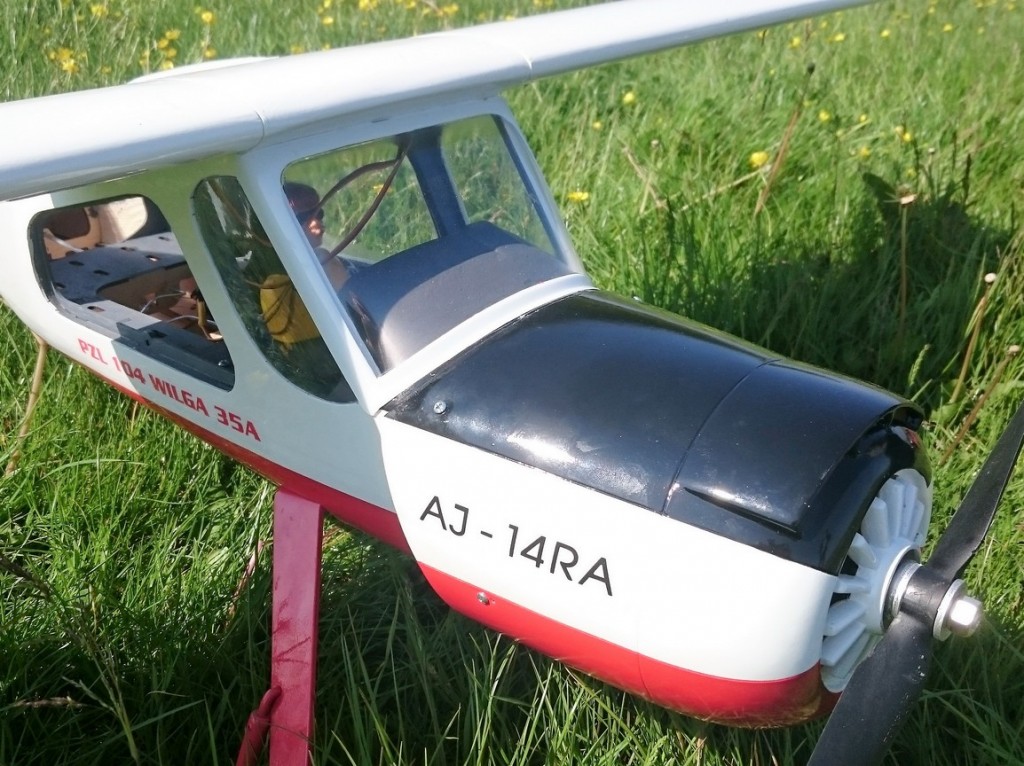 It certainly has plenty of power for the Wilga and the model stooges around beautifully on less than half throttle most of the time, only requiring more power to perform some gentle aerobatics.
It certainly has plenty of power for the Wilga and the model stooges around beautifully on less than half throttle most of the time, only requiring more power to perform some gentle aerobatics.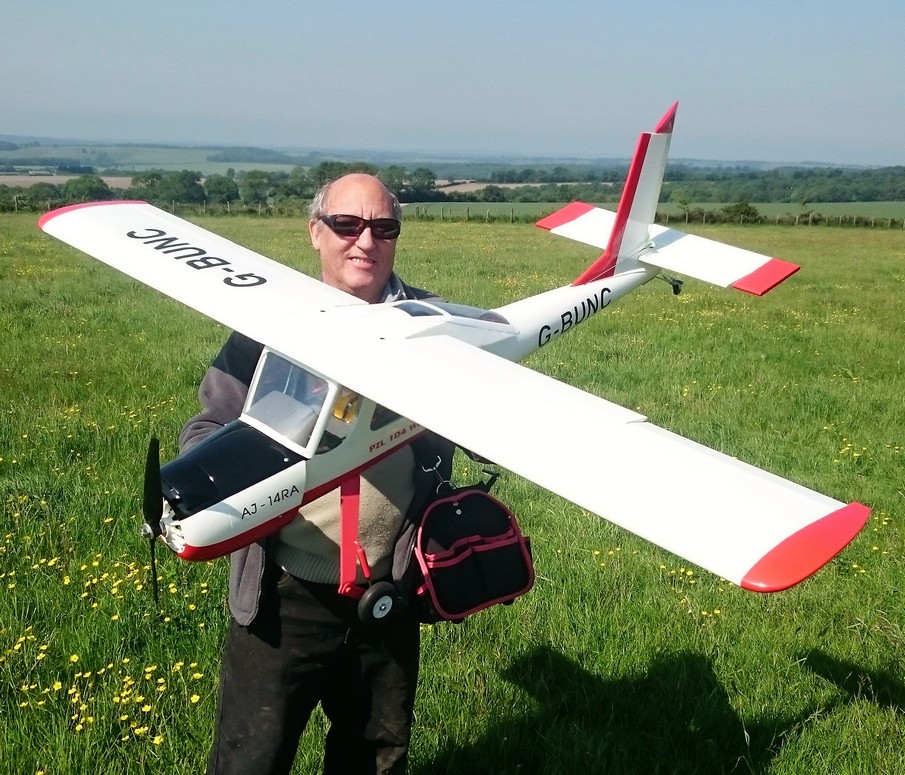 I recorded some of the first flight but managed to mess up and missed the landing (which was very good incidentally) and it can be seen in this month’s video at the end of this Patch News.
I recorded some of the first flight but managed to mess up and missed the landing (which was very good incidentally) and it can be seen in this month’s video at the end of this Patch News.
Also in the video is some footage of 1066 flying his Piper Cub/Grasshopper that I featured last month. He seems to have got the undercarriage sorted now and he did some circuits and mild aerobatics just for me to record.
Gentleman Jim has been flying his re-born Splot recently. Originally flown back in June 2014, Jim’s Splot performed well but eventually suffered what appeared to be some fairly minor damage. While undertaking the repairs Jim found there was more damage than first realised so decided to build a new fuselage instead of repairing the original one, and then went the whole hog and re-covered the rest of the model as well.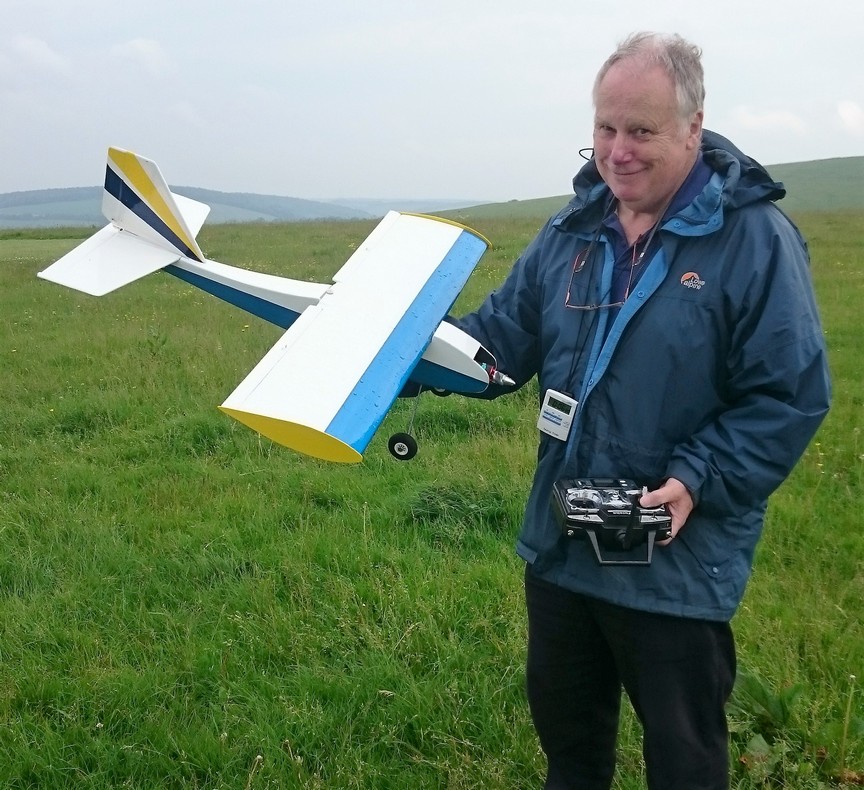
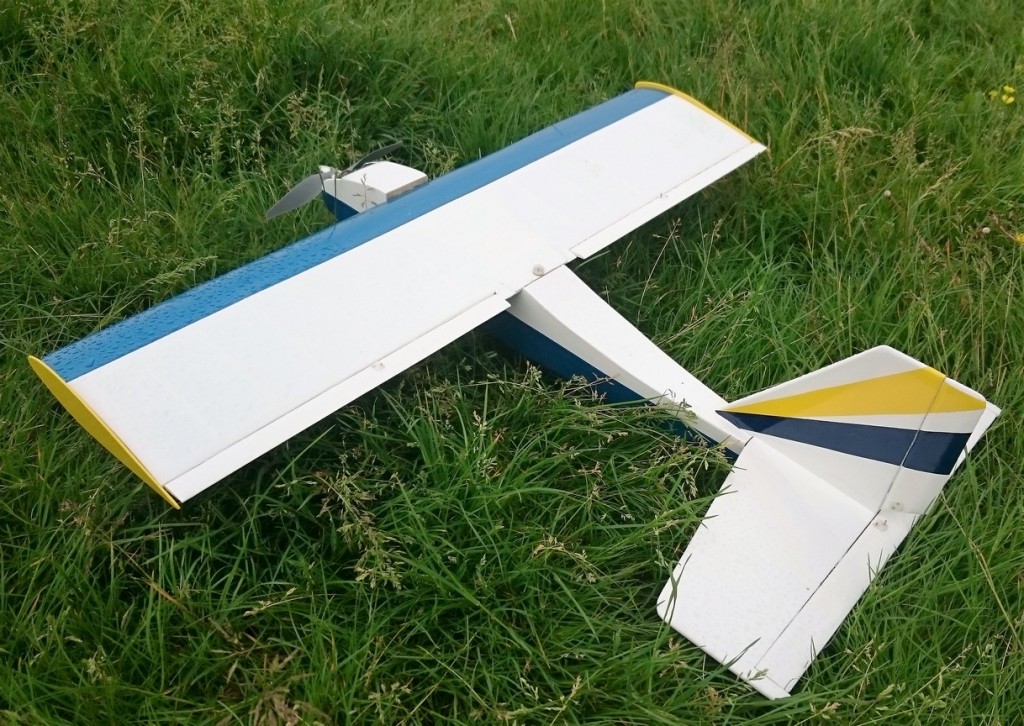 It looks great now, personally I prefer the new colour scheme, and it flies just like it always did.
It looks great now, personally I prefer the new colour scheme, and it flies just like it always did.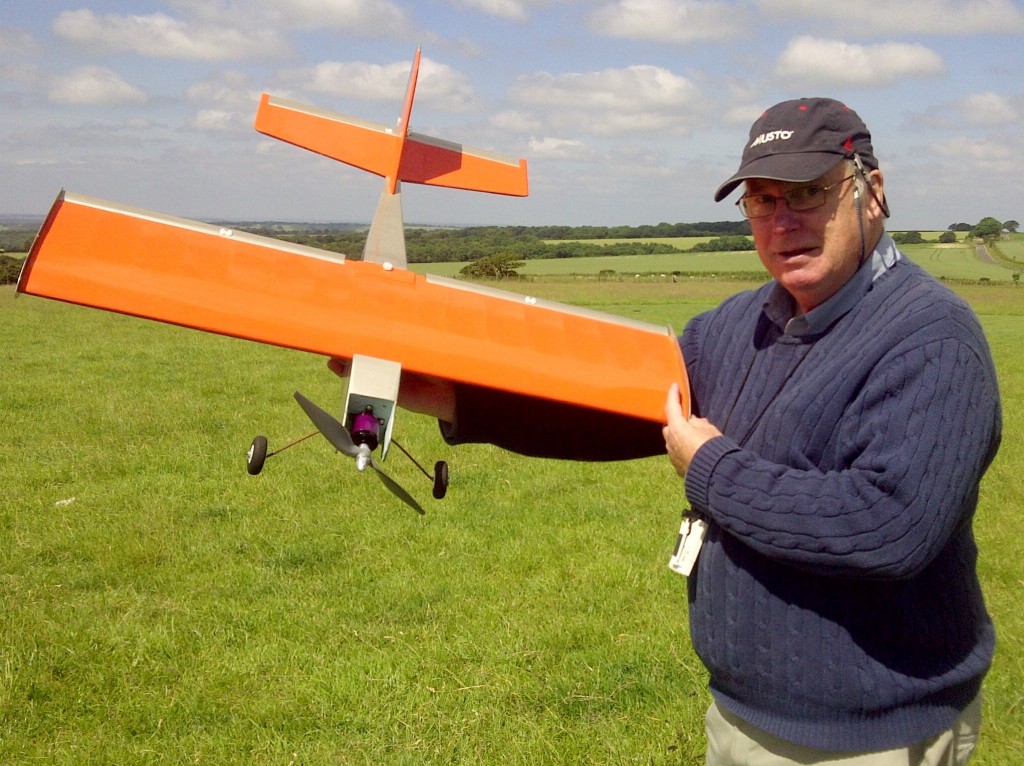 There are now more Splot plans available if anyone wants to build one, speak to The Squire and he’ll relieve you of £3.50 in exchange for one. I know there are several already underway but the more the merrier. Have a chat with Gentleman Jim, Percy Vears, or Basher Bob for further info on the power set-up they’ve used.
There are now more Splot plans available if anyone wants to build one, speak to The Squire and he’ll relieve you of £3.50 in exchange for one. I know there are several already underway but the more the merrier. Have a chat with Gentleman Jim, Percy Vears, or Basher Bob for further info on the power set-up they’ve used.
Wonky Wiltshire is always good for providing us with a laugh and he didn’t let us down this month. He turned up with a Radjet 800, an 800mm span foam flying wing from HobbyKing.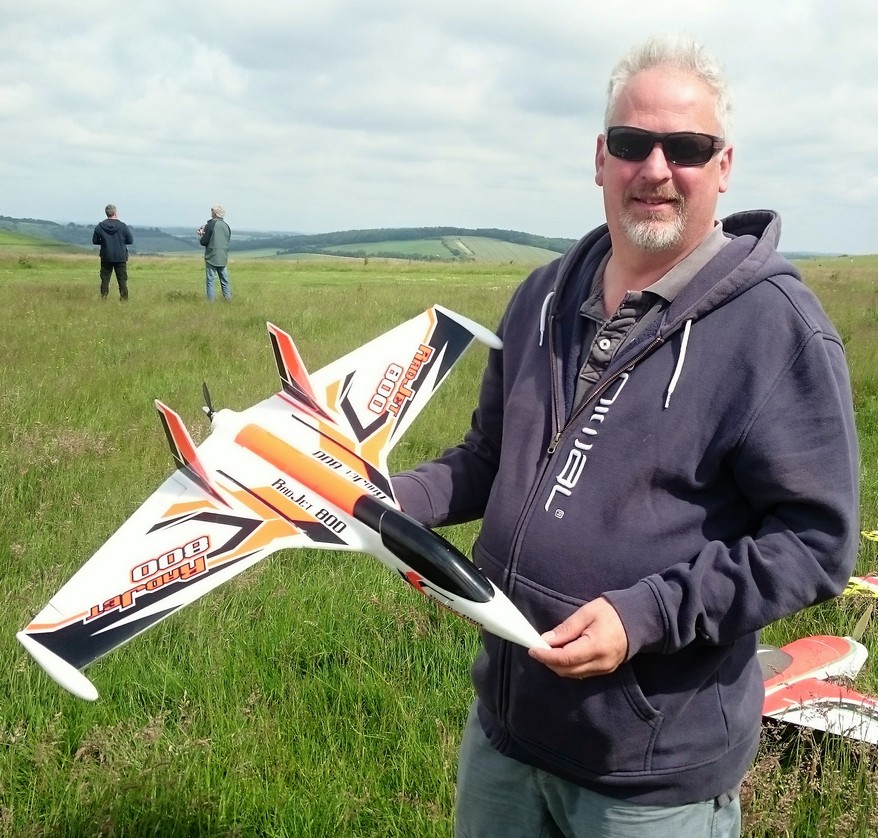 The website mentions a Plug’n’Fly version but only lists the Almost Ready To Fly version, and that’s the one Wonky bought. It comes with an 1850kv motor and a 6×4 prop but you have to provide your own speed controller and two 9g servos. It uses a 3 cell 1300mAh lipo which many of us already have. It’s not unlike the Wingnetics that several of us fly but it has a pusher motor, is a little larger, and is a true flying wing in that it doesn’t have a separate elevator. This means you must use a transmitter that has elevon mixing, but virtually all transmitters have that these days. It’s easy enough to hand launch and the pusher prop doesn’t bite you as you let go!
The website mentions a Plug’n’Fly version but only lists the Almost Ready To Fly version, and that’s the one Wonky bought. It comes with an 1850kv motor and a 6×4 prop but you have to provide your own speed controller and two 9g servos. It uses a 3 cell 1300mAh lipo which many of us already have. It’s not unlike the Wingnetics that several of us fly but it has a pusher motor, is a little larger, and is a true flying wing in that it doesn’t have a separate elevator. This means you must use a transmitter that has elevon mixing, but virtually all transmitters have that these days. It’s easy enough to hand launch and the pusher prop doesn’t bite you as you let go!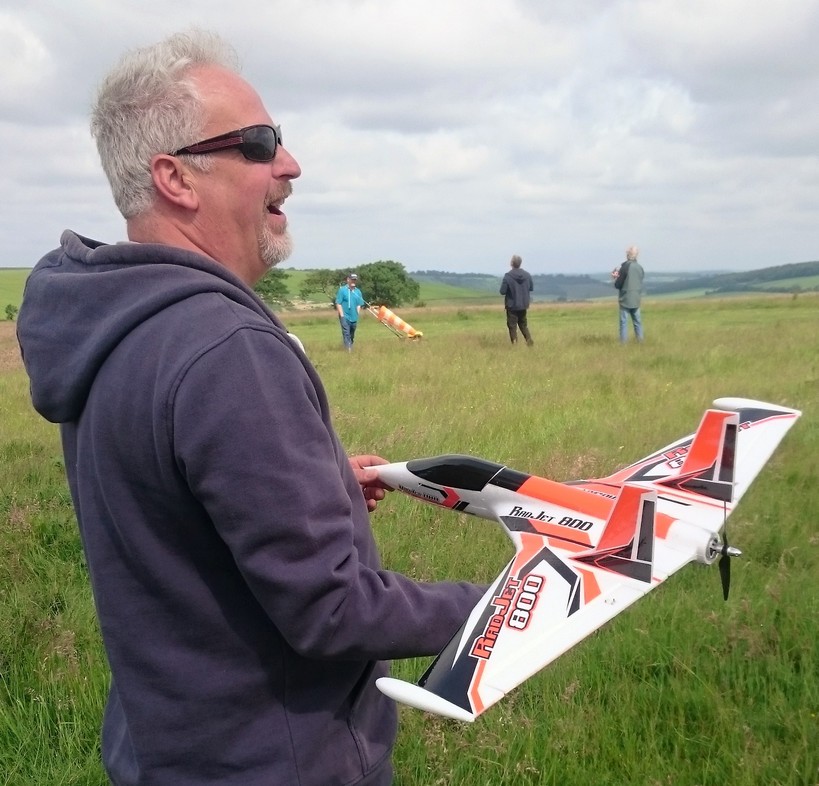 Wonky’s first flight went very well, the thing really shifts, quicker than a Wingnetic I think, so you need to be careful not to let it get too far away. The amusement came when I picked it up to launch it for the second flight…and one wing fell off! Well not quite but very nearly, it certainly would have if it had got airborne!
Wonky’s first flight went very well, the thing really shifts, quicker than a Wingnetic I think, so you need to be careful not to let it get too far away. The amusement came when I picked it up to launch it for the second flight…and one wing fell off! Well not quite but very nearly, it certainly would have if it had got airborne!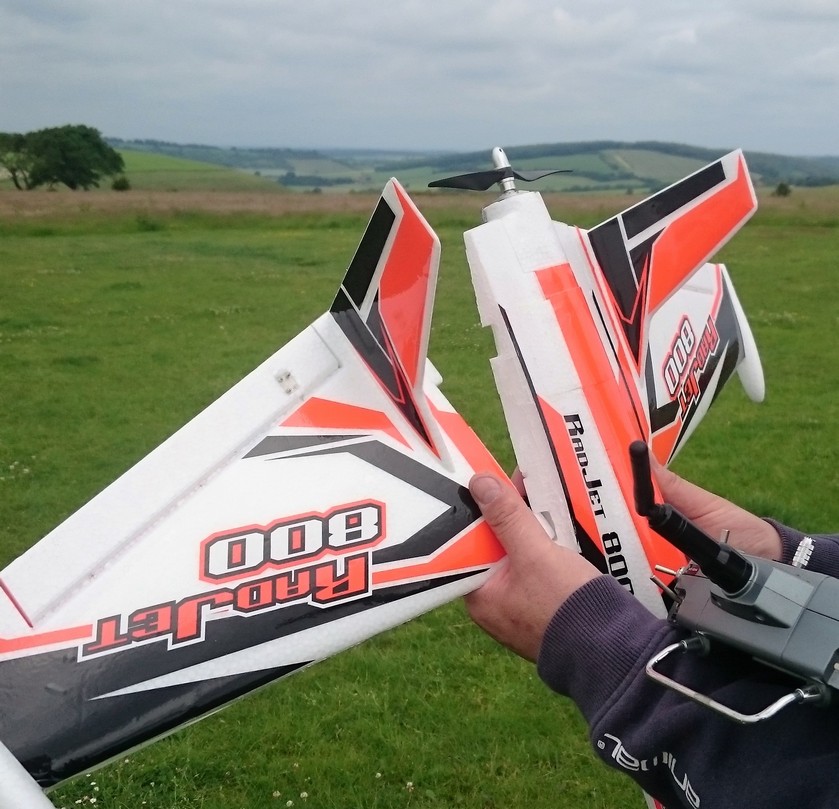 I’m not sure what kind of glue Wonky used but it obviously wasn’t quite up to the job. Reading the comments on the website the most common suggestion seems to be for thick cyano and kicker. Anyway, by the following Sunday it was all sorted and screaming around with no problems at all. HobbyKing also sell a Radjet 420 which, unsurprisingly, is 420mm span. Chris Hard, lover of flying wings in general, has one and it flies just as well as the 800 version but disappears even faster. If my memory serves me correctly Chris also has an 800 so we might see two of them flying together one day.
I’m not sure what kind of glue Wonky used but it obviously wasn’t quite up to the job. Reading the comments on the website the most common suggestion seems to be for thick cyano and kicker. Anyway, by the following Sunday it was all sorted and screaming around with no problems at all. HobbyKing also sell a Radjet 420 which, unsurprisingly, is 420mm span. Chris Hard, lover of flying wings in general, has one and it flies just as well as the 800 version but disappears even faster. If my memory serves me correctly Chris also has an 800 so we might see two of them flying together one day.
Have you spotted the PAM transmitter hog at the patch? Yes Dougal Entendre has bought yet another transmitter, and yes, it’s another Walkera Devo. He’s now got so many Devo receivers it would mean a major upheaval and huge cost to switch brands. I think he’s working on the premise that each time he buys a transmitter it comes with a receiver so he’s saving money; at least that’s what he tells Angie. The latest purchase is a Walkera Devo F12E 5.8 GHz 32CH Dual Transmission FPV Radio System Transmitter, wow, that’s quite a name!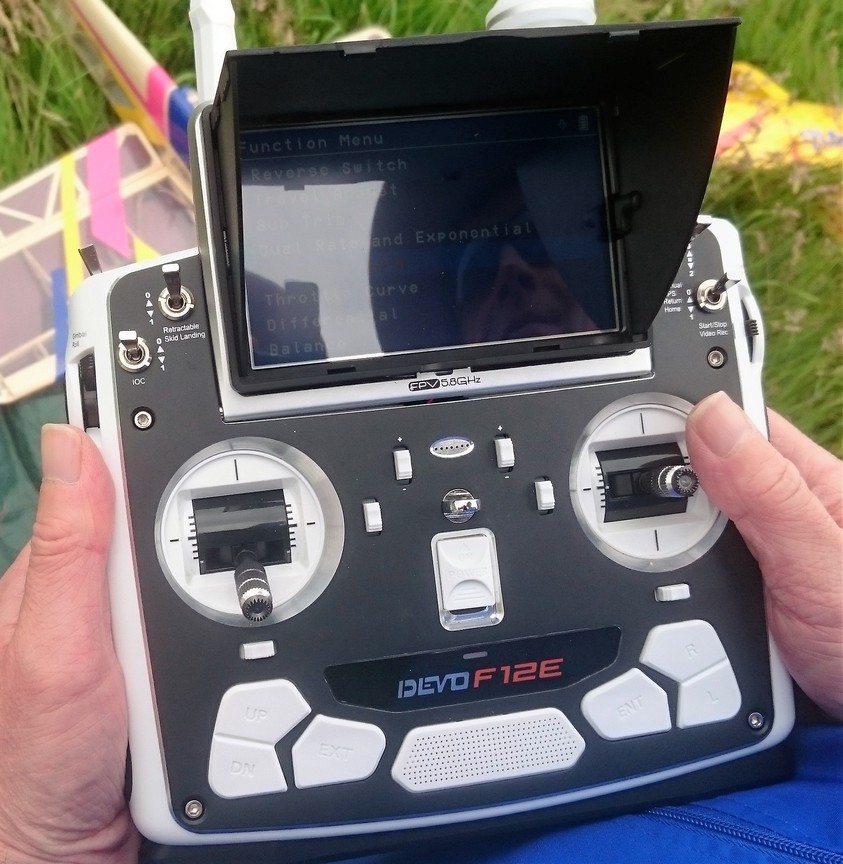 Basically it’s a ‘normal’ 2.4 GHz 12 channel transmitter with a 32 channel 5.8 GHz FPV (First Person View) image receiver built into it. It has a 5” full colour screen that in normal use displays all the usual tx functions such as rates, servo reversing, mixing and so on. But if you fly FPV is displays the image from the camera on the screen so you can fly looking at the screen rather than using a separate pair of FPV goggles. Dougal says that at the moment he’s not intending using it for FPV but that may change in the future. As you’d expect with a 12 channel transmitter it can do just about everything ever dreamed up plus a few more things besides, and it has telemetry so if you equip your model with the right sensors it can display all the information you want from the model in real-time on the screen. The screen has a shield around it to stop the sun’s glare and reflections; it doesn’t show very well on my offset photo but is fine when viewed from straight ahead. Once he’d satisfied himself that he’d got everything set correctly Dougal flew various models with it last Sunday and everything seemed to be working perfectly. Here’s a photo of Dougal trying to switch it on!
Basically it’s a ‘normal’ 2.4 GHz 12 channel transmitter with a 32 channel 5.8 GHz FPV (First Person View) image receiver built into it. It has a 5” full colour screen that in normal use displays all the usual tx functions such as rates, servo reversing, mixing and so on. But if you fly FPV is displays the image from the camera on the screen so you can fly looking at the screen rather than using a separate pair of FPV goggles. Dougal says that at the moment he’s not intending using it for FPV but that may change in the future. As you’d expect with a 12 channel transmitter it can do just about everything ever dreamed up plus a few more things besides, and it has telemetry so if you equip your model with the right sensors it can display all the information you want from the model in real-time on the screen. The screen has a shield around it to stop the sun’s glare and reflections; it doesn’t show very well on my offset photo but is fine when viewed from straight ahead. Once he’d satisfied himself that he’d got everything set correctly Dougal flew various models with it last Sunday and everything seemed to be working perfectly. Here’s a photo of Dougal trying to switch it on!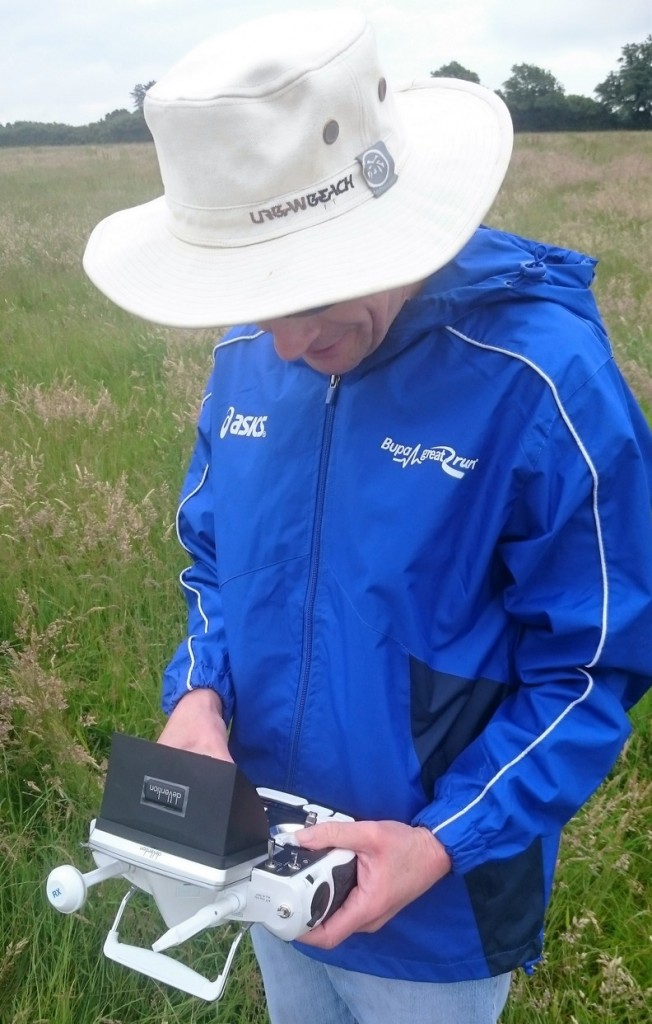 So there you are, if you want a transmitter that can do absolutely everything including FPV all you need is a Devo F12E…oh, and a degree or two in electronics and computer programming. And yes, Dougal has.
So there you are, if you want a transmitter that can do absolutely everything including FPV all you need is a Devo F12E…oh, and a degree or two in electronics and computer programming. And yes, Dougal has.
One model that hasn’t quite made it to the patch yet is Gorgeous Gary’s new Midget Mustang. Gary is a recent convert to the joys of electric power but has now had quite a few flights with the Acro Wot that he converted to electric. He is slowly getting his head around working out which motor, prop, esc, and battery combinations are needed to power different models and by doing a conversion on the Acro Wot he learnt a lot more than he would have by simply buying something already set up with electric power. He’s chosen the Black Horse 1000mm span Midget Mustang as his next model.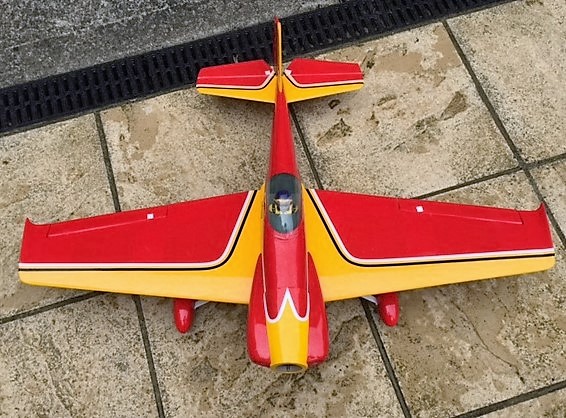
It looks absolutely fantastic, sleek and purposeful with a great colour scheme, although I’m not sure those spats will last too long on our patch. It’s designed for electric power from the start but Gary still had to source his own motor etc. Having used as OS electric motor in the Acro Wot he decided to stick with OS, this time choosing an OMA-3820-1200-W. I’ve looked at the motor specs on the OS website and it’s capable of delivering up to 1000W on 4 cells and on 3 cells the output stated is between 529W and 945W depending on the prop. Black Horse reckon the weight is around 3lbs so it’s certainly not going to be short of power! I also had a quick look on the forums and there is talk of the correct CG being at around 80mm not the 100mm stated in the manual and that it needs weight in the nose to achieve this so going for a bigger and heavier motor than they recommend is probably no bad thing.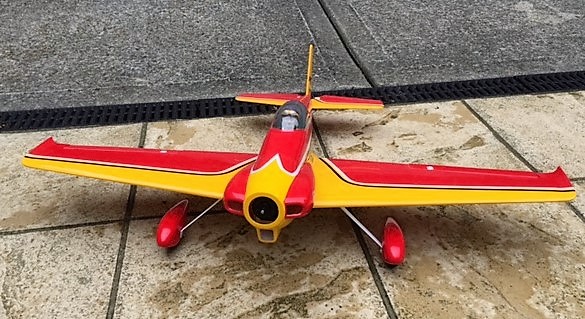
So there we have it, an over-powered tail-heavy racer with wheel spats…what could possibly go wrong?!
Speaking of things going wrong, this month we saw two unfortunate incidents which caused ‘modifications’ on take-off. One was due to the owner forgetting to change the model memory over to the correct model and not noticing the ailerons were reversed, the other was following a repair and presumably a servo swap or similar as, it too, attempted flight with reversed ailerons. It’s very easy to be smug when others make mistakes but this is something we’ve all done at some time or other. Including me? Yes…twice.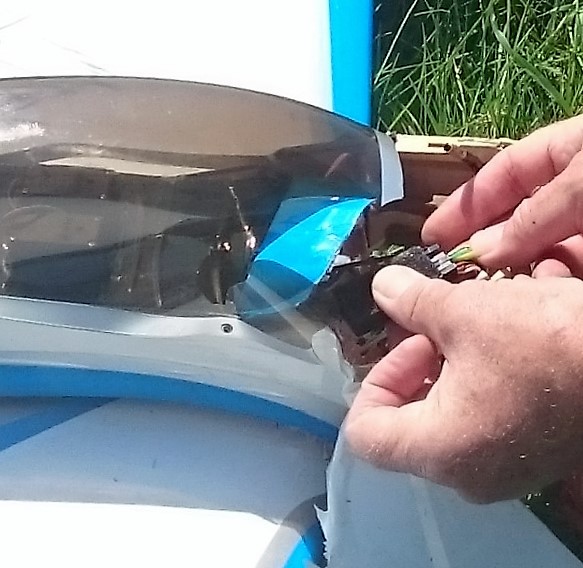
It’s shocking to see models damaged unnecessarily like that when the answer is so simple, check the DIRECTION of movement of all the controls, not just that they move, before EVERY flight.
The last new model that I spotted in June was yet another 3D machine from 1066.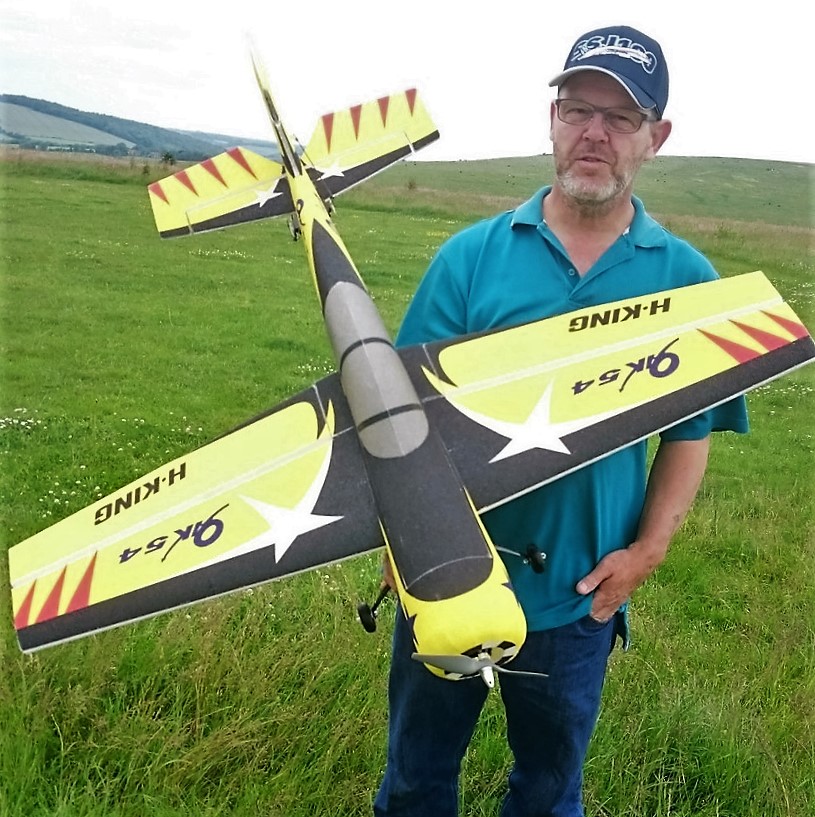 This one is a 1230mm wingspan YAK 54 from HobbyKing and it’s another in the range of EPP skinning over a balsa/ply frame. Using this type of construction means the finished model can have a ‘proper ‘ shape, not just a profile fuselage, and yet it’s still extremely light and very strong. This photo from the HobbyKing webpage shows the construction well. The cowl assembly is simply held on by a couple of magnets!
This one is a 1230mm wingspan YAK 54 from HobbyKing and it’s another in the range of EPP skinning over a balsa/ply frame. Using this type of construction means the finished model can have a ‘proper ‘ shape, not just a profile fuselage, and yet it’s still extremely light and very strong. This photo from the HobbyKing webpage shows the construction well. The cowl assembly is simply held on by a couple of magnets!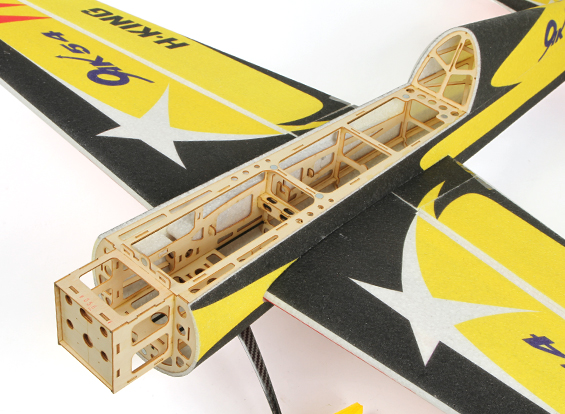
A few years ago we wouldn’t have believed a 48½” model could weigh just 1220gms (2lbs 10zs). I used to put batteries weighing 2lbs in a 4ft model! Although it’s obviously strong enough to withstand all the 3D stuff thrown at it I’m not so sure about crash resistance or ease of repair. Not that 1066 will ever need to repair anything on the model obviously…ever…
Chris P Bacon has been off to visit a couple shows lately, the ones at Long Marston and Weston Park, and he was good enough to send me a few photos. This selection is mostly from Weston Park.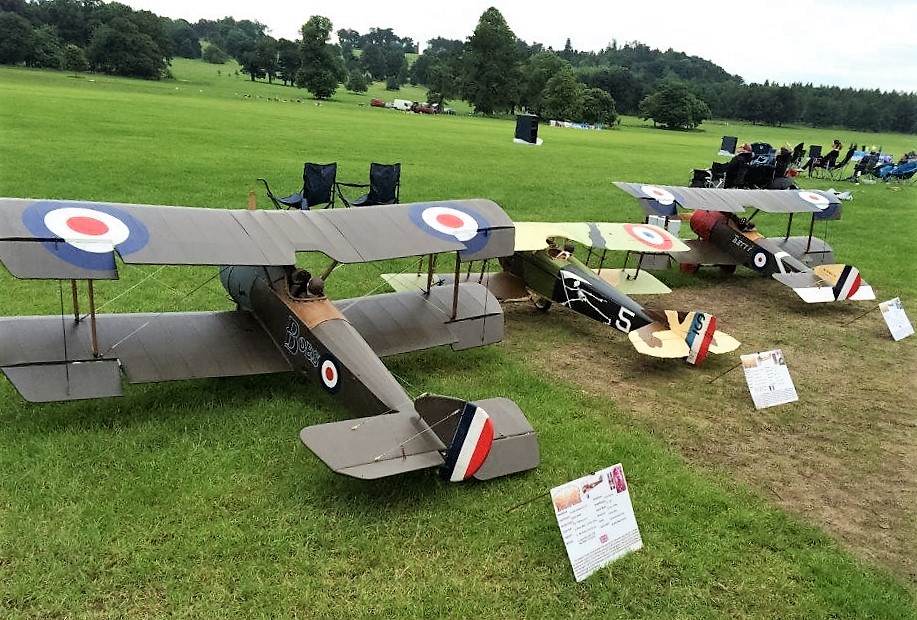
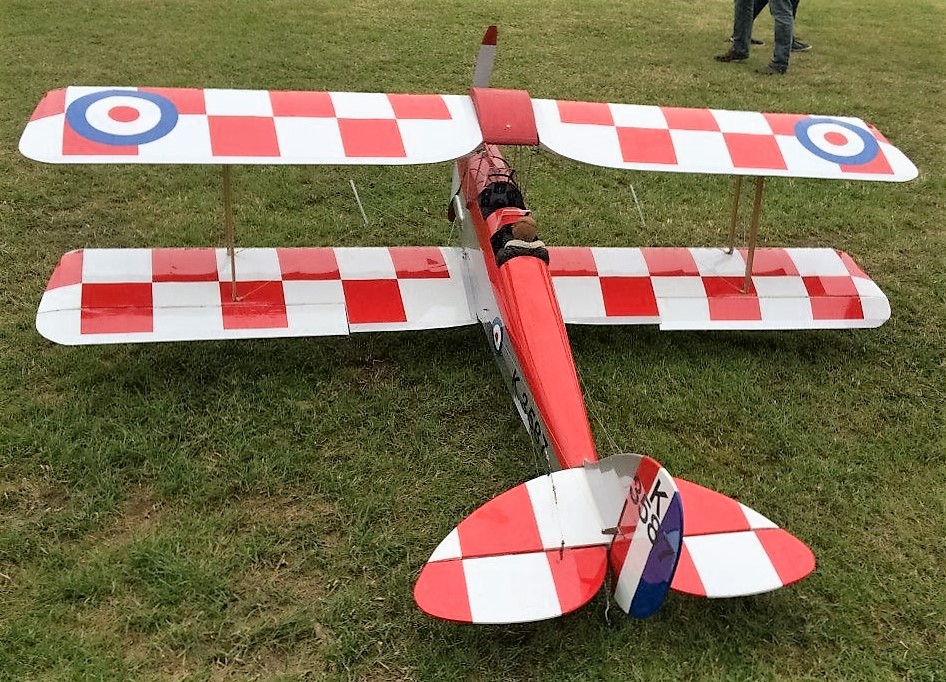
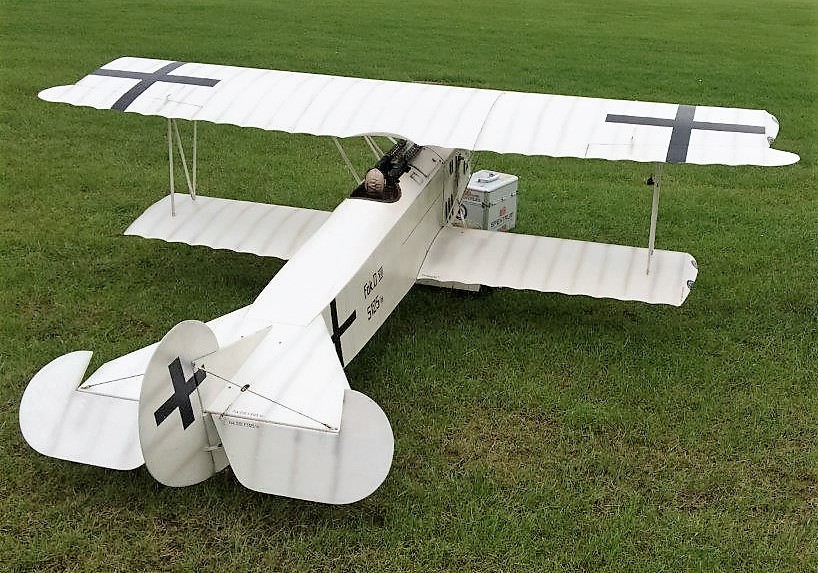
Has our Gorgeous Gary decided to go back to using small I/C motors again?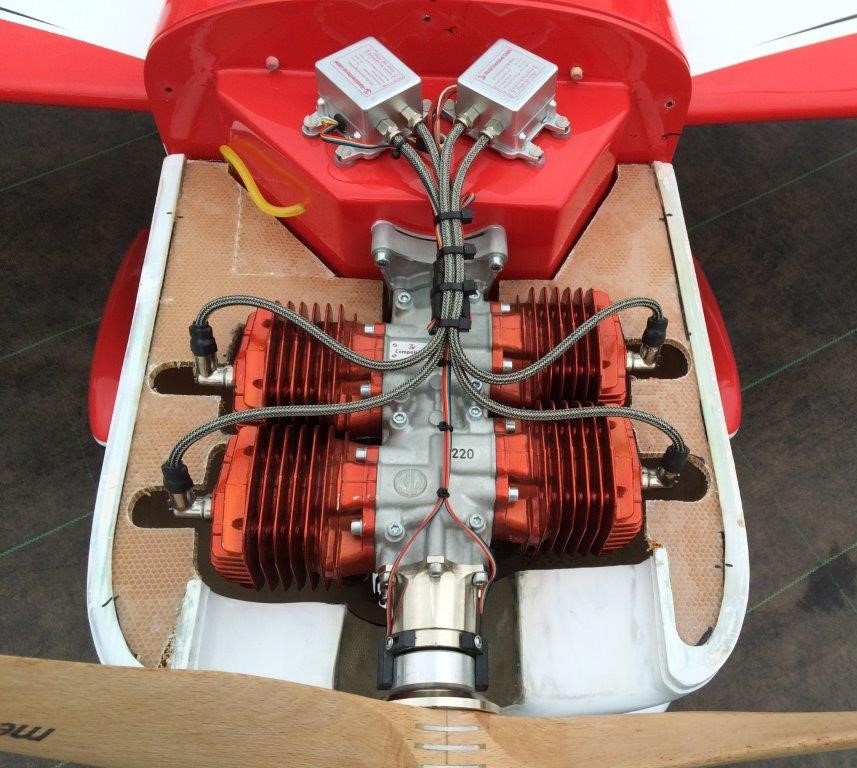
This Mustang appears to be owned by a Petersfield Aero Modellers member.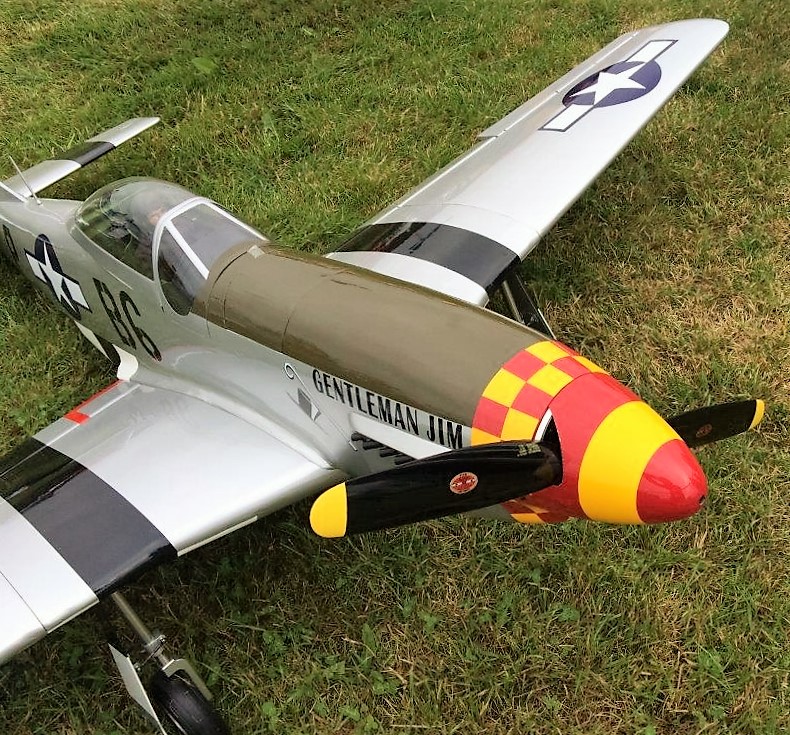
Chris P says he thinks this one is Smiffy’s latest model.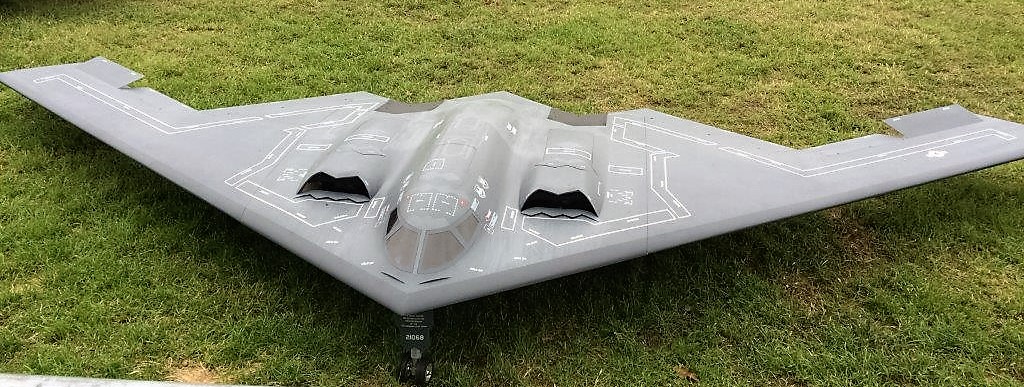 But I know the truth, I’ve already seen Smiffy’s latest model under construction!
But I know the truth, I’ve already seen Smiffy’s latest model under construction!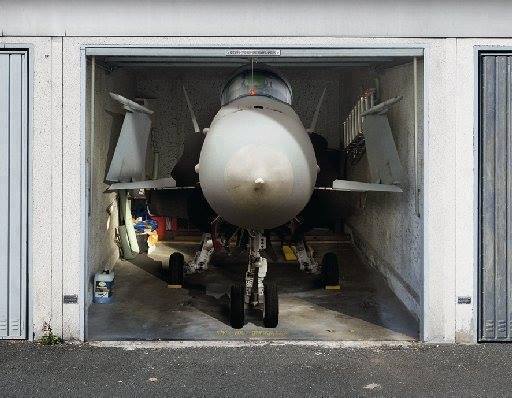
Please watch the video full screen, it’s so much better with small models flying around. If the video above won’t play for you CLICK HERE
In occupied Holland the Germans built a decoy airfield that led to a tale that has been told and retold ever since by veteran Allied pilots.
The German “airfield”, constructed with meticulous care, was made almost entirely of wood. There were wooden hangars, oil tanks, gun emplacements, trucks, and aircraft.
The day finally came when the decoy was finished, down to the last wooden plank.
Early the following morning, a lone RAF plane crossed the Channel, came in low, circled the field once…and dropped a large wooden bomb.
Colin Cowplain
Patch News – May 2016
Times flies, I’ve just realised it’s almost month end and I haven’t even started Patch News, so this edition may be a little rushed! There was lots of flying during May and, although I was away for a couple of weeks, I made it to the patch several times and I took lots of photos. The grass has now started growing in earnest and the patch has been mown several times already. Squire Nick snapped this photo of 1066 helping some poor old bugger who was exhausted by pushing the mower.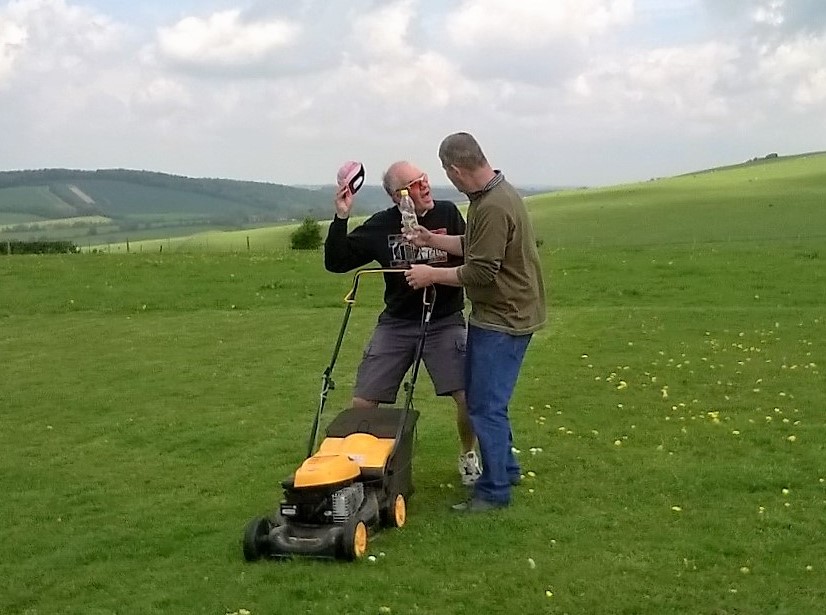
We have recently been joined by a prospective member, Terry, from Southampton. He is already a member of Firebirds Model Club and has been flying a three channel foamie Cub and an E-Flite Apprentice.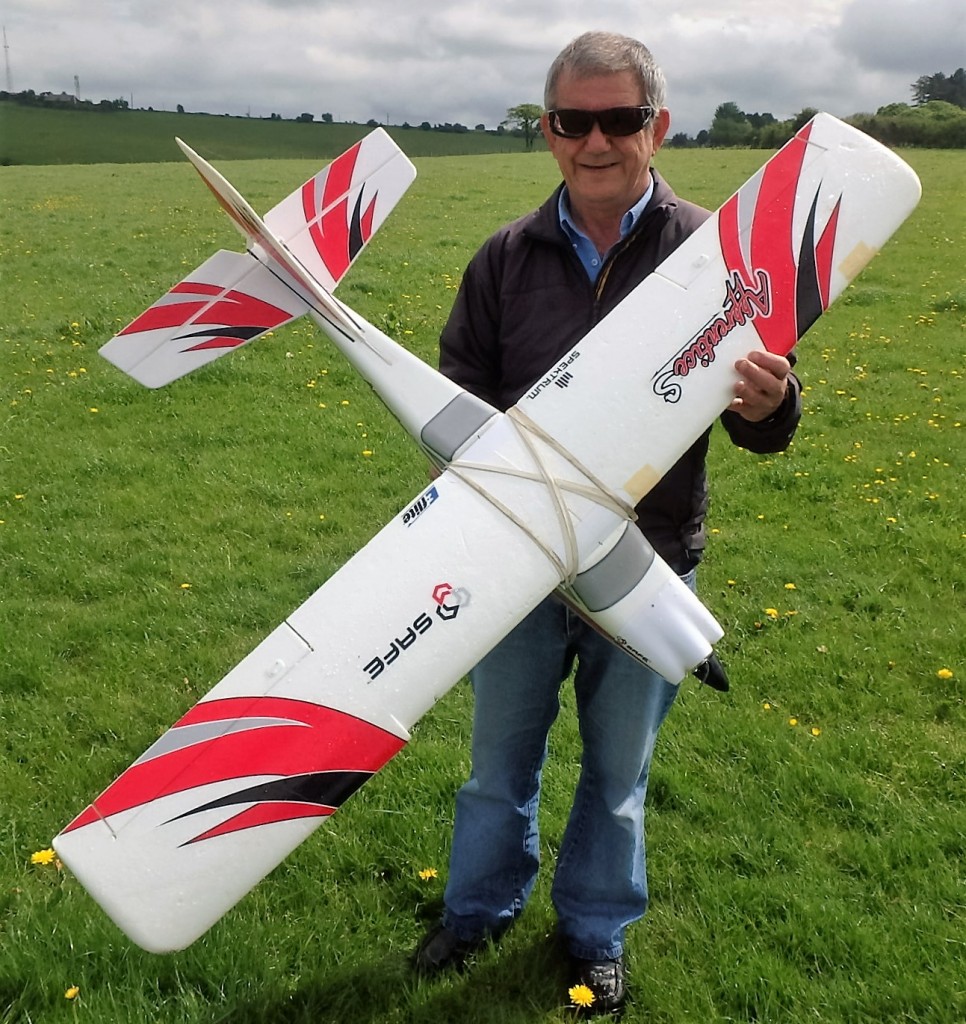 I think Dougal has mostly been looking after Terry as he works his way towards taking his ‘A’ certificate. Another ‘A’ certificate candidate is Mike Creamer and he is coming along very well as can be seen in this month’s video at the end of Patch News.
I think Dougal has mostly been looking after Terry as he works his way towards taking his ‘A’ certificate. Another ‘A’ certificate candidate is Mike Creamer and he is coming along very well as can be seen in this month’s video at the end of Patch News.
Last month I featured the wreckage of Dougal Entendre’s Wingnetic, it took him several attempts to achieve total destruction but he got there in the end! Throughout May both Catapult King and I have been flying our new Wingnetics and neither of us have had any destructive problems with ours.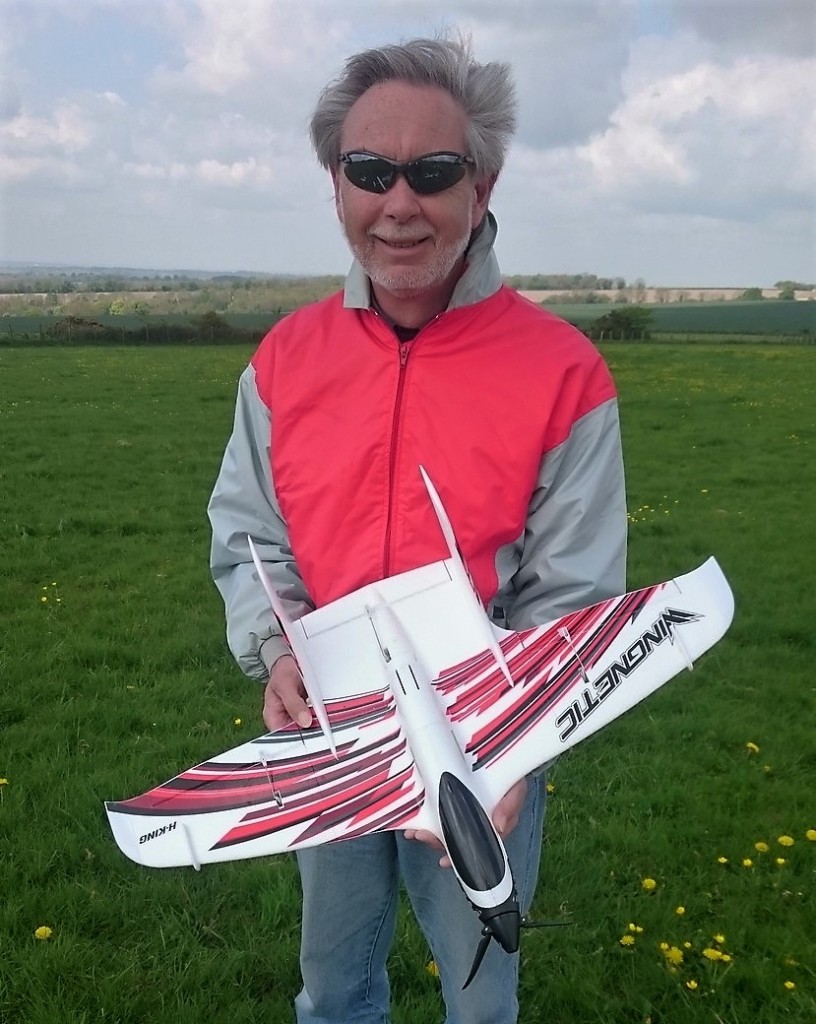 They are great little planes that have a very wide envelope of performance. Dougal’s now fits nicely into a small envelope! I haven’t flow Catapult’s Wingnetic yet so I’m not sure how twitchy his set-up is but mine is pretty hairy. I’ve got large movements on the surfaces and even with a lot of exponential dialled in it’s quite a handful when flown flat out, I may have to up the expo even further.
They are great little planes that have a very wide envelope of performance. Dougal’s now fits nicely into a small envelope! I haven’t flow Catapult’s Wingnetic yet so I’m not sure how twitchy his set-up is but mine is pretty hairy. I’ve got large movements on the surfaces and even with a lot of exponential dialled in it’s quite a handful when flown flat out, I may have to up the expo even further.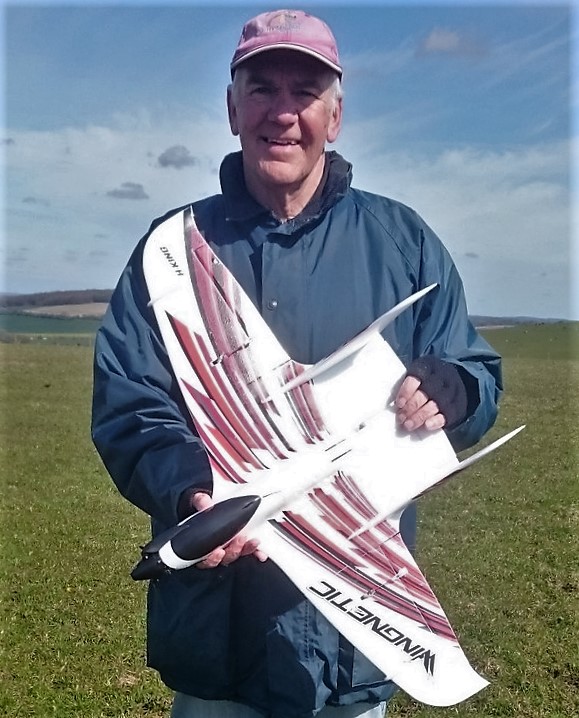
My favourite manoeuvre at the moment is to climb until it’s a speck, and then perform a vertical dive (motor off) with full aileron applied. It rotates at an incredible speed with the rotations getting faster and faster as it descends. It looks as if it will destroy itself on the pull-out but it’s a strong little model. I’ve resisted the inevitable shouts of “LOWER!” from the pits; I don’t want to perform a ‘Dougal Demise’.
There was a very strange mid-air collision this month, featuring 1066’s Mini Sbach 342 and Tony Neal’s Durafly T-28 Trojan. I didn’t see what happened so I can’t apportion blame; I just heard a bang and looked up to see a cloud of descending debris. The Sbach definitely won the battle and it looks as if the only damage was the neat removal of the nose, complete with motor.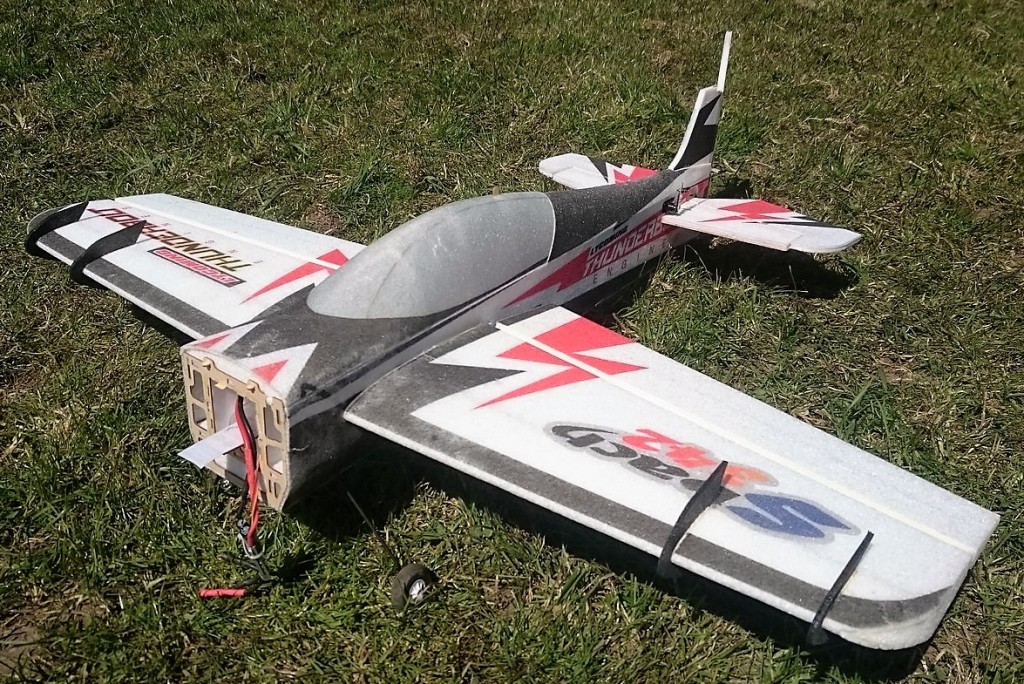 The poor Trojan fared rather more badly, amongst other damage one wing was reduced to a few pieces of foam clinging vainly to the spar.
The poor Trojan fared rather more badly, amongst other damage one wing was reduced to a few pieces of foam clinging vainly to the spar.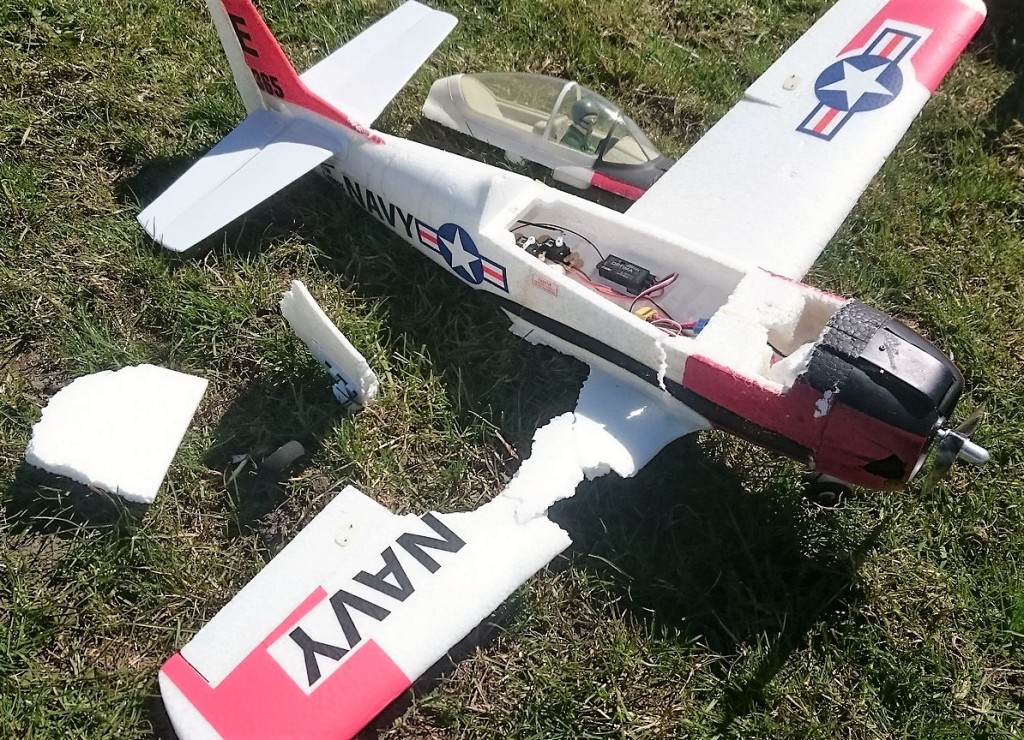 So what was strange about this collision? It didn’t involve Basher Bob!
So what was strange about this collision? It didn’t involve Basher Bob!
Speaking of Basher, he brought two new models along during May. The first is an Alpha Jet Mk2 from FRC Foamies. Not sure why it’s called that as it’s nothing like an Alpha Jet, it’s a very futuristic looking delta made from Depron.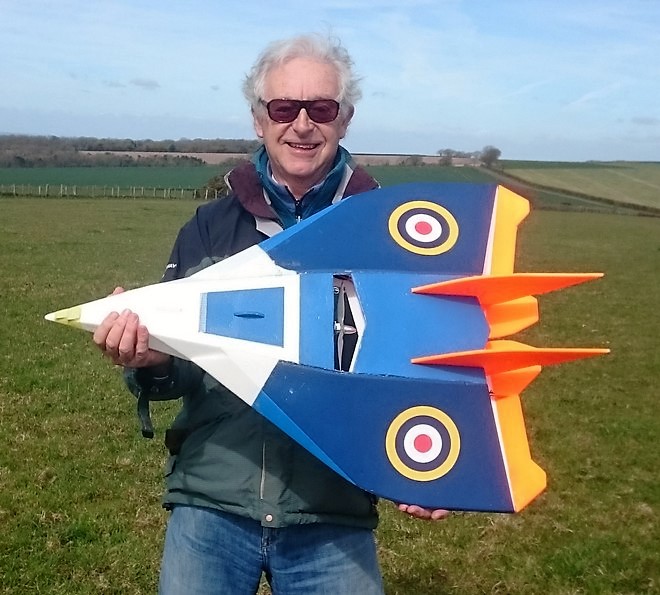 You can read all about the Alpha Jet and others on the FRC Foamies website if you CLICK HERE. I assume FRC Foamies just sell the plans and sheets of Depron rather than a proper kit. It looks as if it should be ducted fan but in fact it has a centrally mounted motor driving a conventional propeller.
You can read all about the Alpha Jet and others on the FRC Foamies website if you CLICK HERE. I assume FRC Foamies just sell the plans and sheets of Depron rather than a proper kit. It looks as if it should be ducted fan but in fact it has a centrally mounted motor driving a conventional propeller.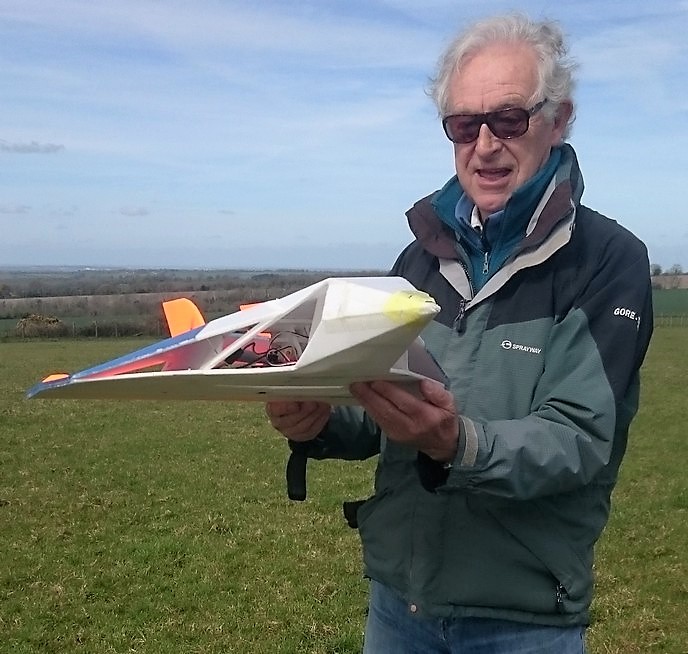 I test flew it and it flew pretty well although it was very twitchy on ailerons at first, but unfortunately it was very noisy. That is a problem we often find with propellers that are mounted either through the wing (as in this case) or very close to the wing trailing edge. The first flight was with a 4 cell lipo and there was more than enough power so Basher swapped to a 3 cell pack in an effort to reduce the noise but sadly it didn’t make a huge difference. I’m not sure if there’s a way to cure it without a major redesign so we may not see much of it in the future.
I test flew it and it flew pretty well although it was very twitchy on ailerons at first, but unfortunately it was very noisy. That is a problem we often find with propellers that are mounted either through the wing (as in this case) or very close to the wing trailing edge. The first flight was with a 4 cell lipo and there was more than enough power so Basher swapped to a 3 cell pack in an effort to reduce the noise but sadly it didn’t make a huge difference. I’m not sure if there’s a way to cure it without a major redesign so we may not see much of it in the future.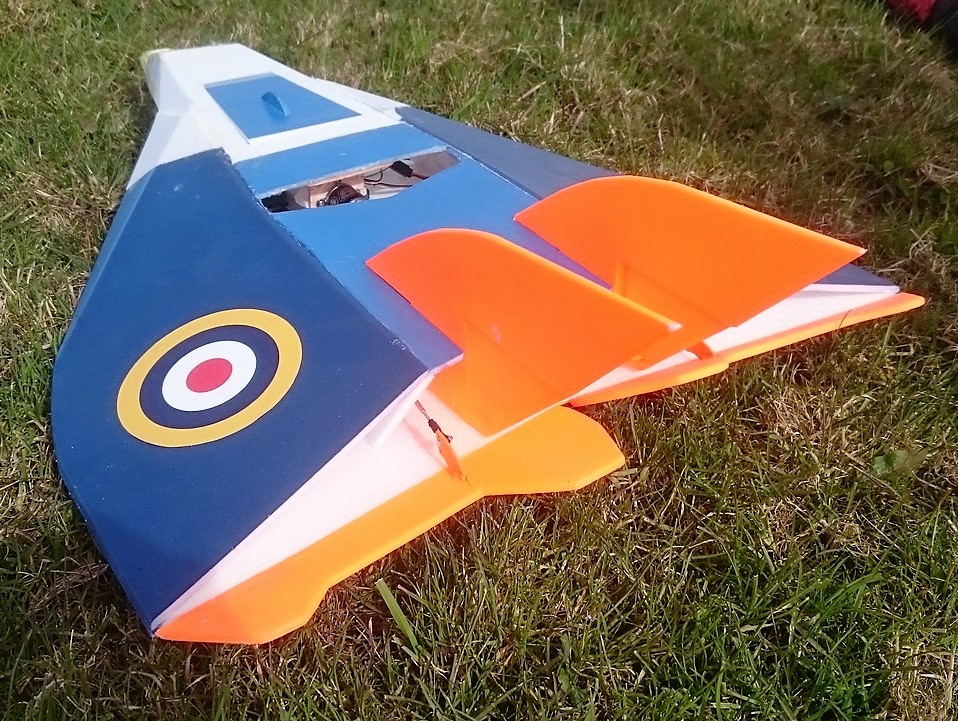 I managed to record a brief bit of Basher flying the Alpha Jet which can be seen in this month’s video.
I managed to record a brief bit of Basher flying the Alpha Jet which can be seen in this month’s video.
Basher’s other new model is an HK Walrus, a 1400mm span foamie that comes complete with motor, esc, and six 9g servos driving ailerons, elevator, rudder, and flaps, all for around £60.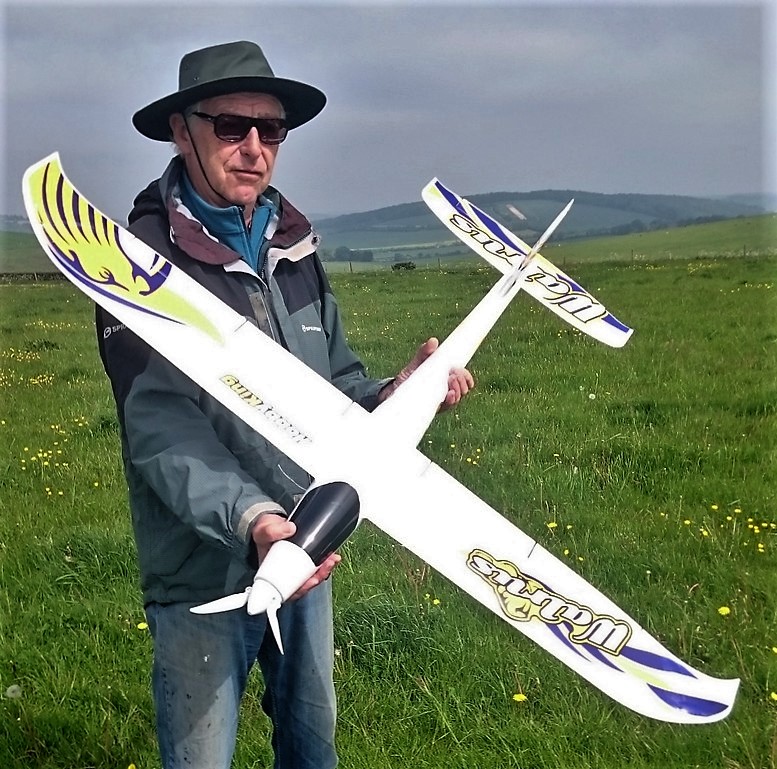 It was rather windy the day Basher brought it along and he wisely declined not to risk a first flight but the reports on the website are good and I’m sure it will be a good performer.
It was rather windy the day Basher brought it along and he wisely declined not to risk a first flight but the reports on the website are good and I’m sure it will be a good performer.
We didn’t see a lot of Modelling Clay during May; he said it was something to do with getting married next month, what a pathetic excuse! But he did turn up with a new model on one occasion, an Extra 260P from HobbyKing that was yet another large raffle prize.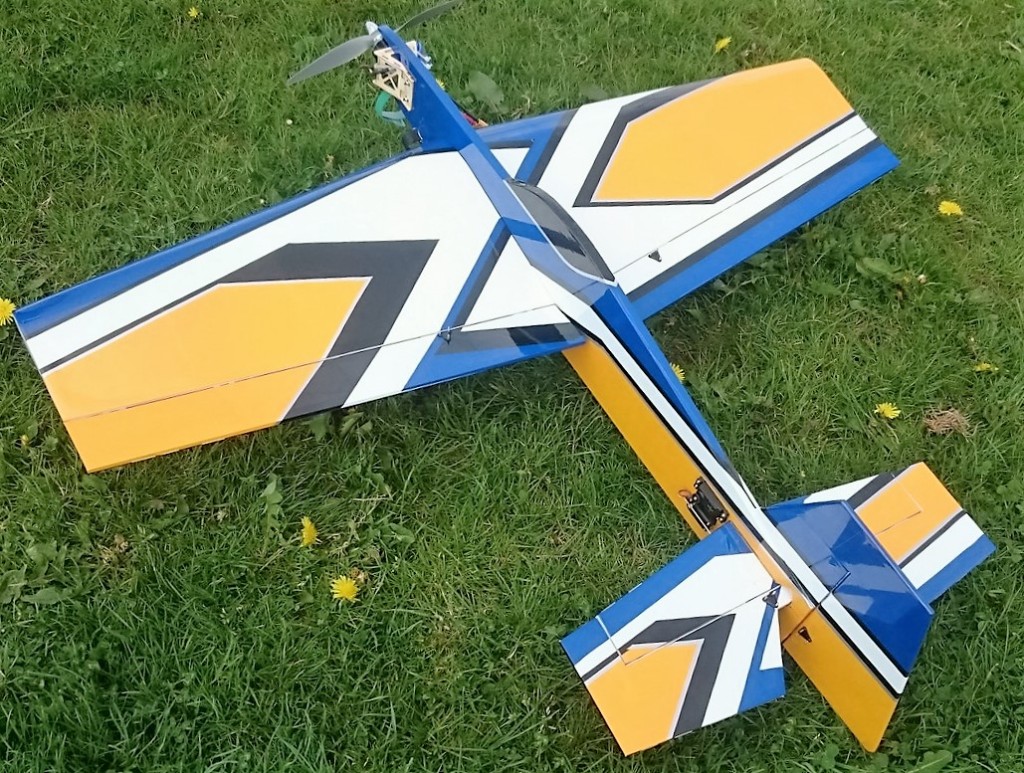 It’s a 1220mm span profile 3D machine that comes as an ARF, so requires a motor, esc, 4 servos, and a 4 cell lipo of around 3000mAh capacity. Modelling fitted an NTM Prop Drive 4238 750kv motor which seemed to give it plenty of performance.
It’s a 1220mm span profile 3D machine that comes as an ARF, so requires a motor, esc, 4 servos, and a 4 cell lipo of around 3000mAh capacity. Modelling fitted an NTM Prop Drive 4238 750kv motor which seemed to give it plenty of performance.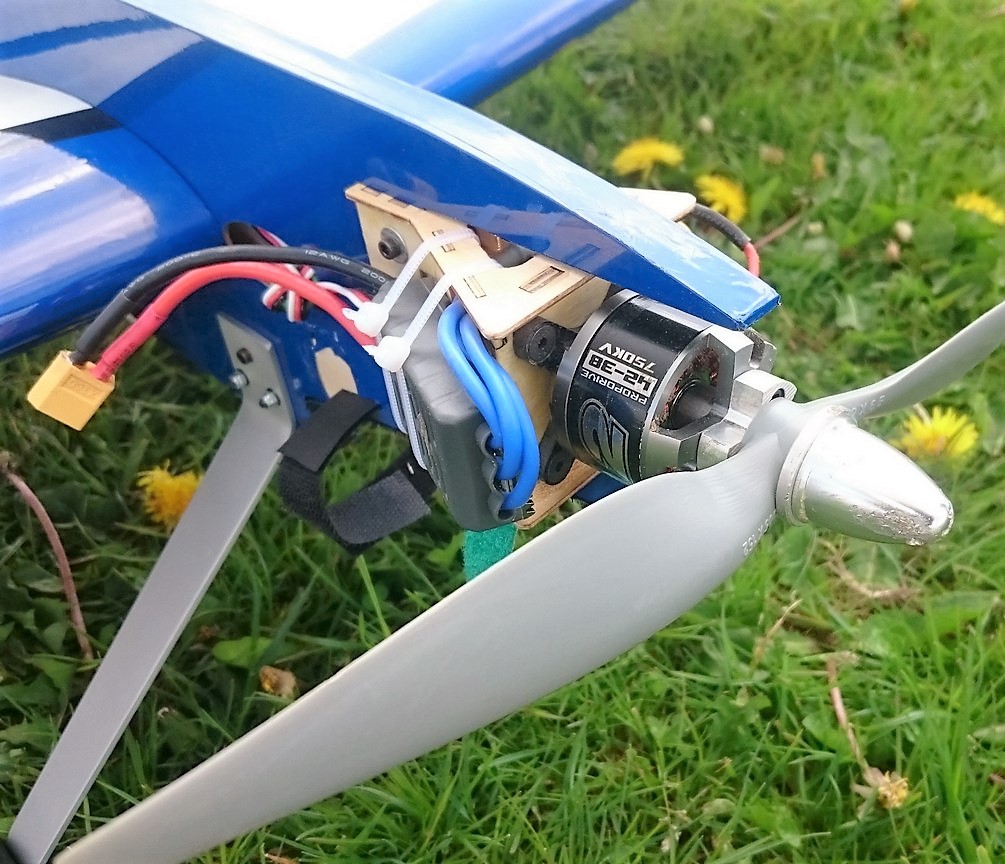 I can’t say it looks anything like an Extra and is unusual these days in that it’s not a foamie, it’s actually has a built up wooden structure and is film covered is a very eye catching colour scheme.
I can’t say it looks anything like an Extra and is unusual these days in that it’s not a foamie, it’s actually has a built up wooden structure and is film covered is a very eye catching colour scheme.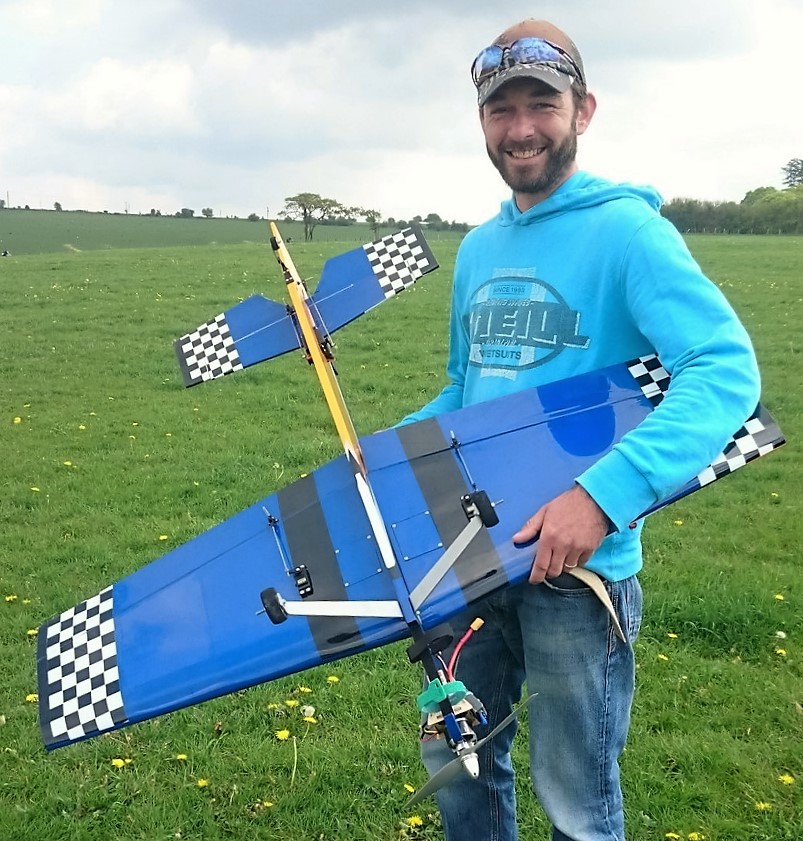 It appeared to fly very well when 1066 test flew it and he was soon performing all kinds of 3D manoeuvres. Some of the first flight can be seen in this month’s video.
It appeared to fly very well when 1066 test flew it and he was soon performing all kinds of 3D manoeuvres. Some of the first flight can be seen in this month’s video.
Amazingly Captain Slow finished not one but two new models this month although we are still awaiting the appearance of the much talked about auto gyro. The first to appear was his Extreme 3D, another one from HobbyKing. I managed to snap a decent photo of Captain Slow at last!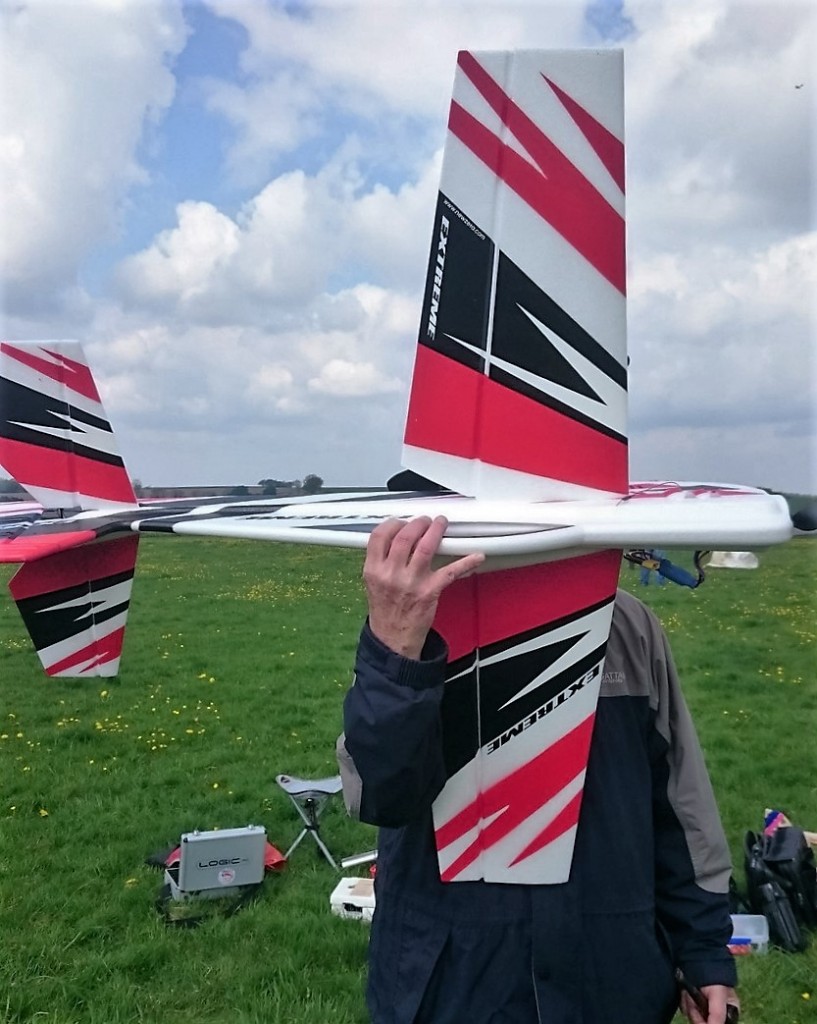 This one is fully moulded in EPO, is 1100mm span, and it’s Plug’N’Fly so you just need to add a receiver and battery. It is fitted with a 2814 1100kv motor connected to a 40A speed controller, and there are four metal geared digital servos already installed. The recommended battery is a 3s lipo with a capacity of 1500-2200mAh. Although it’s described as a profile model the fuselage does actually have a bit of shape to it and the esc and battery fit inside behind a hatch on the side.
This one is fully moulded in EPO, is 1100mm span, and it’s Plug’N’Fly so you just need to add a receiver and battery. It is fitted with a 2814 1100kv motor connected to a 40A speed controller, and there are four metal geared digital servos already installed. The recommended battery is a 3s lipo with a capacity of 1500-2200mAh. Although it’s described as a profile model the fuselage does actually have a bit of shape to it and the esc and battery fit inside behind a hatch on the side.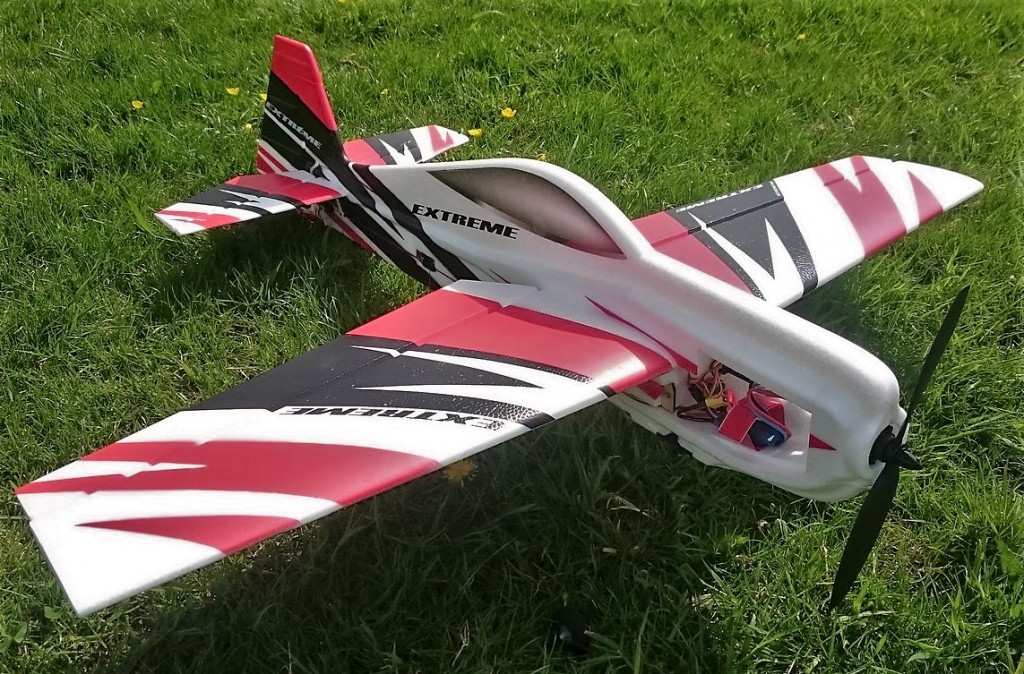
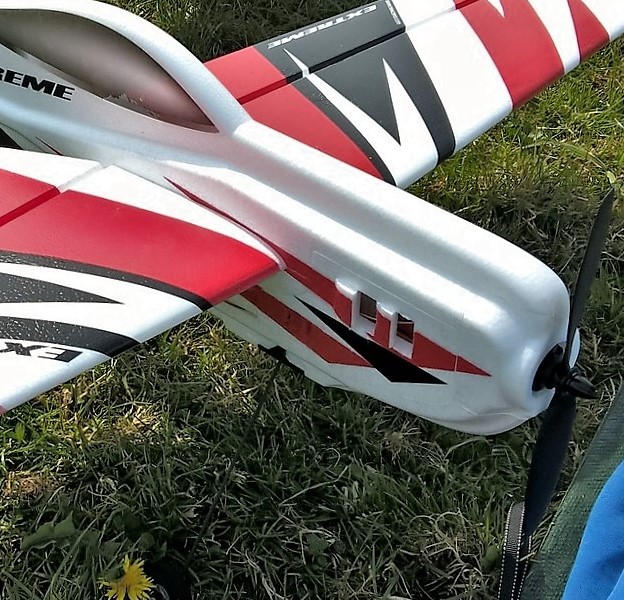 To my mind it’s much prettier than the usual completely slab sided models. There are carbon reinforcing rods in the wings and tail to ensure the structure is stiff enough for those stomach churning 3D moments. Side force generators are included but Captain Slow hasn’t got them fitted at the moment.
To my mind it’s much prettier than the usual completely slab sided models. There are carbon reinforcing rods in the wings and tail to ensure the structure is stiff enough for those stomach churning 3D moments. Side force generators are included but Captain Slow hasn’t got them fitted at the moment.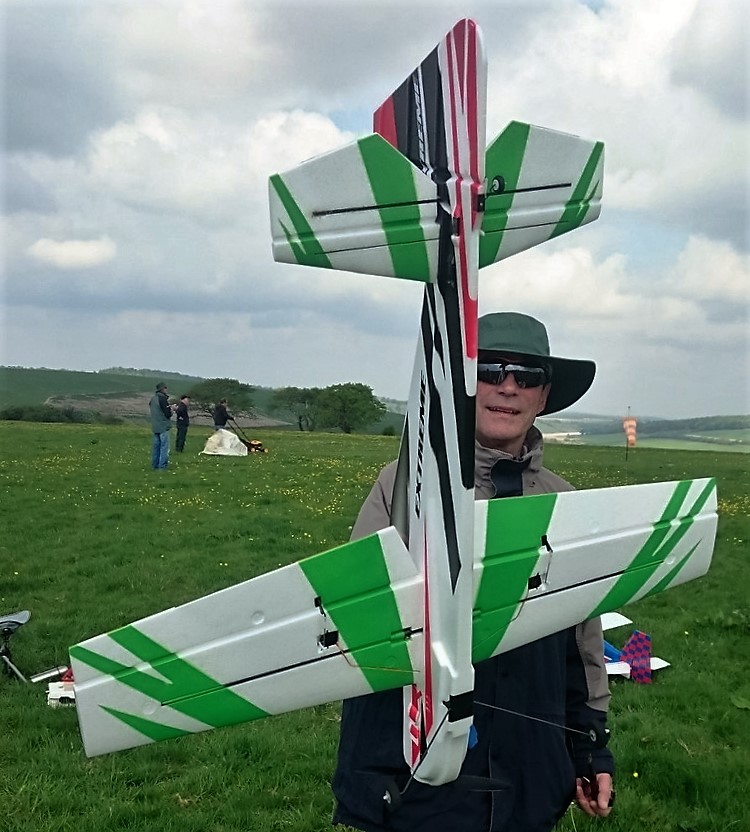 The colour scheme is painted on and, with the topside being red/black and the underside being green, there is a great contrast which shows up well in the air. How does it fly? Extremely well seems to be the answer, it does all the usual 3D stuff with ease, and will fly nice and slowly when required, perfect for the Captain.
The colour scheme is painted on and, with the topside being red/black and the underside being green, there is a great contrast which shows up well in the air. How does it fly? Extremely well seems to be the answer, it does all the usual 3D stuff with ease, and will fly nice and slowly when required, perfect for the Captain.
His second new model is an Art Tech Diamond 1100 that came from Sussex Model Centre.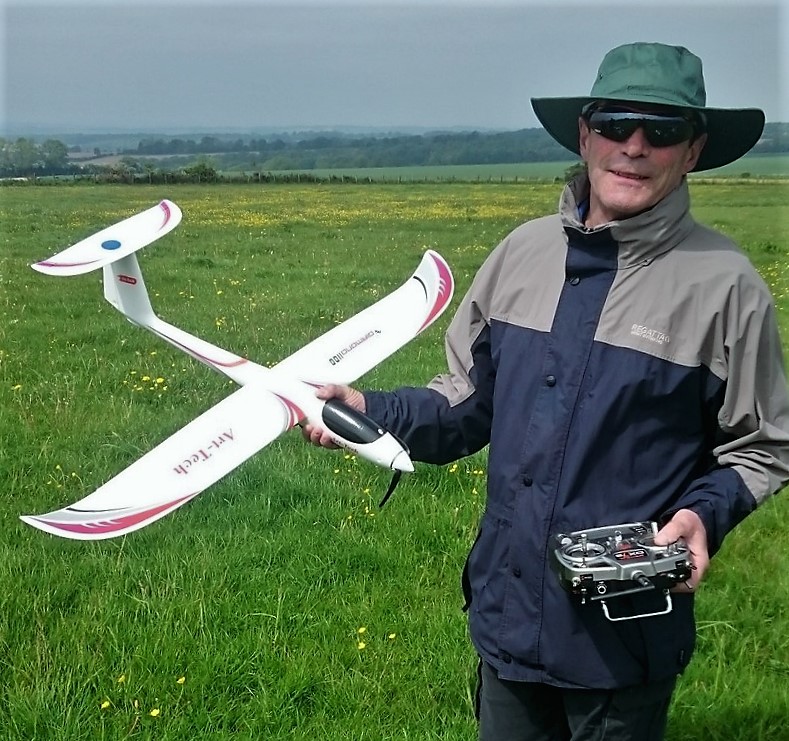 It looks very much like a larger version of the 815mm span Spirit/Kinetic mini gliders that have proved so popular, the most obvious difference, apart from the 1100mm span, is that the Diamond has a T tail.
It looks very much like a larger version of the 815mm span Spirit/Kinetic mini gliders that have proved so popular, the most obvious difference, apart from the 1100mm span, is that the Diamond has a T tail.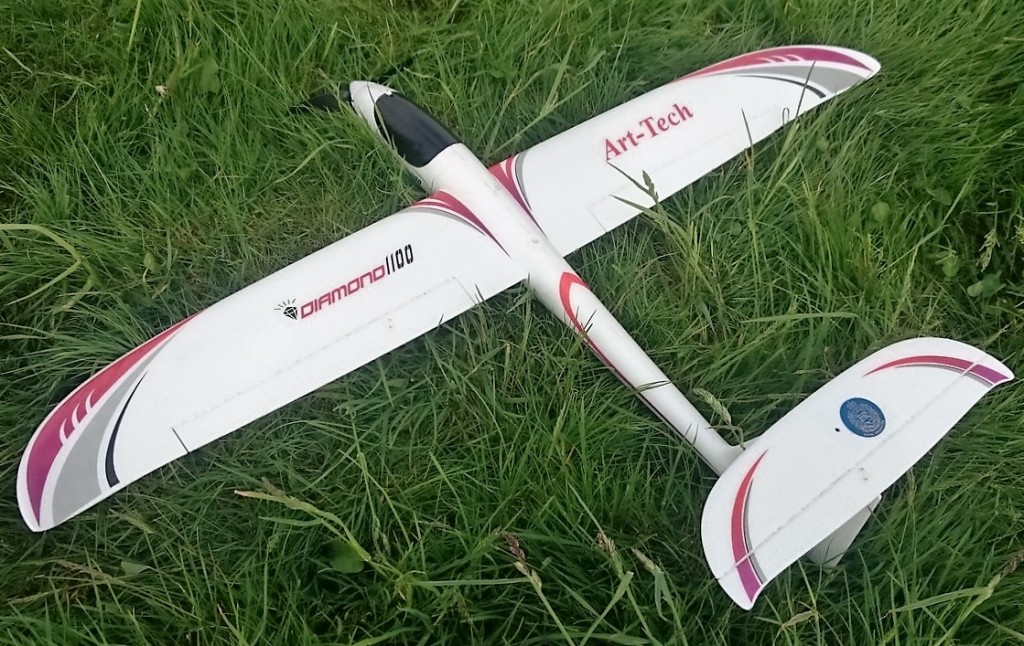 Captain Slow reports that it flies very similarly to the Spirit but being that bit bigger means it’s not so easy to lose sight of or mistake for a different model. Now what sort of idiot would do that…ahem…
Captain Slow reports that it flies very similarly to the Spirit but being that bit bigger means it’s not so easy to lose sight of or mistake for a different model. Now what sort of idiot would do that…ahem…
Last month I included a photo of 1066’s Piper Cub with its rudder hanging off, damage he inflicted whilst assembling the brand new model. The model has now flown and Steve has managed to do a bit more damage to it! When he turned up at the patch with it there was a lot of muttering and the general consensus of opinion was “Why on earth has 1066 got a Cub?” We are so used to him always flying 3D machines that a Cub just didn’t seem right, but 1066 confessed to having a weakness for them.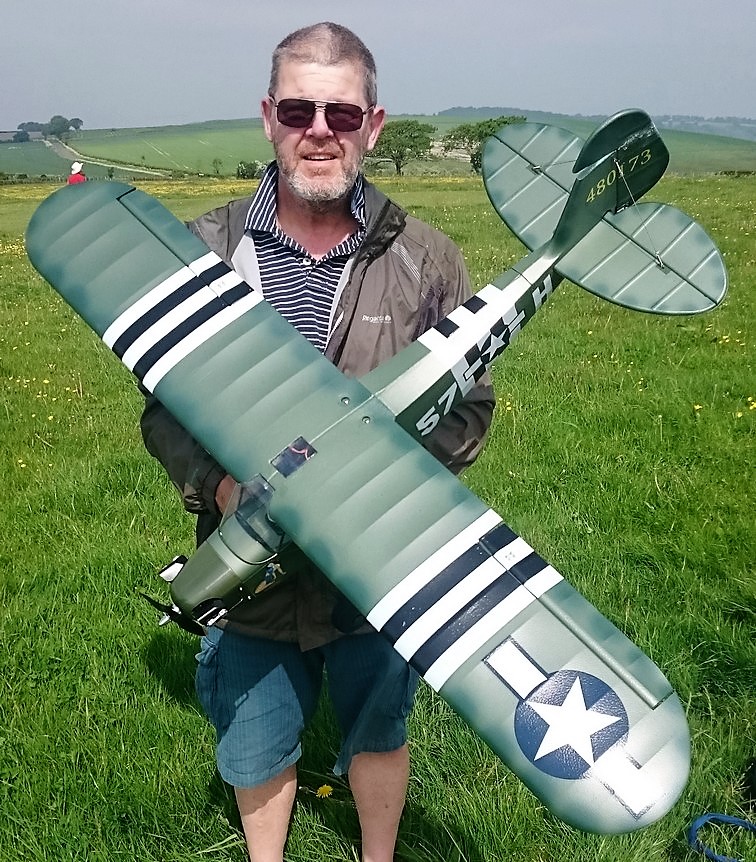 To be totally correct it’s actually a Piper L-4 Grasshopper, the military version of the Cub, but basically the same thing. This one is another from HobbyKing and is 1400mm span, fully moulded in EPO, and comes complete with a 3648 700kv motor, 45A esc, and four 9g servos.
To be totally correct it’s actually a Piper L-4 Grasshopper, the military version of the Cub, but basically the same thing. This one is another from HobbyKing and is 1400mm span, fully moulded in EPO, and comes complete with a 3648 700kv motor, 45A esc, and four 9g servos.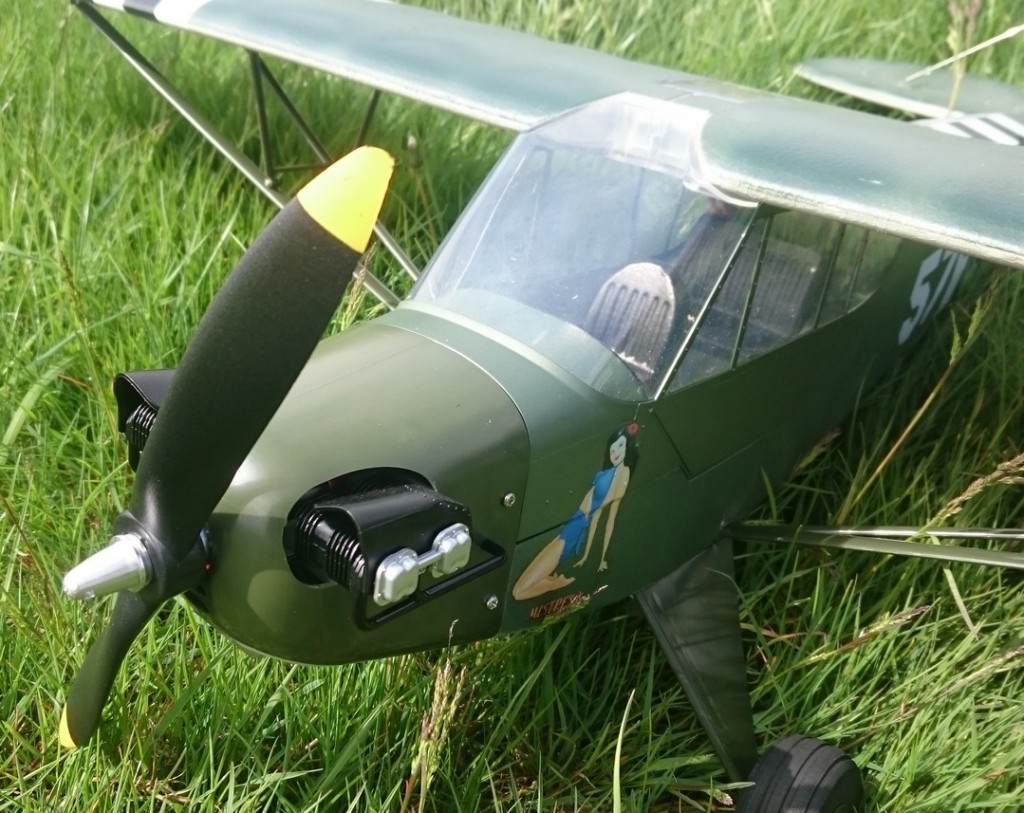 I was surprised to see that it uses a 4s lipo, I’m sure it would fly on a 3 cell pack, but having watched it flying I could see it had loads of power with 4 cells. Steve was really wringing the thing out and doing all kinds of very un-scale aerobatics with it so I would imagine that if you just want to cruise gently around in a scale like manner 3 cells would be fine. I watched it land and although it wasn’t perfect it was pretty good but the undercarriage failed. On closer examination the undercarriage wire just pushes into a slot and the moulded plastic fairings are retained by one small screw on each side, so on anything less than a perfect landing on tarmac the wire pulls out of the slot and the plastic fairings either snap or rip out the screws. Not ideal. Speaking to 1066 about it he was fairly scathing about the model in general, saying that it was a rubbish ‘kit’.
I was surprised to see that it uses a 4s lipo, I’m sure it would fly on a 3 cell pack, but having watched it flying I could see it had loads of power with 4 cells. Steve was really wringing the thing out and doing all kinds of very un-scale aerobatics with it so I would imagine that if you just want to cruise gently around in a scale like manner 3 cells would be fine. I watched it land and although it wasn’t perfect it was pretty good but the undercarriage failed. On closer examination the undercarriage wire just pushes into a slot and the moulded plastic fairings are retained by one small screw on each side, so on anything less than a perfect landing on tarmac the wire pulls out of the slot and the plastic fairings either snap or rip out the screws. Not ideal. Speaking to 1066 about it he was fairly scathing about the model in general, saying that it was a rubbish ‘kit’.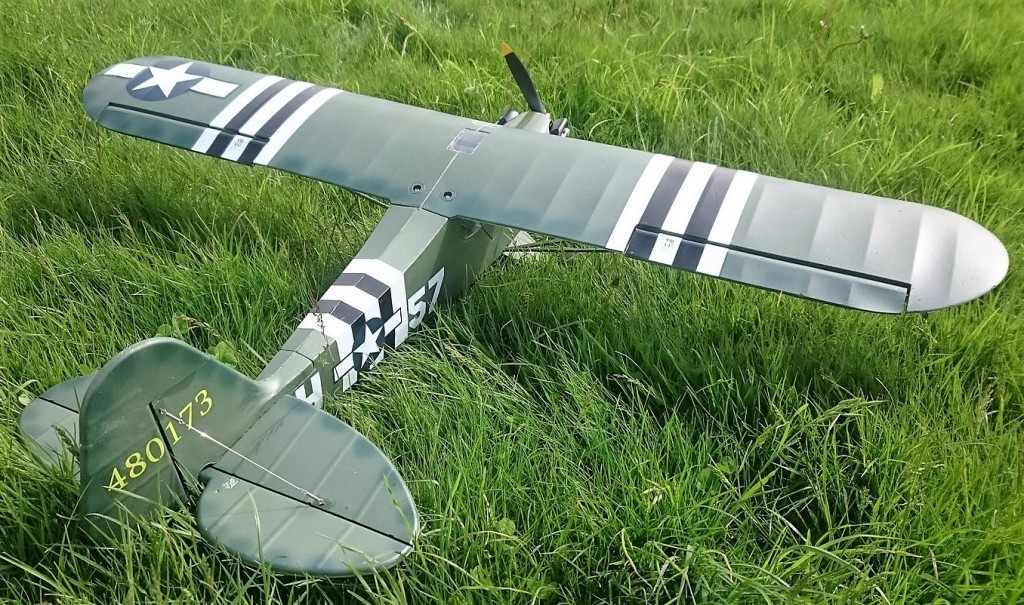 It seems that the completed model looks good (very good I think) but the quality of the fittings just isn’t up to standard and lots of niggling things break all too easily. Some of the comments on the HK website also criticise the weak undercarriage etc. It’s a real shame because I was certainly impressed by the flight performance but maybe if you want to fly in a non-scale manner you’d be better off with a non-scale plane.
It seems that the completed model looks good (very good I think) but the quality of the fittings just isn’t up to standard and lots of niggling things break all too easily. Some of the comments on the HK website also criticise the weak undercarriage etc. It’s a real shame because I was certainly impressed by the flight performance but maybe if you want to fly in a non-scale manner you’d be better off with a non-scale plane.
I don’t have any photos of members shed/modelling rooms this month but I did find one of Dougal Entendre’s charging set-up. Dougal doesn’t believe in parallel charging and instead he uses multiple chargers. Here they all are, safely laid out on the concrete floor of his garage.
Here they all are, safely laid out on the concrete floor of his garage.
While we were down in Cornwall this month we visited the Cornwall Aviation Heritage Centre (CAHC) at Newquay Airport (previously RAF St. Mawgan). On trips to Cornwall in previous years we had visited the Classic Air Force museum at Newquay (see Patch News June 2013) but it closed suddenly last year and all the airworthy aircraft were sold. Some of the static aircraft were handed over to a group of volunteers, most of who had worked for Classic Air Force, and they set about establishing a new museum which has now become the CAHC. The authorities at Newquay Airport were very keen to help and provided the group with a Hardened Aircraft Shelter (HAS) which is now home for many of the exhibits.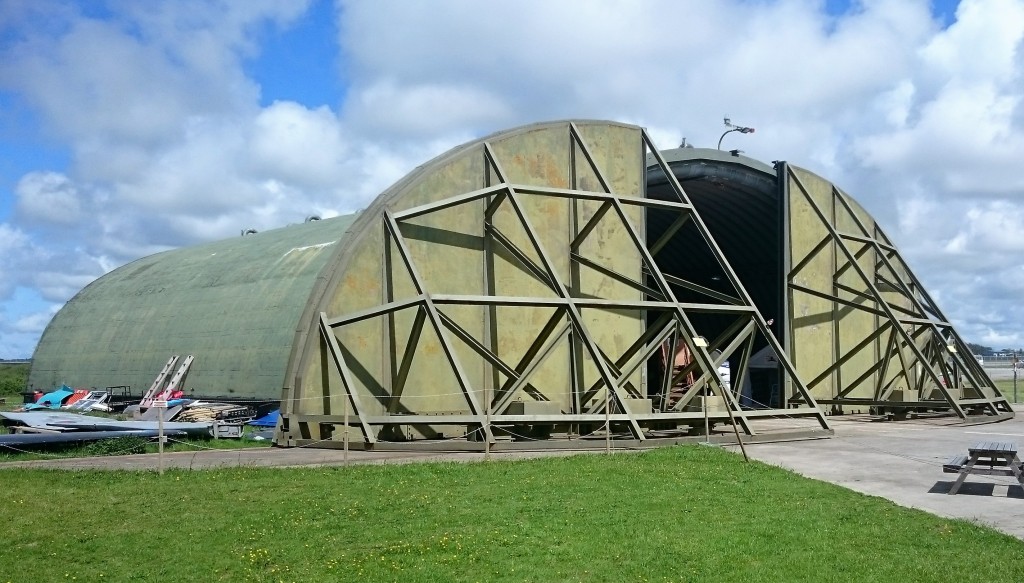 It is relatively small but there are also quite a few aircraft outside, including the two largest two, a BAC1-11 and a VC10. But the thing that sets it aside from other museums is that visitors are actively encouraged to enter virtually all the exhibits, and the enthusiastic volunteers are anxious to share their knowledge and ensure you have a good time. It’s a fantastic place to visit and I urge you to drop in if you are anywhere in the area, entry is just £5 for concessions. Check out the website by CLICKING HERE. I’ll do a separate write-up for the website in the next couple of weeks but in the meantime here are a few photos:
It is relatively small but there are also quite a few aircraft outside, including the two largest two, a BAC1-11 and a VC10. But the thing that sets it aside from other museums is that visitors are actively encouraged to enter virtually all the exhibits, and the enthusiastic volunteers are anxious to share their knowledge and ensure you have a good time. It’s a fantastic place to visit and I urge you to drop in if you are anywhere in the area, entry is just £5 for concessions. Check out the website by CLICKING HERE. I’ll do a separate write-up for the website in the next couple of weeks but in the meantime here are a few photos: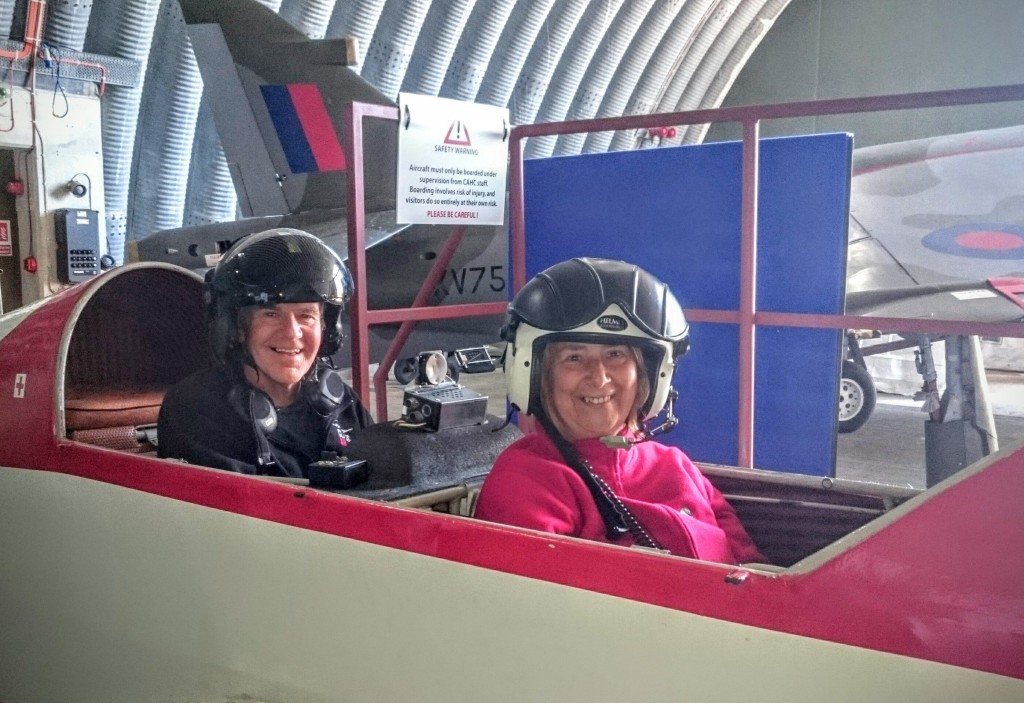
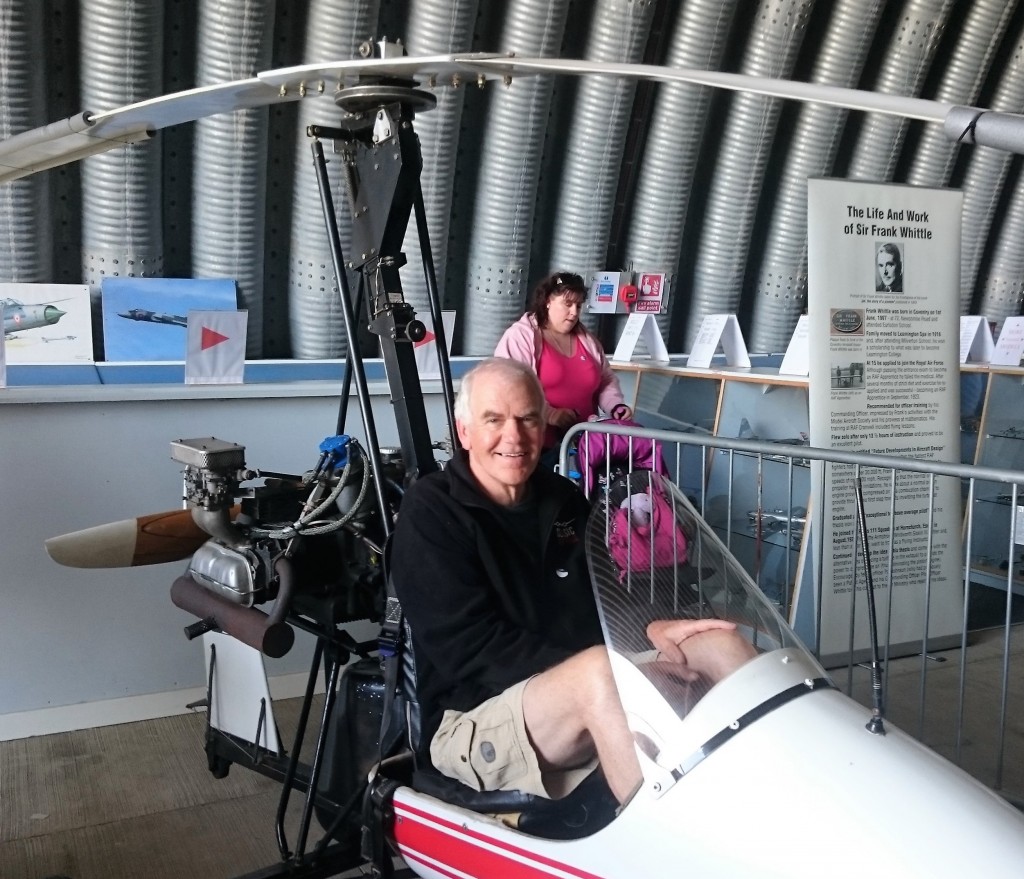
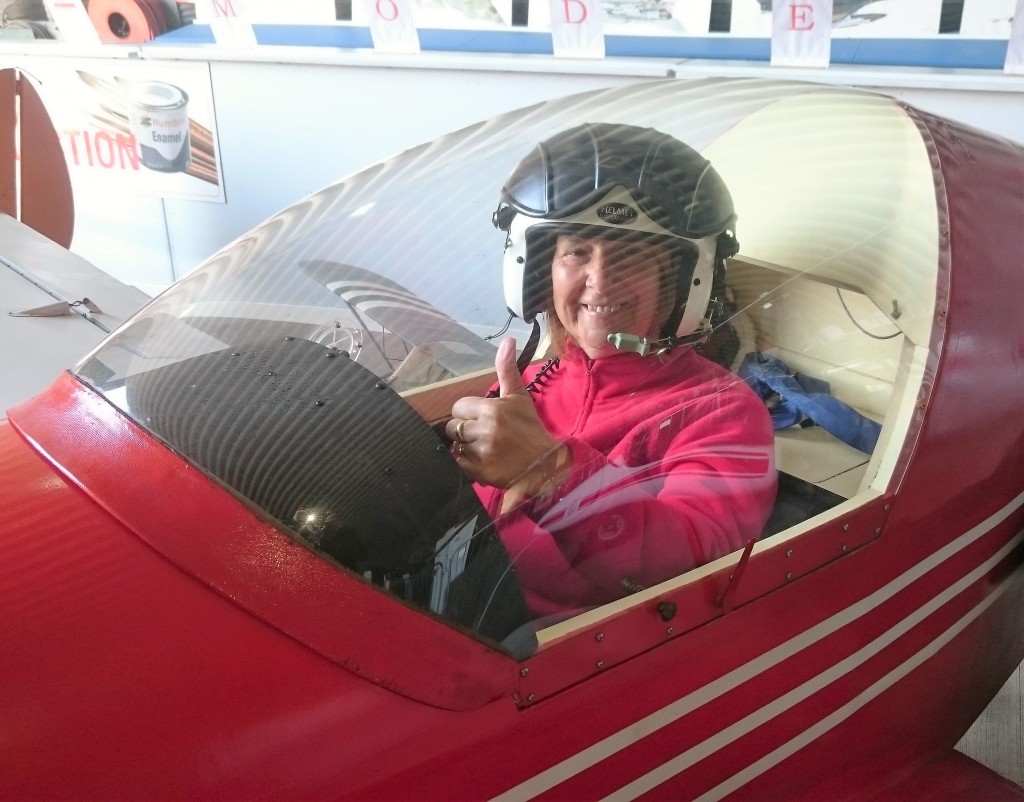
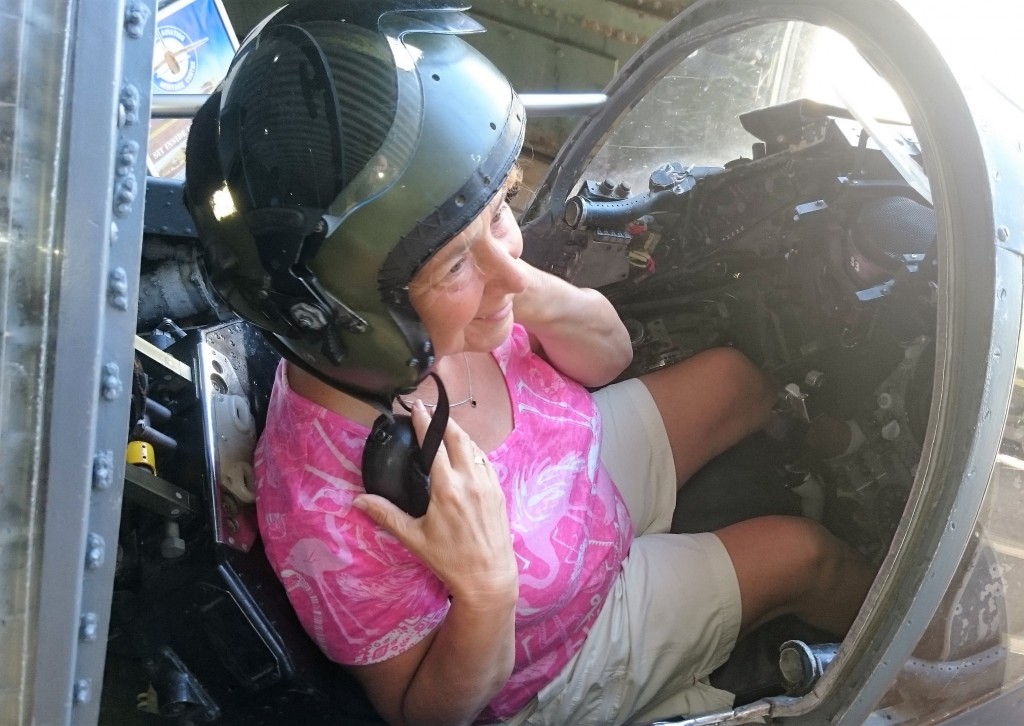
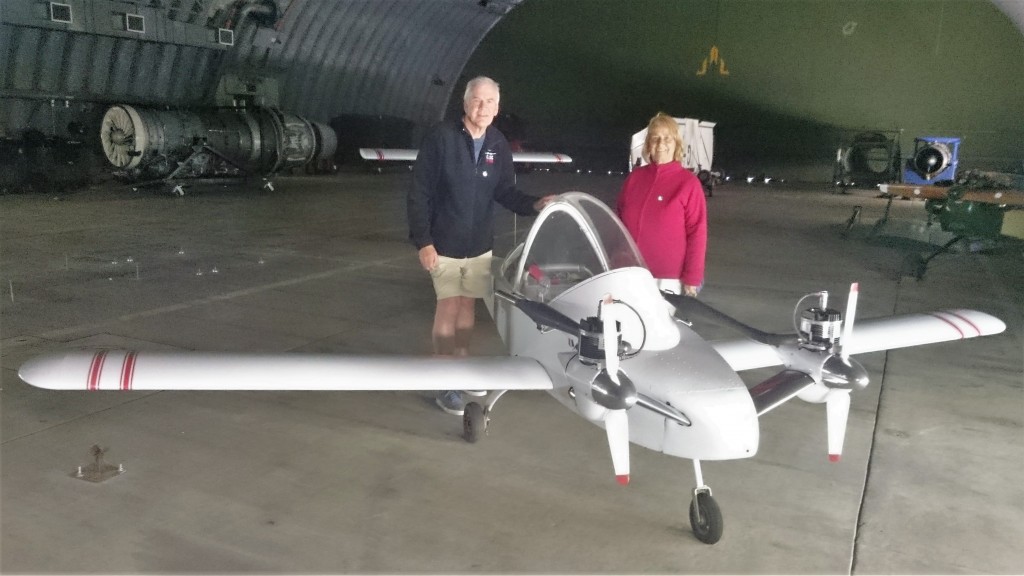
Please watch the video full screen, it’s so much better with small models flying around. If the video above won’t play for you CLICK HERE
A pilot has engine trouble and lands in a field. As he walks around the plane to check out the problem, he hears a voice behind him say “You have a clogged fuel line.”
Looking around, he sees no one, except a cow. Startled out of his wits, he runs across the field to the farmer’s house and pounds on the door. When the farmer appears at the door, the out-of-breath pilot stammers that his cow has just talked, and it even tried to explain what was wrong with the airplane.
The farmer drawled, “Was it a brown cow?” “Yes.” “Did it have a white patch on its forehead?” “Yes, yes, that’s the one.”
“OK, that’s Flossie. Don’t pay any attention to her, she doesn’t know anything about aeroplanes.”
Colin Cowplain

